
Size 15 × 7. Signed Hiroshige, hitsu.
Frontispiece.
Project Gutenberg's Chats on Japanese Prints, by Arthur Davison Ficke This eBook is for the use of anyone anywhere in the United States and most other parts of the world at no cost and with almost no restrictions whatsoever. You may copy it, give it away or re-use it under the terms of the Project Gutenberg License included with this eBook or online at www.gutenberg.org. If you are not located in the United States, you'll have to check the laws of the country where you are located before using this ebook. Title: Chats on Japanese Prints Author: Arthur Davison Ficke Release Date: September 2, 2014 [EBook #46753] Language: English Character set encoding: ISO-8859-1 *** START OF THIS PROJECT GUTENBERG EBOOK CHATS ON JAPANESE PRINTS *** Produced by Susan Skinner and the Online Distributed Proofreading Team at http://www.pgdp.net
BOOKS FOR COLLECTORS
With Frontispieces and many Illustrations.
CHATS ON ENGLISH CHINA.
By Arthur Hayden.
CHATS ON OLD FURNITURE.
By Arthur Hayden.
CHATS ON OLD PRINTS.
(How to collect and value Old Engravings.)
By Arthur Hayden.
CHATS ON COSTUME.
By G. Woolliscroft Rhead.
CHATS ON OLD LACE AND NEEDLEWORK.
By E. L. Lowes.
CHATS ON ORIENTAL CHINA.
By J. F. Blacker.
CHATS ON OLD MINIATURES.
By J. J. Foster, F.S.A.
CHATS ON ENGLISH EARTHENWARE.
(Companion volume to "Chats on English China.")
By Arthur Hayden.
CHATS ON AUTOGRAPHS.
By A. M. Broadley.
CHATS ON PEWTER.
By H. J. L. J. Massé, M.A.
CHATS ON POSTAGE STAMPS.
By Fred. J. Melville.
CHATS ON OLD JEWELLERY AND TRINKETS.
By MacIver Percival.
CHATS ON COTTAGE AND FARMHOUSE FURNITURE.
(Companion volume to "Chats on Old Furniture.")
By Arthur Hayden.
CHATS ON OLD COINS
By Fred. W. Burgess.
CHATS ON OLD COPPER AND BRASS.
By Fred. W. Burgess.
CHATS ON HOUSEHOLD CURIOS.
By Fred. W. Burgess.
CHATS ON OLD SILVER.
By Arthur Hayden.
CHATS ON JAPANESE PRINTS.
By Arthur Davison Ficke.
CHATS ON MILITARY CURIOS.
By Stanley C. Johnson.
CHATS ON OLD CLOCKS AND WATCHES.
By Arthur Hayden.
CHATS ON ROYAL COPENHAGEN PORCELAIN.
By Arthur Hayden.
CHATS ON OLD SHEFFIELD PLATE.
(Companion volume to "Chats on Old Silver.")
By Arthur Hayden.
BYE PATHS OF CURIO COLLECTING.
By Arthur Hayden.
With Frontispiece and 72 Full page Illustrations. 9s. net.
LONDON: T. FISHER UNWIN, LTD.
NEW YORK: F. A. STOKES COMPANY.
Chats on
Japanese Prints
BY
ARTHUR DAVISON FICKE
WITH 56 ILLUSTRATIONS AND A COLOURED FRONTISPIECE
T. FISHER UNWIN LTD
LONDON: ADELPHI TERRACE
First published in 1915
Second Impression, 1916
Third Impression, 1917
Fourth Impression, 1922
(All rights reserved)
TO
FREDERICK WILLIAM GOOKIN
AND
HOWARD MANSFIELD
CUSTODIANS, APPRAISERS, AND LOVERS OF BEAUTY
For assistance of many kinds in preparing this book the thanks of the author are gratefully offered to Mr. Frederick William Gookin, Mr. Howard Mansfield, Mr. William S. Spaulding, Mr. John T. Spaulding, Mr. Judson D. Metzgar, Mr. Charles H. Chandler, Mr. John Stewart Happer, Col. Henry Appleton, Mrs. Arthur Aldis, Mr. Ernest Oberholtzer, and Mr. Charles August Ficke. Though many obligations must perforce go unacknowledged, it would be improper to fail to state indebtedness to the writings of Von Seidlitz, Bing, Huish, Anderson, Strange, Binyon, Gookin, Kurth, Morrison, Happer, Koechlin, Vignier, Succo, Field, De Goncourt, Okakura, Edmunds, Perzynski, Wright, Fenollosa, and De Becker.
Many collectors have kindly allowed their prints to be used for illustration in this book. That all the examples are from American collections is due to considerations of convenience, not to any notion of their superiority. All prints not credited to another owner are from the collection of the author. The other collections from which illustrations are drawn are as follows:—
Four of the poems herein printed appeared first in The Little Review. A number of the others are from the author's book "Twelve Japanese Painters." Most of the photographs here reproduced were prepared by Mr. J. H. Paarman, Miss Sarah G. Foote-Sheldon, and Mr. J. D. Metzgar.
Davenport, Iowa, U.S.A.{13}
| PAGE | ||
| PREFACE | 11 | |
| GLOSSARY | 19 | |
| CHAPTER | ||
| I. | PRELIMINARY SURVEY | 23 |
| II. | CONDITIONS PRECEDING THE RISE OF PRINT DESIGNING | 47 |
| III. | THE FIRST PERIOD: THE PRIMITIVES | 61 |
| IV. | THE SECOND PERIOD: THE EARLY POLYCHROME MASTERS | 125 |
| V. | THE THIRD PERIOD: KIYONAGA AND HIS FOLLOWERS | 205 |
| VI. | THE FOURTH PERIOD: THE DECADENCE | 255 |
| VII. | THE FIFTH PERIOD: THE DOWNFALL | 347 |
| VIII. | THE COLLECTOR | 401 |
| INDEX | 449 | |
| Hiroshige: The Bow-moon | Frontispiece | |
| PLATE | PAGE | |
| 1. | Moronobu: A Pair of Lovers | 71 |
| 2. | Sukenobu: A Young Courtesan | 77 |
| 3. | Kwaigetsudō: Courtesan arranging her Coiffure (Spaulding Collection) | 81 |
| 4. | Okumura Masanobu: Courtesans at Toilet | 93 |
| 5. | Okumura Masanobu: Standing Woman | 97 |
| 6. | Okumura Masanobu: Young Nobleman Playing the Drum (Chandler Collection) | 101 |
| 7. | Toyonobu: Two Komuso, represented by the Actors Sanokawa Ichimatsu and Onoye Kikugoro (Chandler Collection) | 109 |
| 8. | Toyonobu: Girl opening an Umbrella (Metzgar Collection) | 113 |
| Toyonobu: Woman dressing | 113 | |
| 9. | Kiyomitsu: The Actor Segawa Kikunojo as a Woman smoking | 117 |
| 10. | Kiyomitsu: Woman with Basket Hat | 121 |
| Kiyomitsu: Woman coming from Bath | 121 | |
| 11. | Harunobu: Young Girl in Wind (Gookin Collection) | 137 |
| 12. | Harunobu: Lady talking with Fan-vendor {16}(Chandler Collection) | 141 |
| 13. | Harunobu: Girl viewing Moon and Blossoms (Chandler Collection) | 145 |
| 14. | Harunobu: Courtesan detaining a passing Samurai | 149 |
| 15. | Harunobu: Shirai Gompachi disguised as a Komuso | 153 |
| Harunobu: Girl playing with Kitten | 153 | |
| 16. | Koriusai: Mother and Boy | 161 |
| Koriusai: Two Lovers in the Fields; Spring Cuckoo | 161 | |
| 17. | Koriusai: Two Ladies | 165 |
| Koriusai: A Game of Tag | 165 | |
| 18. | Shigemasa: Two Ladies | 169 |
| Koriusai: A Courtesan | 169 | |
| 19. | Shunsho: An Actor of the Ishikawa School in tragic rôle | 175 |
| 20. | Shunsho: The Actor Nakamura Matsuye as a Woman in White | 179 |
| 21. | Shunsho: The Actor Nakamura Noshio in Female rôle (Gookin Collection) | 183 |
| 22. | Buncho: Courtesan and her Attendant in Snowstorm (Mansfield Collection) | 187 |
| 23. | Shunyei: An Actor | 191 |
| 24. | Shunko: The Actor Ishikawa Monnosuke in Character | 195 |
| 25. | Kiyonaga: The Courtesan Hana-ōji with Attendants | 211 |
| 26. | Kiyonaga: Lady with two Attendants (Gookin Collection) | 215 |
| 27. | Kiyonaga: The Courtesan Shizuka with Attendants in the Peony Garden at Asakusa | 219 |
| 28. | Kiyonaga: Two Women and a Tea-house Waitress beside the Sumida River (Gookin {17}Collection) | 223 |
| 29. | Kiyonaga: Yoshitsune Serenading the Lady Jorurihime (Spaulding Collection) | 227 |
| 30. | Kiyonaga: Geisha with Servant carrying Lute-box | 231 |
| Kiyonaga: Woman painting her Eyebrows | 231 | |
| 31. | Shuncho: Group at a Temple Gate (Mansfield Collection) | 235 |
| 32. | Shuncho: Two Ladies under Umbrella | 239 |
| Shuncho: The Courtesan Hana-ōji; the Sumida River seen through the Window | 239 | |
| 33. | Shuncho: Two Ladies in a Boat on the Sumida River | 243 |
| Yeisho: Two Courtesans after the Bath | 243 | |
| 34. | Kitao Masanobu: The Cuckoo (Spaulding Collection) | 251 |
| 35. | Yeishi: Three Ladies by the Seashore | 267 |
| 36. | Yeishi: Lady with Tobacco-pipe | 271 |
| 37. | Yeishi: Interior opening on to the Seashore (Metzgar Collection) | 275 |
| 38. | Utamaro: Okita of Naniwaya, a Tea-house Waitress (Chandler Collection) | 283 |
| 39. | Utamaro: Two Courtesans | 287 |
| 40. | Utamaro: Woman Seated on a Veranda | 291 |
| 41. | Utamaro: A Youthful Prince and Ladies | 295 |
| 42. | Sharaku: The Actor Arashi Ryuzō in the rôle of one of the Forty-seven Ronin (Spaulding Collection) | 301 |
| 43. | Sharaku: The Actor Ishikawa Danjuro in the rôle of Moronao | 309 |
| 44. | Sharaku: The Actor Kosagawa Tsuneyo as a Woman in the Drama of the Forty-seven Ronin (Ainsworth Collection) | 313 |
| 45. | Choki: Courtesan and Attendant | 321 |
| {18}Shunman: Two Ladies under a Maple-tree | 321 | |
| 46. | Choki: A Courtesan and her Lover | 325 |
| Choki: A Geisha and her Servant carrying Lute-box | 325 | |
| 47. | Toyokuni: Ladies and Cherry Blossoms in the Wind (Metzgar Collection) | 333 |
| 48. | Toyohiro: A Daimyo's kite-party | 341 |
| 49. | Hokusai: Fuji, seen across the Tama River, Province of Musashi | 361 |
| 50. | Hokusai: Fuji, seen from the Pass of Mishima, Province of Kahi | 367 |
| 51. | Hokusai: The Monkey Bridge; Twilight and Rising Moon | 371 |
| 52. | Hiroshige: Homing Geese at Katada; Twilight | 377 |
| 53. | Hiroshige: The Seven Ri Ferry, Kuwana, at the Mouth of the Kiso River; Sunset | 383 |
| 54. | Hiroshige: The Village of the Fuji Kawa; Evening Snow | 387 |
| 55. | Hiroshige: The Ommaya Embankment, on the Sumida River at Asakusa; Evening | 391 |
| 56. | Hiroshige: Bird and Flowers | 395 |
Beni.—A delicate pink or red pigment of vegetable origin.
Beni-ye.—A print in which beni is the chief colour used. The term is generally employed to describe all those two-colour prints which immediately preceded the invention of polychrome printing.
Chuban.—A vertical print, size about 11 × 8, sometimes called the "medium size" sheet.
Diptych.—A composition consisting of two sheets.
Gauffrage.—Printing by pressure alone, without the use of a pigment, producing an embossed effect on the paper.
Hashira-ye.—A very tall narrow print, size about 28 × 5, used to hang on the wooden pillars of a Japanese house; a pillar-print.
Hashirakake.—See hashira-ye.
Hoso-ye.—A small vertical print, size about 12 × 6.
Kakemono.—A painting mounted on a margin of brocade; hung by its top when in use, and rolled up when not in use.{20}
Kakemono-ye.—A very tall wide print, size about 28 × 10.
Key-block.—The engraved wooden plate from which the black outlines of the print were produced.
Kira-ye.—A print with mica background.
Koban.—A vertical print slightly smaller than the Chuban (q.v.).
Kurenai-ye.—A hand-coloured print in which beni is chiefly used.
Mon.—The heraldic insignia used by actors and others as coat-of-arms; generally worn on their sleeves.
Nagaye.—See hashira-ye.
Nishiki-ye.—Brocade picture—a term used at first to describe the brilliant colour-inventions of Harunobu, but now loosely applied to all polychrome prints.
Oban.—A large vertical print, about 15 × 10—the normal full-size upright sheet.
Otsu-ye.—A rough broadsheet painting, of small size, on paper; the precursor of the print.
Pentaptych.—A composition consisting of five sheets.
Pillar-print.—See hashira-ye.
Sumi.—Black Chinese ink.
Sumi-ye.—A print in black and white only.
Surimono.—A print, generally of small size and on thick soft paper, intended as a festival greeting or memento of some social occasion.{21}
Tan.—A brick-red or orange colour, consisting of red oxide of lead.
Tan-ye.—A print in which tan is the only or chief colour used. Such prints, in which the tan was applied by hand, were among the earliest productions.
Triptych.—A composition consisting of three sheets.
Uchiwa-ye.—A print in the shape of a fan.
Urushi.—Lacquer.
Urushi-ye.—A print in which lacquer is used to heighten the colour. The term is generally employed to describe only the early hand-coloured prints in which lacquer, colours, and metallic dust were applied to the printed black outline.
Yokoye.—A large horizontal print, about 10 × 15—the normal full-size landscape sheet.
I
PRELIMINARY
SURVEY
THE GENERAL NATURE
OF JAPANESE PRINTS
GROWTH OF INTEREST
IN THEM
THE TECHNIQUE OF
THEIR PRODUCTION
THEIR ÆSTHETIC
CHARACTERISTICS
The general nature of Japanese prints—Growth of interest in them—The technique of their production—Their æsthetic characteristics.
That sublimated pleasure which is the seal of all the arts reaches its purest condition when evoked by a work in which the æsthetic quality is not too closely mingled with the every-day human. Poetry, because of its close human ties, is to a certain extent a corrupt art; its medium is that base speech which we use for communicating information, and few are the readers whose minds can absolve words from the work-a-day obligation of conveying, first of all, mere tidings. Music, on the other hand, employing a medium wholly sacred to its own uses, starts with no such handicap; its succession of notes awakens in the listener no expectation of an eventual body of facts to carry home. Between the two extremes lie the graphic arts. These are perhaps most fortunate when they deal with material not familiar to the spectator, for it is then that he most readily accepts them as designs and harmonies, without looking to them for a literal record of things only too well known to him.{26}
The graphic art of an alien race has therefore an initial strength of purely æsthetic appeal that a native art often lacks. It moves free from the demands with which unconsciously we approach the art of our own people. It stands as an undiscovered world, of which nothing can logically be expected. The spectator who turns to it at all must come prepared to take it on its own terms. If it allures him, it will do so by virtue of those qualities of harmony, rhythm, and vision which in these strange surroundings are more perceptible to him than in the art of his own race, where so many adventitious associations operate to distract him. Like a man whom Mayfair bewilders with its fashions, he may find that fundamental verity, that humanity which he seeks only among the Gipsy beggars.
Perhaps this theory best explains the impulse that has of late led many lovers of beauty to turn to the arts of Persia, China, and Japan for their keenest pleasure. Here, in unfamiliar environment, the fundamental powers of design stand forth free. Here the beautiful is discoverable for its own sake, liberated from the oppression of utility.
Toward Japan this impulse has in our own day been strongly directed. The handicrafts of the Japanese people have charmed the Western world, possibly to an undue extent. On the other hand, the great classical schools of Japanese painting have unfortunately been difficult of access. But between the two, half craft and half art, lies the Japanese colour-print—a finer product than mere dexterous artizan work, and more accessible than the paintings{27} of the classic masters. In the print many a Western mind has found its clearest intimation of the universal principles of beauty.
During a period of a little more than a hundred years, roughly delimited by 1742 and 1858, there were produced in Japan large numbers of wood-engravings, printed in colours; these have of late come to occupy an almost unique place in the esteem of European art-lovers. So great is the importance now attached to these works that the Japanese public of earlier days, for whose delectation they were designed, would be astounded could they witness it. Just as obscure Greek potters moulded for common use vases that are to-day treasured in the museums as paradigms of beauty, so the coloured broadsheets, whose immediate purpose was to give pleasure to the crowds of the Japanese capital, have taken in the course of years a distinguished rank among the beautiful things of all time.
The day is passing when the love of these sheets can be looked upon as the badge of a cult, the secret delight of far-searching worshippers of the strange and exotic. Even did the collector desire, he could not long hide this light under a bushel; and the Japanese print is swiftly becoming a general treasure. This is proper and natural. An understanding of the origin of this form of art makes its present popularity in Europe seem like the felicitous rounding of a circle begun on the other side of the world.
It was in Yedo, the teeming capital of Japan, that the art of the colour-print flourished; and the patron sought by the artists was primarily the common man.{28} No art more purely national or more definitely popular and exoterical in its inception has ever existed. The subjects of the prints are alone enough to make this fact evident. In them appear the forms and faces of the popular actors in their admired rôles, fashionable courtesans decked in all the splendour of their unhappy but far-famed days and nights, legendary heroes, dancers, wrestlers, and popular entertainers. In the matter of landscape, the scenes shown are the festival-crowded temples of Yedo, the sunlit tea-gardens and gay midnight boating-parties of the Sumida River, the great highroads of national travel, the famous spots of popular recreation. Only rarely are there episodes from aristocratic life; and the occasional occurrence of these has precisely the significance of a photograph of a royal house-party shown in a penny paper. The Yoshiwara, as the licensed quarter of Yedo is called, appears in these prints more often than do the garden-parties of noble ladies; the vulgar theatre is shown, but not the classic Nō drama of the aristocracy; it is a Japanese Montmartre, not a Japanese Faubourg St. Germain, that is revealed. The artist's sense of beauty subdues these riotous pleasures of the populace to the severe demands of a beautiful pattern; but it is a whimsical vulgar world, a world of the people, a world of passing gaiety, that he portrays.
The purposes of these pictures were various. "To some extent," says Mr. Frederick W. Gookin, "they were used as advertisements. Incidentally they served as fashion plates. Some were regularly published{29} and sold in shops. Others were designed expressly upon orders from patrons, to whom the entire edition, sometimes a very small one, was delivered. The number struck from any block or set of blocks varied widely. Of the more popular prints many editions were printed, each one, as might be expected, inferior to those that preceded it.... Most of the prints were sold at the time of publication for a few sen. The finer ones brought relatively higher prices, and such prints as the great triptychs and still larger compositions by Kiyonaga, Yeishi, Toyokuni, Utamaro, and other leading artists could never have been very cheap. In general, however, the price was small, and they were regarded as ephemeral things. Many were used to ornament the small screens that served to protect kitchen fires from the wind, and in this use were inevitably soiled and browned by smoke. Others, mounted upon the sliding partitions of the houses, perished in the fires by which the Japanese cities have been devastated; or, if in houses that chanced safely to run the gauntlet of fires, typhoons, cloudbursts, and other mishaps, their colours faded, and their surfaces were rubbed until little more than dim outlines were left."
The plebeian origin of the prints explains why the cultivated Japanese have not, as a rule, looked upon them with much enthusiasm. Only now, when the greatest print treasures have gone out of Japan, are a few Japanese collectors beginning to buy back at high prices works which they allowed to leave the country for a song. The admiration of Europe and America has awakened them to a realization of the{30} distinction of the prints, in spite of the undistinguished nature of their subjects; and the day will come when the Japanese themselves will be the most formidable bidders at the sales of great Western collections.
The interest of Western collectors in Japanese prints is of comparatively recent origin. As late as 1861 it was possible for a writer on Japan to regard them with blank indifference. There is a rare little book by Captain Sherard Osborne, printed in that year in London, called "Japanese Fragments." It contains six hand-coloured reproductions of prints and a number of uncoloured cuts, all from prints which Captain Osborne had purchased in Japan. In the following words he makes reference to Hiroshige, who is now generally ranked as one of the supreme landscape artists of all time: "Even the humble artists of that land have become votaries of the beautiful, and in such efforts as the one annexed strive to do justice to the scenery. Their appreciation of the picturesque is far in advance, good souls, of their power of pencil, but our embryo Turner (i.e. Hiroshige) has striven hard ..." etc. In 1861, perhaps, few people would have believed it possible that to-day many serious judges might question whether any product of European art has ever matched the designs of these "humble artists."
The earliest of European collectors was, according to Mr. Edward F. Strange, a certain M. Isaac Titsingh, who died in Paris in 1812. M. Titsingh had for fourteen years served the Dutch East India Company in Nagasaki; and among his effects were{31} "nine engravings printed in colours." Doubtless he had acquired them merely as curiosities, without any perception of their artistic importance. Mr. Strange notes that four prints were reproduced in Oliphant's "Account of the Mission of Lord Elgin to China and Japan" (1859); and, as we have seen, Osborne devoted some desultory attention to prints in 1861. These are, perhaps, the chief evidences of early European interest.
Subsequently such events as the International Exhibition in London, 1862, the Paris Exposition of 1867 and that of 1878, and the Centennial Exhibition in Philadelphia, 1876, served to bring a few prints to the notice of Western amateurs. Particularly in Paris was intense interest in them aroused among painters and literary men. From 1889 to 1891, S. Bing was bringing out in Paris his magazine Le Japon Artistique, whose pages contain many fine reproductions of notable prints. In 1891, Edmond de Goncourt issued his volume on Utamaro. Other books followed rapidly. In 1895, Professor Anderson issued his small but important monograph on "Japanese Wood Engraving." In 1896, Fenollosa's epoch-making catalogue, "Masters of Ukioye," was published in New York, establishing for the first time the foundations of all our present knowledge of this field, and pronouncing judgments from which the consensus of later opinion has, in the main, never departed. The same year brought forth de Goncourt's "Hokusai." Mr. Strange's "Japanese Colour Prints" appeared in 1897. In the same year, Von Seidlitz issued his "Geschichte des japanischen Farbenholzschnittes"{32} (published in England as "A History of Japanese Colour Prints" in 1900), which remains to-day the most comprehensive and accurate single treatise on the subject.
Of recent years, the growth of interest and the increase of books has been rapid. Eager collectors have scoured the world to bring to light new masterpieces; Japan has been ransacked so thoroughly that the would-be purchaser can perhaps more wisely go to London or Paris or New York than to Tokyo or Kyoto in his search for prizes; and the places of honour accorded these sheets in the portfolios of discriminating collectors and great museums leaves no doubt as to the esteem with which they are regarded. Values have been multiplied by tens and hundreds, so that to-day the supreme rarities among prints are beyond the reach of the ordinary purchaser.
All this is due neither to accident nor to any strange freak of whimsical tastes. It has come about because the prints are in fact artistic treasures. Commonplace and trivial as the subjects of most of them are, they rise by virtue of the quality of their execution to a very high point—masterpieces of composition, triumphs of colour, monuments of the power of human genius to impose its sense of rhythm, form, and harmony on the appearances of the seen world.
But as is true in the case of any art, the content of the colour-prints is not to be grasped at a first glance by the casual passer-by. Familiarity with the aims selected, the conventions employed, and{33} the achievements possible is necessary before the specific charm of these works makes itself manifest. It is the experience of most print-lovers that, starting with perhaps a mere casual liking for a certain landscape design, they progress gradually, in the course of years, to an unmeasured delight in the whole body of prints, and eventually find in them a unique source of repose and exaltation.
There are certain peculiarities, common not only to prints but to Japanese art as a whole, that require a special effort of the Western mind before they become acceptable. The first and most vital of these is the absence of realism. "Throughout the course of Asian painting," writes Mr. Laurence Binyon, "the idea that art is the imitation of Nature is unknown, or known only as a despised and fugitive heresy.... A Chinese critic of the sixth century, who was also an artist, published a theory of æsthetic principles which became a classic and received universal acceptance, expressing as it did the deeply rooted instincts of the race. In this theory, it is rhythm that holds the paramount place; not, be it observed, imitation of Nature, or fidelity to Nature, which the general instinct of the Western races makes the root-concern of art. In this theory every work of art is thought of as an incarnation of the genius of rhythm manifesting the living spirit of things with a clearer beauty and intenser power than the gross impediments of complex matter allow to be transmitted to our senses in the visible world around us. A picture is conceived as a sort of apparition from a more real world of essential life."{34}
It will, therefore, be vain to expect in Japanese designs any production that will astonish the spectator by its life-likeness, its fidelity to an actual scene. Eastern art has never attempted to compete with the work of photography. Its function is the function which the European public grants to poets but not always to painters—the seeking out of subtle and invisible relations in things, the perception of harmonies and rhythms not heard by the common ear, the interpretation of life in terms of a finer and more beautiful order than practical life has ever known.
All Asian art has recognized for centuries the fact that vision and imagination are the faculties by which the painter as well as the poet must grapple with reality. In the words of Mr. Binyon once more—"It is always the essential character and genius of the element that is sought for and insisted on: the weight and mass of water falling, the sinuous, swift curves of a stream evading obstacles in its way, the burst of foam against a rock, the toppling crest of a slowly arching billow; and all in a rhythm of pure lines. But the same principles, the same treatment, are applied to other subjects. If it be a hermit sage in his mountain retreat, the artist's efforts will be concentrated on the expression, not only in the sage's features, but in his whole form, of the rapt intensity of contemplation; toward this effect every line of drapery and of surrounding rock or tree will conspire, by force of repetition or of contrast. If it be a warrior in action, the artist will ensure that we feel the tension of nerve, the heat of{35} blood in the muscles, the watchfulness of the eye, the fury of determination. That birds shall be seen to be, above all things, winged creatures rejoicing in their flight; that flowers shall be, above all things, sensitive blossoms unfolding on pliant, up-growing stems; that the tiger shall be an embodiment of force, boundless in capacity for spring and fury—this is the ceaseless aim of these artists, from which no splendour of colour, no richness of texture, no accident of shape diverts them. The more to concentrate on this seizure of the inherent life in what they draw, they will obliterate or ignore at will half or all of the surrounding objects with which the Western painter feels bound to fill his background. By isolation and the mere use of empty space they will give to a clump of narcissus by a rock, or a solitary quail, or a mallow plant quivering in the wind, a sense of grandeur and a hint of the infinity of life."
This almost symbolic quality is the chief element of the pleasure to be derived from Japanese art. Japanese designs are metaphors; they depict not any object, but remote and greater powers to which the object is related. Often the artist produces his effect by the exaggeration of certain aspects, or by expressing particular qualities in the terms of some kindred thing. If his subject happens to be an actor in some great and tragic rôle, he will not hesitate to prolong the lines of the drapery unconscionably, to give the effect of solemn dignity, slow movement, and monumental isolation. Westerners may smile at the distortion of such a figure; but they must{36} acknowledge that an atmosphere of lofty and special destiny surrounds the form, precisely because the artist has dared to use these devices. The Japanese artist will draw a woman as if she were a lily, a man as if he were a tempest, a tree as if it were a writhing snake, a mountain as if it were a towering giant. This is the very essence of poetical imagination; and the result of it is to endow a picture with obscure suggestions and overtones of infinite power. Symbols of existence beyond themselves, these designs are charged with an almost mystical command upon the emotions of the spectator. Western art has employed such a method comparatively little in painting. In poetry it appears frequently. The poet, when he wishes to convey the impression of a beautiful woman, does not set out her features and her stature and all the details of her aspect. He tries to awaken some realization of her by a bold and fantastic leap of the imagination straight to the heart of the matter—he makes her a perfume, a light, a music, a memory of goddesses.
The prosaic mind will never greatly care for work produced in accordance with this principle; the conventions will seem distortions, the imaginative generalizations will seem inaccuracies, and the transcending of reality to shape a more universal and significant statement will appear nothing more than ineptitude in grappling with fact. But to the poetical mind, all these things will come with a unique and irresistible fascination; and far more delightful than the novelty and interest of the scenes represented will be the manner of their representation.{37} As one enters into the spirit of these paintings and prints, it is as if one saw the world from a new angle, or had acquired the power to assemble into new intellectual combinations those sensory impressions which our own art has taught us to combine in a manner now grown a little dull and stereotyped.
Japanese art has certain conventions that are highly individual. Some of these may trouble and repel the Western eye. For example, the Japanese artist draws his figures without shadows, and makes no attempt to represent the play of light and shade over them. The scene is painted as if in a clear, cold vacuum, where the diffusion of illumination is almost perfectly uniform. In the Japanese view, a shadow is something ephemeral and transitory—a mere accident and illusion, and as such unworthy of perpetuation in art. The pattern of the object itself, freed from this momentary tyranny, should be the sole theme of the artist. Similarly, high-lights or chiaroscuro are not attempted; nor is modelling by means of these employed. A universal flatness is the result—a result deliberately aimed at.
Most of the European ideas of perspective are ignored in these works. In accordance with the ancient Chinese canon—based upon an imaginative and not upon a visual perception—the linear perspective of the Japanese exactly reverses that of Western painting. In their system, parallel lines converge as they approach the spectator. Different planes of distance may be suggested merely by placing the remote plane higher up in the picture; and sometimes no attempt is made to diminish the{38} size of the figures in the upper plane. These devices may seem very naïve to the European. But in aerial perspective—the power to give to objects a colouring appropriate to their relative distance from the eye—the Japanese indisputably employ the utmost subtlety. When these artists differ from European custom, it is not because of ignorance, but because their way seems to them the more expressive—the better adapted to the creation of those peculiar impressions of beauty which are their aim. The longer one examines the products of these alien theories of drawing, the less certain one is likely to be of the superiority of our more scientific Western conventions.
In all Japanese art, the element of pure brushwork is of greater importance than in the art of Europe. The people, trained from childhood in the handling of the brush as a pencil for the drawing of the complex forms of written characters, acquire a facility and accuracy unknown in other lands. Fine caligraphy is esteemed an art in itself. And the Japanese painter, whose life is devoted to further exercises with the brush, may achieve a unique degree of skill. His power to sweep, guide, and modulate the width and intensity of his line is developed into a sixth sense. He can make his brush-stroke smooth-flowing as a violin-note, or splintered as a broken branch, or wavering like the flow of a river, or coldly hard and sharp as flint; sometimes it has the edge of a knife; at other times it dies away into imperceptible gradations; its blacks are dazzling in their intensity, its greys are like veils of mist. The mystery of the{39} expression of pure personality in art is nowhere more strikingly exemplified than here. To the accustomed eye the line-work of the Japanese artist is vibrant with intimate connection between hand and spirit. This command of the brush, so perfect that the passion of the artist's soul flows out through it, is one of the vital characteristics of Japanese painting.
The colour-print is one small and peculiar division of the larger field of Japanese pictorial design; besides being subject to the general laws of Japanese æsthetics, it is distinguished by certain special characteristics that grow out of the nature of the technique employed. Of this technique, Mr. F. W. Gookin gives an illuminating exposition:—
"None but the most primitive methods—or what from our point of view may seem such—were employed. The most wonderful among all the prints is but a 'rubbing' or impression taken by hand from wood blocks. The artist having drawn the design with the point of a brush in outline upon thin paper, it was handed over to the engraver, who began his part of the work by pasting the design face downward upon a flat block of wood, usually cherry, sawn plank-wise as in the case of the blocks used by European wood-engravers in the time of Dürer. The paper was then carefully scraped at the back until the design showed through distinctly in every part. Next, the wood was carefully cut away, leaving the lines in relief, care being taken to preserve faithfully every feature of the brush strokes with which the drawing was executed. A number of impressions were then taken in Chinese ink from this{40} 'key block' and handed to the artist to fill in with colour. This ingenious plan, which is manifestly an outgrowth of the early custom of colouring the ink-prints (sumi-ē) by hand, and which perhaps would never have been thought of had not the colour itself been an afterthought, enabled the artist to try many experiments in colour arrangement with a minimum amount of labour. The colour scheme and ornamentation of the surfaces having been determined, the engraver made as many subsidiary blocks as were required, the parts meant to take the colour being left raised and the rest cut away. Accurate register was secured by the simplest of devices. A right-angled mark engraved at the lower right-hand corner of the original block, and a straight mark in exact line with its lower arm at the left, were repeated upon each subsequent block, and in printing, the sheets were laid down so that their lower and right-hand edges corresponded with the marks so made. The defective register which may be observed in many prints was caused by unequal shrinking or swelling of the blocks. In consequence of this, late impressions are often inferior to the early ones, even though printed with the same care, and from blocks that had worn very little. The alignment will usually be found to be exact upon one side of the print, but to get further out of register as the other side is approached.
"The printing was done on moist paper with Chinese ink and colour applied to the blocks with flat brushes. A little rice paste was usually mixed with the pigments to keep them from running, and to{41} increase their brightness. Sometimes dry rice flour was dusted over the blocks after they were charged. To this method of charging the blocks much of the beauty of the result may be attributed. The colour could be modified, graded, or changed at will, the blocks covered entirely or partially. Hard, mechanical accuracy was avoided. Impressions differed even when the printer's aim was uniformity. Sometimes in inking the 'key block,' which was usually the last one impressed, some of the lines would fail to receive the pigment, or would be overcharged. This was especially liable to happen when the blocks were worn and the edges of the lines became rounded. A little more or a little less pigment sometimes made a decided difference in the tone of the print, and, it may be noted, has not infrequently determined the nature and extent of the discoloration wrought by time.
"In printing, a sheet of paper was laid upon the block and the printer rubbed off the impression, using for the purpose a kind of pad called a baren. This was applied to the back of the paper and manipulated with a circular movement of the hand. By varying the degree of pressure the colour could be forced deep into the paper, or left upon the outer fibres only, so that the whiteness of those below the surface would shine through, giving the peculiar effect of light which is seen at its best in some of the surimono (prints designed for distribution at New Year's or other particular occasion) by Hokusai. Uninked blocks were used for embossing portions of the designs. The skill of the printer was a large{42} factor in producing the best results. Even the brilliancy of the colour resulted largely from his manipulations of the pigments and various little tricks in their application. The first impressions were not the best, some forty or fifty having to be pulled before the blocks would take the colour properly. Many kinds of paper were used. For the best of the old prints it was thick, spongy in texture, and of an almost ivory tone. The finest specimens were printed under the direct personal supervision of the artists who designed them. Every detail was looked after with the utmost care. No pains were spared in mixing the tints, in charging the blocks, in laying on the paper so as to secure perfect register, in regulating the pressure so as to get the best possible impressions. Experiments were often tried by varying the colour schemes. Prints of important series, as for example Hokusai's famous 'Thirty-six Views of Fuji,' are met with in widely divergent colourings."
The results produced by this technique, as it was employed in the great period of the art, have no parallel. When Dürer, in the fifteenth century, brought wood and steel engraving to such brilliant perfection, he determined the future history of European engraving, fixing the line of greatest development in the region of black-and-white, where, except for sporadic excursions of debatable merit, it has continued ever since. Fortunately, in Japan, colour and line did not part company, but in combination progressed toward a unique triumph.
A print produced by this technique is simply a{43} sheet of paper upon which are impressed, by means of hand-charged wood blocks, a series of patches of colour that combine into a design. In general, each of these patches is flat and unshaded; its edges are sharp, definite, bounded by a line as distinct as the line of the lead used in stained glass. In the print, as in the stained-glass window, only major lines and important colour-masses can be shown; thus elimination of the incidental and selection of what is vital are imperatively demanded of the designer. Salient curves and expressive outlines are the essential requisite. One reason why these prints seem classic is that they are purged of the thousand unimportant and meaningless gradations of tone that are easy to use in a painting and impossible here. Singular purity and loftiness of effect is the result, together with a certain abstract aloofness from reality that has a high æsthetic value.
Into the drawing of these few lines, and into the construction of these few flat colour-spaces, went all the artist's sense of proportion and rhythm, grace and dignity, movement and tone. On the flat wall of his printed sheet he devised a pattern that should weave, out of figures and objects, a decorative design upon whose harmonious mosaic the eye would willingly linger. There he played his music to allure and beguile and absorb the spectator.
Like his fellow-painters of all Asia, the print-designer did not feel that literal accuracy greatly concerned him. If the figures moved with a stately godlike grace in rhythmic procession, what matter if they were taller or shorter than real beings? If{44} their faces were expressive of a noble calm or a sublime fury, why ask for a detailed mirroring of a real face? If the landscape was beautiful, was it important that the real scene could never look exactly thus?
As an example of the curious conventions that dominate this art, the observer will note the way in which heads are drawn by these artists. With very rare exceptions, the angle from which all the heads are seen is the same. In the print, as in the Egyptian wall-carvings, the head is held in a poise dictated by a traditional formula. The face is turned half-way between profile and full-face; the nose approaches but does not intersect the line of the cheek; the outline of the nose is shown, and also the broad sweep of the brow, while at the same time both eyes are visible. For two centuries, with only occasional variations, this formula for drawing the face persisted; and in the submission to this wisely chosen type—admirably adapted as it was to exhibit most expressively the whole map of the features—is revealed something of that willingness to accept discipline, style, and conventionalization which in these artists went side by side with so much originality.
A magic world—a pure creation of the imagination in its search for beauty! This convention in the drawing of the faces has much to do with the unreal quality we find there. Something in the repetition and uniformity of the heads produces a delicate visionary impression, a trance-like mood—as does the rhythm of poetry or music. Under its spell{45} the emotion of the spectator comes forth free from its daily bonds and preoccupations, in the liberation that only art can give.
To these regions of pure æsthetic experience the amateur turns with delight—not only as an escape from practical life, but as an escape from much that is known to the Western world as art. The childish mind loves pictures that tell a story; but the more sophisticated intelligence goes to a work of art for those elements which lie far beyond the region of episodic narration—elements that are allied to the principles of geometry, the laws of motion, the excursions of pure music, the visions of religious faith. Though these manifestations are difficult to correlate, they all arise from one fountainhead; and the best of the Japanese prints lie very close to the source of the stream.{47}
II
CONDITIONS
PRECEDING THE RISE
OF PRINT-DESIGNING:
THE BIRTH OF
THE UKIOYE SCHOOL
At the outset of the seventeenth century was inaugurated the Tokugawa Dynasty of Shoguns or military dictators, by the victories of the great warrior and statesman Iyeyasu over rival factions. Upon acquiring the Shogunate—a position which had for long eclipsed the power of the Emperor—Iyeyasu laid a wise but iron hand upon Japan, forcing all departments of industry, society, and even art into rigid forms whose pattern was laid down by his far-seeing mind. The same policy guided his successors of the Tokugawa Dynasty; so that during the whole period of print production Japan was a land of gorgeous feudal splendour, regulated by inflexible rules of conduct and manners that amounted almost to caste regulations.
That subtle interpreter of the ideals of the East, the late Kakuzo Okakura, thus analyses the state of society at that time: "The Tokugawas," he writes, "in their eagerness for consolidation and discipline, crushed out the vital spark from art and life....{50} In their prime of power, the whole of society—and art was not exempt—was cast in a single mould. The spirit which secluded Japan from all foreign intercourse, and regulated every daily routine, from that of the daimyo to that of the lowest peasant, narrowed and cramped artistic creativeness also. The Kano academies of painting—filled with the disciplinary instincts of Iyeyasu—of which four were under the direct patronage of the Shogun and sixteen under the Tokugawa Government, were constituted on the plan of regular feudal tenures. Each academy had its hereditary lord, who followed his profession, and, whether or not he was an indifferent artist, had under him students who flocked from various parts of the country, and who were, in their turn, official painters to different daimyos in the provinces. After graduating at Yedo (Tokyo), it was de rigueur for these students, returning to the country, to conduct their work there on the methods, and according to the models given them during their instruction. The students who were not vassals of daimyos were, in a sense, hereditary fiefs of the Kano lords. Each had to pursue the course of studies laid down by Tannyu and Tsunenobu, and each painted and drew certain subjects in a certain manner. From this routine, departure meant ostracism, which would reduce the artist to the position of a common craftsman."
Yet it would convey a wrong impression of the Tokugawa period to suggest that bureaucratic tightness of regime was its sole or most vital characteristic. The age was marked as strongly by its{51} expansive powers as by the restraints that attempted to direct them. For in this epoch, the common people, set apart in a class distinct from the warriors and aristocracy, rose to a vigour and cultivation that was almost a new thing in Japanese history. "It was," writes Fenollosa, "like the rise of the industrial classes in the free cities of Europe in those middle centuries when the old feudal system was breaking up. There, too, could be seen armoured lords of castles flourishing side by side with burghers and guilders. It is the same duality which forms the keynote of Tokugawa culture taken as a whole.... The keynote of Tokugawa life and art is their broad division into two main streams—the aristocratic and the plebeian. These two flowed on side by side with comparatively little intermingling. On the one side select companies of gentlemen and ladies congregated in gorgeous castles and yashikis, daimyos and samurai, exercising, studying their own and China's past, weaving martial codes of honour, surrounding themselves with wonderful utensils of lacquer, porcelain, embroidery, and cunningly wrought bronze; and on the other side great cities like Osaka, Nagoya, Kyoto, and Yedo, swarming with manufacturers, artizans, and merchants, sharing little in the castle privileges, but devising for themselves methods of self-expression in local government, schools, science, literature, and art."
Examining into the history of Japanese colour-prints, one must leave entirely aside the interesting and sometimes sublime art of the cultivated and aristocratic classes and their tradition-hallowed{52} schools of painting. The prints were solely the product of the popular school; they were in a way allied to those delicate Japanese handicrafts, such as bronze and lacquer, which are characteristically the output of the common people.
The Tokugawa regime was one of national peace. The country, long disturbed by both internal and external wars, settled down at last under the strong Tokugawa banner to two centuries and a half of tranquillity. The vital activity of this time was not diffused and scattered over the whole country, but was chiefly centred upon one spot, the ancient "Capital of the East," Yedo, now called Tokyo. Here, under the dominance of the great Iyeyasu, the life of the empire was brought to a focus. Iyeyasu forced all the great nobles, living customarily on their estates scattered throughout the empire, to come to Yedo and remain there in residence for at least half of each year, in order that he might keep his hand upon them and prevent them from springing up to rival power. The natural effect of this regulation was to give Yedo a supreme importance in the realm, and to cultivate in Yedo the growth of every form of popular activity. There, in the metropolitan centre, all the agencies of pleasure burst into luxurious bloom; the tea-houses, the theatres, the riverside gardens, and the Yoshiwara or courtesans' quarter, all took on a new and alluring splendour; and Yedo became the great city and the great art centre of Japan.
At this time, aristocratic art, in the hands of the later generations of the Kano School of painters,{53} was not only largely inaccessible to the common people, but was also no longer in its prime. The giants of the Kano School were long since dead. In the place of their vigorous inspiration only superficiality and formalism remained. Long since dead was that lofty idealistic art, best known to us in the work of Sesshu, which had distinguished the preceding Ashikaga Period—an art which, to quote Mr. Laurence Binyon, "deals little in human figures and has no concern with the physical beauty of men and women, contenting itself mainly with the contemplation of wide prospects over lake and mountain, mist and torrent, or a spray of sensitive blossoms trembling in the air." Yet even though the earlier greatness of the aristocratic schools of painting was passing or had passed in this seventeenth and eighteenth century epoch, still the authority derived by the Kano painters from their connection with the court of the Shogun gave them dictatorship over matters of art; and their academy imposed its technique upon all aspirants for the favour of the aristocracy. The rival school of the Tosas, associated closely with the court of the Emperor in Kyoto, was no less careful of tradition and discipline. Thus the moribund art of the upper classes stood alone like a little island, shut out from the art of the people, unable to influence it or to be influenced by it.
Therefore Japan, at the time when the popular school came into existence, was in a curious state: subject to a strict disciplinary system that kept the common people and the aristocracy apart; enjoying{54} a period of peace and a centralization of resources that gave the common people in their isolation a favourable opportunity to develop a culture of their own; and suffering from a growing degeneracy in the classical schools of painting that might be counted on to drive at least an occasional aristocratic artist out into the ranks of the people were any interesting opportunity offered there.
At this juncture, early in the seventeenth century, there arose in Yedo a new movement which later was to produce the colour-print.
This new movement was called the Ukioye School. The real gap between it and the older classical schools has been by many writers grossly exaggerated. One might well gather from them that the Ukioye artists were the first in all Japanese art to draw subjects selected from real life and to paint with vivid humanism. This is by no means the fact. All the subjects treated by the Ukioye painters had been at some time used by the painters of the older schools; and certainly the usual subject of the Kano or Tosa painter was as real and vivid to him as were any of the themes of the popular artists to these creators. Each painted his customary environment—what was closest to his experience and dearest to his æsthetic perceptions: on the one hand, traditionary and religious figures, scenes from poetry, reflections of Chinese or old Japanese art; and on the other hand, the pulsing life of Yedo streets, the tea-gardens of the Sumida River, the theatres, and the brilliant houses of pleasure. Yet having suggested that the gap between{55} the two was not immeasurable, we may grant that it was nevertheless real. Ukioye concerned itself with contemporary plebeian life, its shows and festivals and favourites of the hour, to an extent alien to the more restrained and almost monastic tradition of the older art. Ukioye means "Passing-world Picture"; there is implied in the word a reproach and an accusation of triviality. It suggests values not recognized by that orthodox Buddhistic attitude of contemplation which regards life as a show of shadows, a region of temporal desire and illusion and misery, a vigil to be endured only by keeping fixedly before the vision pictures of the desireless calm of Nirvana. But no such profound philosophy of despair and abnegation as this could find real root in the hearts of a lively populace like that of Japan; in that nation, the lonely minds of sequestered aristocrats alone could give it more than nominal habitation. The Ukioye School, since it was a popular school, remained as unshadowed by Buddhism as modern French poster-art is by Christianity; and the distance between the spiritual attitudes of Giotto and Aubrey Beardsley is no greater than that between the attitudes of Kanaoka and Utamaro. All that aureole of moral idealism which hallowed the classical Japanese art was abandoned by the popular school for a frank acceptance of the joy of the world and its enthralling lures.
The style adopted by the new school in portraying the life of the multitude allowed itself a certain keen realism, often tinged with humour and sometimes with mild obscenity. This realism appears only{56} occasionally, and it is generally so completely subordinated to the decorative impulse that realism is the last word by which a Western observer would describe it. Only by way of contrasting it with the idealism of the older schools can one thus classify the arbitrary attitudes, mask-like faces, and fanciful colour schemes of Ukioye. This arbitrariness indicates another characteristic of the new manner. It was a flippant style which took nothing seriously except itself. Its technique departed from the sacred traditions of Kano and Tosa brushwork and the inheritance of Chinese painting canons. It developed a novel use of clear, hard outline, unrestrained sweep, brilliantly fresh colour, and strong contrast, that relied on no precedent for their appeal and awakened no sanctioning echo from the classic masters.
Not unnaturally the aristocracy were repelled by the plebeian and vulgar nature of the subjects of the new school. Their sensibilities were injured by the throwing overboard of traditions of style that stretched back through many centuries to the founders of the art in China, and by the genuine lack of distinction in the spiritual attitude and outlook of many of these new painters. The modern European, bred of a different artistic lineage, may regard these objections as negligible; but he must remember that it is perhaps his own ignorance of Japanese classics that makes him so tolerant; and he may properly hesitate to condemn hastily the aristocratic Japanese opinion.
The aristocratic opinion is readily comprehensible. The Ukioye School without doubt lacks that almost{57} religious idealism by which the earlier Japanese schools of painting attained a subtlety perhaps excessively rarefied, an allusiveness almost too remote, a sublimation of intangible spiritual values that very nearly reaches the vanishing-point. No such serene cultivation of feeling is to be found in the Ukioye painters. "Great art is that before which we long to die," says Okakura; and the overstrained intensity of his words conveys to the Westerner some conception of the passionate spirituality which the cultivated Japanese desires and finds in the works of the older painters. The Japanese connoisseur misses in Ukioye that exaltation which, in the creations of Sesshu or Yeitoku or Kanaoka, leads him up to heights whence he surveys mountain and lake lying like a visionary incantation before him, or feels the giant loneliness of pines upon a snowy crest, or enters into the ineffable spirit of the white goddess Kwannon meditating in a measureless void of clouds and streams.
These things are not to be found in Ukioye—these ultimate reaches of the Oriental spirit; but there is here a more human and lovable beauty, and a power of design no less notable than that of the aristocratic masters.
It must be granted that the colour-prints of this school constitute the fullest and most characteristic expression ever given to the temper of the Japanese people. Asia—the region of measureless, overwhelming spaces, innumerable lives, and immemorial antiquity—Asia speaks in the older paintings; but in the amiable prints, the one voice is the defined,{58} circumscribed, and beguiling voice of Japan. The colour-print constitutes almost the only purely Japanese art, and the only graphic record of popular Japanese life. Therefore it may be regarded as the most definitely national of all the forms of expression used by the Japanese—an art which they alone in the history of the world have brought to perfection.
The beginnings of the Ukioye School antedated by many years the beginnings of colour-printing. Iwasa Matabei, the founder of the school, was born in 1578 and died in 1650. At first it was the aristocracy that applauded this pioneer, who was not yet alienated from them; then some vital element in Matabei's manner kindled enthusiasm outside this circumscribed region and set in motion the forces which eventually resulted in a popular school of art.
After Matabei, the Ukioye School did not take any immediate turn toward notable development. In fact, it is doubtful whether its importance could have been far-reaching had its activity been always, as in its earliest days, confined to painting. It was, however, the destiny of the school to come into a relation with the hitherto undeveloped art of wood-engraving; and its alliance with this popular medium increased a thousand-fold the breadth of its appeal and the force of its sway.
The art of wood-engraving in Japan originated some time between the twelfth and fourteenth centuries. Legend associates the first use of it with the great priest Nichiren, who lived from 1222 to 1282. Ryokin, also a priest, produced a woodcut which is dated 1325. No date earlier than this last can{59} be fixed upon with any confidence. The few specimens of early woodcuts that have survived are pious Buddhistic representations of religious paintings or statues, which were probably sold to pilgrims as mementoes of their visit to some famous shrine. In artistic merit these earliest woodcuts have no interest; their importance is entirely historical.
By the end of the sixteenth century the process of wood-engraving had come into use as a means of illustrating books. From this time on, mythological, romantic, and legendary works, such as the "Ise Monogatari," were frequently so embellished. Most of the designs were very crude, and the cutting of the wood blocks displayed only elementary skill. These early books were in no way connected with the Ukioye School, which they in fact antedated; they were wholly the product of the old classical tradition. Contemporaneously with them were produced fairly vigorous but clumsy broadsides, representing historical scenes. Occasionally a few spots of coarse colour were applied by hand to these designs.
By the middle of the seventeenth century there began to appear illustrated books in which the rudimentary elements of artistic pictorial feeling are visible. A few have a slight Ukioye cast. Not until the last quarter of the century, however, did wood-engraving achieve the dignity of a fine art and the scope of a popular method of expression. That it then did so was due to the genius of Moronobu, an Ukioye painter, the first of the great print-designers.{61}
III
THE FIRST
PERIOD:
THE PRIMITIVES
FROM MORONOBU
TO THE INVENTION
OF POLYCHROME PRINTING
(1660-1764)
From Moronobu to the Invention of Polychrome Printing (1660-1764).
The Primitive Period, first of those epochs into which the history of Japanese prints may be roughly divided, begins about 1660 with the appearance of the work of Moronobu. The period ends a century later when, after many experiments, the technique of the art had been developed from the black-and-white print to the full complexity of multi-colour printing.
The commonly accepted name of "the Primitives" requires some explanation when applied to these artists lest it create the impression that we are dealing with designers in whose works are to be found the naïve efforts of unsophisticated and groping minds. Nothing could be farther from the truth. Thousands of years of artistic experience and tradition lay back of these productions; and the level of æsthetic sophistication implied in them was high. The word Primitive applies to these men only in so{64} far as they were workers in the technique of wood-engraving. As producers of prints they were indeed pioneers and experimenters; but as designers they were part of a long succession that had reached full maturity centuries earlier.
Whether it be that a new technical form, like an unexplored country, tends to exclude from entrance all but bold and vigorous spirits, or whether it be that the stimulus of difficulty and discovery inspirits the adventurer with keener powers, these Primitives were as a group surpassed by none of their successors in force and lofty feeling. They seized the freshly available medium with an exuberance of vitality that had not yet lost itself in the deserts of a fully mastered technique.
"These Primitives," says Von Seidlitz, "are now held in far higher esteem than formerly. We recognize in them not only forerunners, but men of heroic race, who, without being able to claim the highest honours paid to the gods, still exhibit a power, a freshness, and a grace that are hardly met with in the same degree in later times. Despite the imperfections that necessarily attach to their works, despite their lack of external correctness, their limitations to few and generally crude materials, and their conventionalism, there clings to their work a charm such as belongs to the works neither of the most brilliant nor of the pronouncedly naturalistic periods. For, in the singleness of their efforts to make their drawing as expressive as possible, without regard to any special kind of beauty or truth, these Primitives discover a power of idealization and{65} a stylistic skill which, at a later period and with increased knowledge, are quite unthinkable."
To the new Ukioye School these Primitives gave the first great opening for popularity. Their broadsides and albums disseminated among the millions of Yedo the product of the new and vigorous art-impulse. They were the river-streams through which the lake reservoirs of Ukioye art returned to the sea of popular life whence the waters had come.
Fenollosa's picture of the popular life during a portion of this Primitive Period, the Genroku Era (1688-1703), is not without its significance in this connection. "This was the day when population and arts had largely been transferred to Yedo, and both people and samurai were becoming conscious of themselves. The populace of the new great city, already interested in the gay pleasures of the tea-houses and the dancing-girls' quarter, were just elaborating a new organ for expression, namely the vulgar theatre, with plays and acting adapted to their intelligence. They had just caught hold, too, of the device of the sensational novel. Now here was an army of young samurai growing up in the neighbouring squares, who were just on the qui vive to slip out into these nests of popular fun. For the time being, freedom for both sides was in the air. Anybody could say or do what he pleased. Fashions and costumes were extravagant. Everybody joined good-naturedly in the street dances. It was like a world of college boys out on a lark; to speak more exactly, it had much resemblance to the gay, roistering, unconscious mingling of lords and people in the{66} Elizabethan days of Shakespeare, before the duality of puritan and cavalier divided them."
The subjects depicted by the Primitive artists for the pleasure of this populace are drawn from the flourishing life thus described. First and foremost, the stage is represented; and the greatest prints of this period are, as a rule, the single figures of actors portrayed in their rôles. But social and domestic scenes also find place here; and all the play of fashion and recreation, the occupations and amusements of the ladies, the boating-parties and tea-house scenes, the street and the festival, appear in brilliant succession.
In the general style of their designs the Primitives were all controlled by one fundamental aim—that of decoration. This dominating quality appears most clearly in the large actor-prints which we associate with the names of Kwaigetsudō, Kiyonobu, Masanobu, and Toyonobu. To an extent greater than the artists of any succeeding period they eschewed minuteness of detail and accuracy of representation, sacrificing these things for the sake of achieving broad decorative effects combined with vigorous movement. A certain unique simplicity and grandeur in the spacial and linear conceptions of these men gives to the whole Primitive Period a Titanic character that distinguishes it. In the best works of this time the stylistic finish of the drawing is masterful. It translates motion into sweeping caligraphic lines, and creates imposing calm by the poise and balance of severe black-and-white masses. Just as in opera the flow of music induces in the{67} auditor a state of semi-trance that makes him oblivious to the patent absurdities and unrealities of the action, so in these pictures the rhythmic flow of the composition lifts the consciousness of the spectator to a plane where it ceases to take note of the incorrect report of Nature and loses itself in the enjoyment of the noble decorative conceptions that actuate the creating hand.
A profound formalism dominates these works. The figures are purely one-dimensional; the picture is a flat pattern of lights and darks bounded by the sharp outline of great curves. In the actor-pieces no real portraiture of the actor as an individual is essayed; the artist's aim is rather to convey some sense of the dynamic power of the rôle in which the actor appears. He succeeds so well that his pictures, though not representations of individuals, stand as abstract symbols of grace or of power.
Historically, one of the chief interests in this period centres upon the notable developments in technique. Wood-engraving was, as we have seen, already known when the period opened; but it had not yet been subjected to the purposes of the artist. Confined almost exclusively to crude book illustrations, it had as little artistic significance as the cheap hand-painted sketches called otsu-ye, which, produced by hundreds, were sold for the amusement of the populace.
With the advent of the gifted Moronobu, the book-illustration was transformed into an important and beautiful creation. Going further, Moronobu and his successors produced single-sheet prints of large size,{68} in black and white only, that served all the purposes of paintings and were capable of being reproduced without limit. These black-and-white prints were called sumi-ye (Plate 1). Books and albums by him appeared at various earlier dates, but the first of his single-sheet prints was issued about 1670.
The second step in development came with the realization that the brilliant colour of the older otsu-ye could easily be imparted to the new prints. So some of the sheets of Moronobu and his contemporaries were coloured by hand with orange, yellow, green, brown, and blue, somewhat after the manner used by the painters of the classical Kano School. In the actor-prints there began to appear, shortly after 1700, solid masses of orange-red pigment. These sheets were called tan-ye, from the tan or red lead used in them. About 1710 citrine and yellow were used in connection with the tan (Plate 2). By 1715 or a little later, beni, a delicate red colour of vegetable origin, was discovered, and almost entirely replaced the cruder tan. Prints thus coloured were called kurenai-ye.
About 1720 it was found that the intensity of the colouring could be enhanced by the addition of lacquer. Red, yellow, blue, green, brown, and violet were used in brilliant combination; and their tone was heightened by painting glossy black lacquer on the black portions of the picture, and sprinkling some of the colours with sparkling powdered gold or mother-of-pearl. Such prints were called urushi-ye, or lacquer-prints (Plate 5).{69}
These various methods of hand-colouring prevailed up to about the year 1742. At this time, a method was perfected by which two colour-blocks could be used in printing; and the true colour-print came into existence. Masanobu is generally credited with being the inventor of the new technique. The first colours employed were green and the red known as beni; and from this the prints derived their common name of beni-ye (Plate 6). Later many varieties of colour were tried. To some print-lovers, these two-colour prints seem unequalled in beauty.
About 1755 a method was devised by which a third colour-block could be employed, and blue was the colour at first selected to accompany the original green and red. Then blue, red, and yellow were used, and other variations; and in the hands of such men as Toyonobu and Kiyomitsu, rich decorative effects resulted (Plate 7).
To the end of the period hand-colouring was still occasionally used for large and important pieces such as pillar-prints; but the old method lost ground steadily, and the day of the polychrome-print was at hand.
To give in more detail the history of this period, the strict chronological method must be abandoned; and each of the important artists must be taken up in turn as an independent creator.
Hishikawa Moronobu, born probably in 1625, was the son of a famous embroiderer and textile designer who lived in the province of Awa. Moronobu worked{70} at the trade of his father during his youth, obtaining thus a training in decorative invention that is traceable in all his later work. Upon the death of his father, he came to Yedo and took up the study of painting under the masters of the Tosa and Kano Schools. Gradually, however, the Ukioye style, introduced by Matabei some years before, became his chosen province; and from painting he turned to the designing of woodcuts for book illustrations and broadsheets. Later in life he became a monk; and died probably in 1695, though some authorities say 1714.
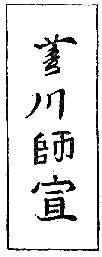
Moronobu's importance in the history of Japanese prints is twofold. He inspirited the Ukioye School with a new vitality; and he turned wood-engraving into an art.
The Ukioye movement, when Moronobu appeared, was still indeterminate. A great personality was needed to crystallize the vague tendencies then in solution. This Moronobu accomplished; and the far-reaching effect of his work was due to the fact that he did not confine his work to painting, but took up the hitherto unexplored field of woodcuts. As we have seen in the previous chapter, there had been produced up to Moronobu's time no illustrated book that could lay claim to artistic value. The little that had been done in this field was crude{73} artizan work without charm. Now Moronobu seized this medium and transformed it. Into his woodcuts he poured that powerful sense of design which he so notably possessed, creating real pictures of striking decorative beauty. These books and prints, widely circulated, carried to the eyes of the masses a new and delightful diversion, spreading far and near the contagious fascination of this lively Ukioye manner of drawing and awakening in the populace a thirst for more of these productions. Matabei had devised the new popular style, but it was Moronobu who threw open the gates of this region to the people.
Moronobu's first books appeared about 1660, and from that date to the time of his retirement he brought out more than a hundred books and albums and an unknown number of broadsheets. In all of these his vigorous, genial personality and his strong sense of decoration make themselves felt. Such a print as the album-sheet reproduced in Plate 1 exhibits his characteristic simplicity of sweeping line, the masterly use he makes of black and white contrasts, and the vivid force of his rendering of movement. The firm lines live; the composition is grouped to form a harmonious picture; a dominating sense of form has entered here to transform the chaotic raggedness of his predecessors' attempts. Distorted as these figures may appear to unaccustomed Western eyes, they have unmistakable style and their bold command of expression is the first great landmark in Japanese print history.
All of Moronobu's work was printed in black and white only, but occasionally the sheets were roughly{74} coloured by hand after they had been printed. His designs have little detail; as a rule the scene surrounding his main figures is barely suggested by a few lines; and the figures themselves are hardly more than intense shorthand notations of a theme. But how much life he gives them! No wonder that the populace loved his work, and that his many pupils bore away with them to their own productions the impress of his strong personality and animated style.
Certain of Moronobu's large single-sheet compositions (such as the Lady Standing Under a Cherry Tree, in the Buckingham Collection, Chicago, or the noble Figure of a Woman in the Morse Collection, Evanston), display so fine a power of composition and so unsurpassable a mastery of rhythmic line that there can be no hesitancy in judging him, quite apart from his historical significance, to be an artist of the first order. Nothing that he ever did was undistinguished.
The collector will not find it easy to procure adequate specimens of this artist's work. Moronobu's large single sheets are unobtainable to-day; they could never have been numerous, and the few that have survived the vicissitudes of almost three centuries are now in the hands of museums or collectors who will never part with them. Even his smaller single sheets are uncommon. His work is seldom signed.
The powerful impetus of Moronobu's art communicated itself to many pupils.{75}
Morofusa was the eldest son of Moronobu; he collaborated with his father, and produced designs that are in exact imitation of his father's style. His work comprises book illustrations and some large single sheets, and is very rare.
Additional pupils or contemporaries were: Moromasa, Moronaga, Morikuni, Masanojo, Moroshige, Morobei, Masataka, Osawa, Morotsugi, Moromori, Hishikawa Masanobu, Tomofusa, Shimbei, Toshiyuki, Furuyama, Morotane, Ryujo, Hasegawa Toun, Ishikawa Riusen, Ishikawa Riushu, Wowo, Kawashima Shigenobu, Kichi, Yoshimura Katsumasa, and Tsukioka Tange. Many of these are obscure figures, of whose work little is known. Most of them were chiefly book-illustrators.
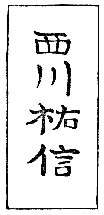
The name of Nishikawa Sukenobu brings to mind that long procession of charming girl figures which year by year came from his hand—figures whose sweet monotonous faces and delicately poised bodies move with a pure grace that is perpetually delighting. Lacking the powerful decorative sense of Moronobu, whose lead he in general followed, and never attempting the massive blacks of the master's dashing brush-stroke, Sukenobu yet achieved effects that are more gracious and appealing than those of his great predecessor. Nothing{76} could surpass the delicate harmony of line in such a design as the one reproduced in Plate 2; the willowyness of the young body, the naïve innocence of the head, the movement and rhythm of the flowing garments, are admirably depicted. This was Sukenobu's characteristic note; he lingers in one's memory by virtue of it and none other; he was the least versatile of artists.
He lived between the years 1671 and 1751. During the period of his activity his popularity must have been enormous. The single-sheet prints which he produced were not many, and only a small proportion of these have come down to us. His main work was in the field of illustrated books and albums. More than forty of these are known to-day. They contain chiefly scenes from the lives of women and figures of young girls. Most of them date from 1713 to 1750. They constitute Sukenobu's claim to rank as Moronobu's most important successor in the field of book-illustration. Generally they are printed in black and white only; a few are embellished with colour added by hand. It is not always possible to tell whether this colouring was done when the books were published or whether it was the work of some subsequent owner of the volume.
The delicacy of Sukenobu's designs, and the absence of those peculiar mannerisms and exaggerations which characterize much of the work of this period, serve to make him, of all the Primitives, perhaps the most comprehensible and pleasing to the European taste. To the Japanese connoisseur he recommends himself because of the refinement of{79} his work both in subject and in manner, and because of a certain classic dignity that pervades it.
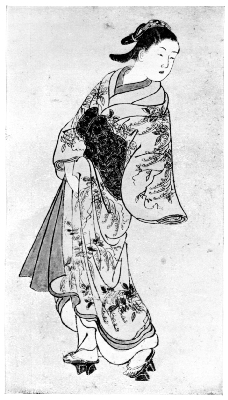
Plate 2.
The collector will do well to bear in mind that the books of Sukenobu were frequently reprinted long after his death; and these later impressions, lacking the original sharpness of line and intensity of tone in the blacks, are not desirable acquisitions. The original editions of his books are still to be found occasionally. His single-sheet prints are, however, of great rarity.
In the period immediately succeeding Moronobu—the early years of the eighteenth century—the work which of all others stands out with a unique and colossal grandeur is that of Kwaigetsudō.
Kwaigetsudō has long been a puzzle to the student. The original idea held by Fenollosa and other authorities, that all the prints signed Kwaigetsudō were by one man, has been abandoned; and the theory now prevails that there existed a group of artists, headed by a dominant master named Kwaigetsudō, and that all of these artists produced prints signed with his name together with their own. The most perplexing problem has been to determine which of the print-makers was the original master and which were his disciples. Dr. Kurth confidently states that Kwaigetsudō Norishige, was the original master. On the other hand, Mr. Arthur Morrison has recently expressed the opinion that the original Kwaigetsudō was solely a painter, who produced no prints whatsoever. His studio name{80} was Kwaigetsudō Ando; his personal name was Okazawa Genshichi; he was a late contemporary of Moronobu, and worked in Yedo from about 1704 to 1714, when he was banished to the island of Oshima in consequence of his participation in a scandal involving a gay banquet party at a theatre tea-house attended by certain Court ladies. Later he was pardoned, but did not resume his work. According to this theory all the prints were the work of his followers, who signed the name Kwaigetsudō with various additions. This view is probably the correct one.
The names of the Kwaigetsudō group of print-designers that have so far come to light are—
Kwaigetsudō Anchi (or Yasutomo);
Kwaigetsudō Dohan (or Norishige);
Kwaigetsudō Doshu (or Norihide);
Kwaigetsudō Doshin (or Noritatsu).
The Kwaigetsudō work is perhaps the most powerful and imposing in the whole range of Japanese prints. The sheets, of large size, generally represent the single figure of a standing woman clad in flowing robes. So much for the theme; it is nothing. But the treatment consists of a storm of brush-strokes whose power of movement is like that of writhing natural forces; out of this seething whirl of lines is built up the structure of the monumental figure.
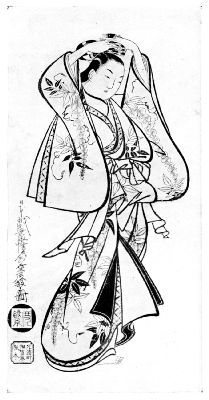
Plate 3.
The Kwaigetsudō reproduced in Plate 3 exhibits these qualities. The body is merely suggested, but with complete effectiveness, under the great swirls of{83} the robes. The dominance of the main curves, the vigour of the blacks, and the importunate life that vitalizes every touch and line, give Kwaigetsudō a place as high as the greatest contemporaries or successors.
All the Kwaigetsudō work was printed in black and white; sometimes the print was hand-coloured by the application of spots of tan, or red lead. Excellent full-size reproductions of several of them are obtainable. With these reproductions the ordinary collector will be obliged to content himself, for the whole number of Kwaigetsudō prints in existence can scarcely be more than a score or two. They are perhaps the rarest of all prints.
Kiyonobu Speaks.
With Kiyonobu begins that school of painters, the Torii, which was to take the initiative during the first half of the eighteenth century in developing the actor-portrait to a very high level, and which{84} still later was to have the honour of claiming as its head Kiyonaga, in whom the whole art culminated. It may be convenient to list here the successive leaders of the school, who were in their turn entitled to the name of the Torii, and whom we shall take up in their order.
| Torii I | Kiyonobu I | (1664-1729) |
| Torii II | Kiyomasu | (1679-1763) |
| Torii III | Kiyomitsu | (1735-1785) |
| Torii IV | Kiyonaga | (1742-1815) |
| Torii V | Kiyomine | (1786-1868) |
| Torii VI | Kiyofusa | (1832-1892) |
The importance of the school terminated with Kiyonaga, or at latest with Kiyomine.
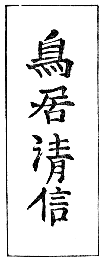
Kiyonobu I, the founder of the Torii line, was born in 1664 and died in 1729. It is said that he was first a resident of Osaka, and then of Kyoto; and that he finally came to Yedo about the beginning of the gay and brilliant Genroku Period, 1688-1703. Thus he must have been in Yedo a few years before the death of Moronobu in 1795, and it is evident that he studied the Moronobu style. Kiyonobu's father is variously reported to have been either an actor or a painter of theatrical sign-posters; at any rate his connection with the theatre was a close one. This circumstance doubtless determined the line of the son's activity{85} in designing. About 1700 Kiyonobu produced the first single-sheet actor-print in black and white only. From this it was only a step to the production of tan-ye, which he probably invented—actor-sheets simply but brilliantly coloured by the application of orange to certain portions of the picture. In this manner he issued both hoso-ye (that is, sheets about 12 inches high and 6 inches wide) and sheets of larger size, perhaps the most striking being actor-portraits, sometimes several feet in height, which enjoyed an immense popularity. By about 1715 he had taken up a more delicate kind of hand-colouring known as kurenai-ye, which some writers think he himself devised. A few years later he adopted the urushi-ye technique, increasing the number of colours and using lacquer to heighten the brilliancy of the effect.
Kiyonobu's subjects comprised a few landscapes of no great interest, and figures of several types. His forte was the representation of actors and heroes of history. His bold and gigantic style of drawing lends some probability to the story that he was, when he first came to Yedo, a painter of huge theatrical sign-boards or posters for the exteriors of theatres. The same manner that would be appropriate for these is found in his prints—arresting, forceful, highly exaggerated. His designs must be regarded as establishing for all later times the general type to be used in actor-portraits. This constitutes his greatest historical importance.
The prints which appear to be Kiyonobu's earliest are marked by an extraordinary development of line,{86} handled in great sweeping strokes. The brushwork is indicated with much dash and bravura, in the manner of the painter as distinct from the print-designer. A hasty glance might lead one to mistake some of these early compositions for the work of a Kwaigetsudō, though they are, as a rule, more uncouth.
Although power of line always remains one of Kiyonobu's characteristics, there appears in his later work a certain insistence on spaces, a treatment of the surface of the print as if it were a placque into which were to be inlaid large flat masses of a different substance. The robes are broken up into definite segments with sharp boundaries like parts of a picture puzzle, instead of remaining a surface on which to display the splintering vigour of brush-strokes. This second style is admirably adapted to the technique of wood-engraving.
The geometrical quality of some of Kiyonobu's designs is striking. There are several of his large tan-ye in which the whole print is nothing more than a series of great circles, brought into relation with each other, as part of the decoration of the drapery, by wild and whirling brush-strokes.
The work of Kiyonobu varies greatly in attractiveness. Some of his prints have more force than beauty; and it requires little effort to understand the contempt of the aristocracy for these crude manifestations of the mob's taste. Yet even in these grosser designs Kiyonobu realizes the power and passion of the dramatic rôle which he depicts, achieving an effect of tragic rage that is no less{87} intense and impressive because of its lack of subtlety. Most of his prints suggest the shout and roar of bombast: this is precisely what they were meant to convey. But there are a few of another type, that embody the masterful power of line of the first Torii, joined with a simplicity and refinement of design which his work frequently lacked, or which, if present, is disguised from us by the repellent violence of the figure portrayed. One must see Kiyonobu's rarest and greatest prints in order to realize why he is regarded as so great an artist.
I have written of Kiyonobu as if he presented no difficulties; but such is not the case. A stumbling-block for the student is created by the fact that there exist many two-colour prints signed Kiyonobu. It is recorded that Kiyonobu died in 1729, many years before the date fixed upon by Fenollosa and most other authorities as the date of the invention of colour-printing. If we are to believe that the numerous colour-prints signed Kiyonobu are by the first Torii, we must either put back the date of the invention of colour-printing to an extent that is improbable in view of other facts, or we must abandon the recorded date of Kiyonobu's death and regard his life as having extended well beyond the middle of the eighteenth century. Formerly this difficulty was not appreciated, and all work signed Kiyonobu was confidently attributed to the first Torii; but at present it is generally regarded as likely that there was a second Kiyonobu who produced all the two-colour prints signed with that{88} name. Whether he produced any hand-coloured prints is uncertain. This Kiyonobu II theory has met with scepticism in certain quarters, and some students prefer to accept the alternative of one of the two other possible solutions of the puzzle. Certain differences in style between the hand-coloured and the two-colour work confirm the Kiyonobu II theory to such an extent that I have felt constrained to adopt it here. It may be disproved eventually, but it is the best solution available at present. I shall therefore take up Kiyonobu II as a separate artist, without again drawing attention to the unsettled state of the relation between him and Kiyonobu I.
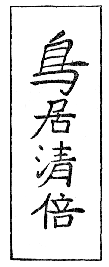
Kiyomasu, the second head of the Torii School, has been variously regarded as the brother or the son of the first Torii. The question of this exact relationship is a matter scarcely worth all the words that have been wasted upon it. What is important is the well-known fact that the two kinsmen worked side by side in the same studio for many years producing work of precisely the same type. The most experienced judges would find it impossible in some cases to distinguish between their productions.
Kiyomasu was born about 1679; some authorities{89} say 1685; but if it is true, as Von Seidlitz states, that there exists a play-bill by him which is dated 1693, the earlier of the two dates is the only possible one. Since Kiyonobu was born in 1664, the theory that they were brothers is the more probable. Kiyomasu's chief work was done contemporaneously with Kiyonobu's, in black and white, tan-ye, and urushi-ye; but later he produced some prints in two colours. His subjects were chiefly women and actors; he executed a few small landscapes and some fine representations of birds. His work must have continued some years after 1743, but appears to have terminated a considerable time before his death in 1763 or 1764.
A more prolific artist than the first Torii, Kiyomasu was in some particulars an equally distinguished one. Possibly his originality was less marked in that he merely followed the actor type which had already been created by Kiyonobu; but in the power of his draughtsmanship, reminding one again and again of a tempered Kwaigetsudō, he is no secondary figure. Nothing can surpass the vigour of linework in some of his large figure prints—great curves made with a heavily charged brush, expressing with notable simplicity the beauty of flowing drapery. His masterpiece is undoubtedly that superb figure in black and white of the actor Kanto Koroku (in the Buckingham Collection, Chicago), drawn in the Moronobu-Kwaigetsudō manner, which is reproduced in Fenollosa's "Epochs of Chinese and Japanese Art" with the erroneous attribution of Kiyonobu. This print is a triumph. Nothing finer was designed by all the succeeding generations of artists.{90}
Kiyonobu II, who signed all his work simply Kiyonobu, was a son of Kiyomasu, and probably a nephew of Kiyonobu I. His whole name was Torii Kiyonobu Shirō. He appears to have worked chiefly from about 1740 to about 1756, the period of the predominance of the two-colour print. All two-colour prints signed Kiyonobu are by this artist and not by the first Torii, who died before the process was invented. Kiyonobu II is regarded by many collectors as the best representative of the two-colour technique. His figures have a delicacy and grace that is alien to the work of his two predecessors in the Torii School; and his handling of the green and rose designs of these prints is charming. The great insistent colour masses and monumental figures of his predecessors undergo a change in his hands to a more detailed division of colours and a slightening of the forms of the bodies and limbs. Also the old passionate vigour of brushwork disappears in the new technique—a loss that seems a grave one.
Most writers speak of Kiyonobu II as a two-colour artist only. It is, however, fairly established that at least one of the urushi-ye signed Kiyonobu is by Kiyonobu II. That he did a few three-colour prints is certain. His work, like that of all these early men, is rare. It is particularly difficult to find examples of his beni-ye that are in good condition, since the rose-colour has in most cases entirely faded.{91}
Kiyotada was one of the best known and one of the most brilliant of the numerous followers of the great Torii pioneers. He is said to have been a pupil of Kiyonobu I. His period of production began not far from 1715, and ended before the invention of two-colour printing. His prints are all tan-ye or urushi-ye, some of them slightly like Okumura Masanobu in style. Certain of his hoso-ye have fascinating curves and superb colour—red, yellow, green, pink, and black, woven together into rich combinations.
Kiyoshige produced very fine actor-portraits coloured by hand, which remind one distinctly of Kiyonobu I in his later period. Large masses of colour are used by him with powerful decorative effect; and the geometrical designs of his textiles are sometimes striking. Kiyoshige's work has a strong yet graceful quality that makes him worthy of more attention than he has hitherto received. He lived to produce some two-colour prints. Dr. Kurth believes him to have been the first to use the pillar-print form for actor-portraits. His working period was from about 1720 to about 1759.
Hanegawa Chinchō was an eccentric and interesting figure, who, though a pupil of Kiyonobu I, appears to have been more closely related to the Kwaigetsudō School than to the Torii. Born about 1680 he, by birth a Samurai, became a Ronin, and entered the studio of Kiyonobu. He was erratic, proud, and isolated. In spite of his pressing poverty,{92} he worked at print-designing only when it pleased him to do so, which was seldom; and though he lived until 1754, his output was small. He was a poet and an aristocrat. His single-sheet prints have a curious esoteric quality—strange, stiff, beautiful curves that are not quite like the work of any other designer. Chinchō's work is of extraordinary rarity; there can scarcely be more than a score of his prints in existence.
Hanekawa-Wagen is represented by two prints in the Buckingham Collection. Nothing is known of him.
Kiyotomo, whose work appears to fall entirely within the period of hand-coloured prints, produced excellent actor designs, in some of which the line-work reminds one slightly of Kwaigetsudō. The influence of Kiyomasu appears in some of his urushi-ye. His prints are distinguished by their vigour and are found but seldom.
Sanseido Tanaka Masunobu produced hand-coloured and two-colour prints in the Torii manner. A print by him dated 1746 is known, but most of his work precedes 1740. He is not to be confused with the Masunobu who was Harunobu's pupil.
Kiyosomo is said to have been a distinguished pupil of Kiyonobu I, influenced also by Okumura Masanobu.
Other men of this period, closely connected with the Torii School, were: Kiyoake, Kondo Sukegoro Kiyoharu, Katsukawa Terushige, Nishikawa Terunobu, Nishikawa Omume, Fujikawa Yoshinobu, Tamura Yoshinobu, Tamura Sadanobu, Kichikawa{95} Katsumasa, Kiyomizu Mazunobu, Shimizu Mitsunobu, Kondo Kiyonobu, Kondo Katsunobu, Kiyorō, Tadaharu, and Nakaji Sadatoshi.
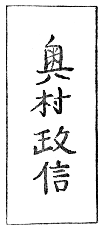
A Figure.
Okumura Masanobu may be termed the central figure of this period: not only does he tower among the greatest men of the time, but around him revolve the changes in technique, full of far-reaching consequences, which came into being with his invention of two-colour printing.
Furthermore, he takes on an additional historical importance as the founder of the Okumura School, which continued parallel with the Torii School, and whose productions are characterized by a finer development of grace and elegance than is to be found in the output of the rival line.
Masanobu was born about 1685, and lived until about 1764—a life of very nearly{96} eighty years, full of varied achievements. During the course of his career he used many names, among which Genpachi, Hōgetsudō, Tanchōsai, Bunkaku, and Kammyō are the most frequent. Little is known of his life except that he began as a bookseller in Yedo. He is reputed to have been a pupil of Kiyonobu, but Mr. Arthur Morrison believes this to be an error, and thinks that Masanobu was an independent artist educated in no one of the Yedo schools. Whichever account may be correct, it is at least certain that Masanobu shows in his work few traces of resemblance to the first of the Torii masters. It is equally clear that he was early and strongly influenced by the work of Moronobu, who died when Masanobu was only ten years old, but whose designs were of course still widely known. It is said that soon after 1707 Masanobu founded a publishing establishment in connection with his book-shop, issuing prints as well as books. This must have afforded him great opportunities for experiments in technique, and may have been no small factor in making possible the remarkable advances for which he was responsible.
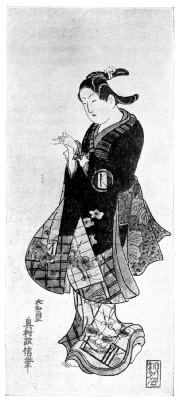
Plate 5.
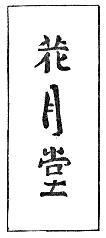
Masanobu's earliest works were book-illustrations and albums, which closely follow the manner of Moronobu. Plate 4 reproduces one of these.{99} Parallel with them he produced a number of tan-ye, the large single-sheet prints in black and white, which, after printing, were coloured by hand with orange pigment. These probably date from before 1720, although exactness cannot be hoped for. About 1720 he began to do work in a medium which he is said to have invented—the urushi-ye, or lacquer-prints, in which the lacquer gives a new richness and luminosity to the various colours. An example of these appears in Plate 5. The device of heightening the effect by applying gold powder to certain portions of the design was also employed by him. A play of light that is extraordinarily fascinating often marks his combinations of colours. By about 1742 a new technical advance, the most vital in the whole history of the art, came into existence; and Masanobu is generally credited with its invention. This was the employment of two blocks beside the black key-block to print two other colours upon the paper. The importance of this step was immeasurable: when it was taken the doom of the hand-coloured print was sealed, and the way to still further development lay open. At first the colours used by Masanobu in his two-colour works were a delicate apple-green and the equally delicate rose called beni, from which the name beni-ye came to be applied to all the two-colour prints of this period. A print of this type appears in Plate 6. The combination of these two colours is singularly lovely, and the fresh charm of these sheets has led some collectors to prize them as the most beautiful products of the art.{100}
Certainly Masanobu's mastery of the problem of producing a rich and vivacious colour-composition by the use of only two colours is noteworthy. By varying the size and shape of his colour masses, and by a judicious use of the white of the paper and the black of the key-block, he produces an effect of such colour-fullness that it requires a distinct effort of the mind to convince oneself that these prints are designs in two tones only, and not full-colour prints. Masanobu lived long enough to produce some three-colour prints, when these were devised about 1755, but the effects he obtained in them were possibly less fascinating than those of his earlier process.
It can probably never be proven that Masanobu was, in fact, the inventor of all the devices that were attributed to him—the lacquer-print, the beni print, the use of gold powder, and the first actual prints in colour. Certainly some of them may be credited to him; but any one familiar with the growth of hero-legends knows how a great name attracts to itself in popular report achievements that were really the fruit of scattered lesser men. To the list of Masanobu's probable inventions must be added the pillar-print, that remarkable type, about 4 to 6 inches wide and 25 to 40 inches high, which was to be an important form of design from this date on. It is possible that we must also attribute to him the invention of the mica background—that silver surface of powdered mica which give a curious and beautiful tone to the figures outlined against it.{101}
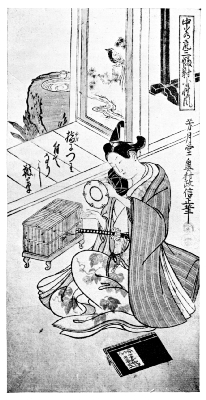
Plate 6.
Of Masanobu as a designer it is difficult to speak with moderation. Through his work runs that sweeping power of line which he derived from his study of Moronobu, and, in addition, an elegance and suave grace that is the expression of his innate grace of spirit. The grandeur of certain others of the Primitives is austere and harsh, but Masanobu is always mellow and harmonious. His figures, more finely proportioned than most of the figures of the period, sway in easy motion—a mixture of sweetness and distinction characterizes the poised heads, superb bodies, and ample draperies of his women, while every resource of compact and dignified design is expended upon the impressive figures of his men. A certain large geniality, a wide, sunlighted warmth of conception, runs through his work. The dramatic distortions of his Torii predecessors and contemporaries are melted in him, as towering but uncouth icebergs melt in the sun of kindlier latitudes. At times his line-work has a force that seems derived from the Kwaigetsudō tradition; more often it is imbued with a gentler rhythm no less expressive of strength. In his finest designs he achieves notable balance of line, and a massing of colour beside which, as Fenollosa remarks, "even the facades of Greek temples were possibly cold and half-charged in comparison."
Women, out-of-door scenes, and a few actors, constitute the main subjects of Masanobu's work. As a portraitist, his few productions, such as the well-known humorous pillar-print of the story-teller Koshi Shikoden, give him rank as the greatest of his{104} time. The landscape backgrounds in some of his smaller prints are a delightful innovation, executed with delicate power of suggesting by a few strokes the whole circle of a natural setting. The quiet charm of these landscapes surrounds with an atmosphere of felicity the beautiful figures that move through them.
A full and brilliant life stirs in all Masanobu's work. At no other period in the history of Ukioye was such effective use made of the patterns of draperies. The elaborate fashions of the brocades worn in this day lent themselves to the decorative needs of the larger prints; and frequently we find the figures clothed in a riot of striking textiles—flowers, trees, birds, ships, geometrical shapes—all mingled in the weave of the cloth, and arranged by the print-designer into a combination that is tumultuous without confusion and glowing without garishness. Masanobu's pictures seem the overflow of his spirit's wealth; they never have the ascetic and rarefied quality that sometimes appears in the work of even great artists.
Masanobu's work is scarce. His larger and more important prints very rarely appear outside of the great collections.
Okumura Toshinobu, a son of Masanobu who died young, was the best as well as the most famous of Masanobu's pupils. He gave promise of becoming one of the notable print-designers, and even in his short career produced work of high quality. Born{105} about 1709, his period of production covered the years of the lacquer-prints, and ended before 1743. His urushi-ye, lithe in design and powerful in colouring, constitute almost his whole known work.
Okumura Masafusa, Shuseido, Hanekawa Chiucho Motonobu, and Mangetsudō may be mentioned as other and less important pupils of Masanobu.
Nishimura Shigenobu is an artist about whom there is great confusion. He is variously called the father, the son, or the pupil of the better-known artist Shigenaga: the first of these alternatives is the most probable. Nothing is known of Shigenobu's life, and very little of his work is extant. Kurth says that Shigenobu founded the Nishimura School, and worked in the manner of the earliest Torii. Von Seidlitz believes that he did some work in the Kwaigetsudō manner. Fenollosa dates his work 1720-40, and thinks that he worked first like the Torii, then like Masanobu. At present it seems impossible to gather further information about this interesting artist.
Nishimura Shigenaga was at one time regarded as the inventor of the two-colour process; but now that the weight of opinion attributes this invention to Masanobu, Shigenaga remains a figure whose importance is hardly diminished. He must still be regarded as perhaps the most notable master of the Nishimura School, both as a designer and as the{106} teacher of a group of pupils whose brilliancy is equalled by the disciples of no other artist.
Shigenaga was born in 1697 and lived until 1756. He used the names Senkwadō and Magosaburō as well as his own. Little is known of him personally, except that he was probably the son of Shigenobu.
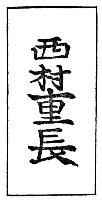
His work began with black-and-white prints in the manner of Kiyonobu; these were already something of an anachronism at the date when he commenced his designing. He then turned to urushi-ye, and produced some beautiful examples. About 1742, when the two-colour process was invented, he made himself one of the most successful masters of it. Dr. Anderson reproduces, as the frontispiece of his "Japanese Wood-Engraving," a fine example of Shigenaga's work in this technique, but erroneously dates it as 1725—more than fifteen years too early. Shigenaga also did fine work in the three-colour process, of which he may possibly have been the inventor. His designs comprise not only women and actors, but also landscapes, flowers, animals, and birds. His versatility is one of his most striking characteristics.
It was from the style of Masanobu that Shigenaga drew his most lasting stimulus; and among his sheets we shall find many a figure worthy to stand beside his master's serene creations. Dr. Kurth calls{107} him a "faded or weakened Masanobu"; but this term can be applied with justice to only a portion of Shigenaga's work. His productions are uneven; part are indeed somewhat tame; but certain of his designs rise to a high level. His finest works, which are rare, are his figures of graceful women in the Masanobu manner. But he was no mere imitator. The Masanobu poise, the Masanobu flow and patterning of garments he did, it is true, adopt; but with how fresh and sensitive a life does he infuse them!
Shigenaga's pupils comprise most of the great men of the succeeding generation Toyonobu, Harunobu, Koriusai, Shigemasa, Toyoharu, and many others learned from him the elements of their art. Thus Shigenaga may be regarded as the most important bridge between the Primitives and the later men, passing over to them the traditions of the older schools together with the stimulus of that fresh, inventive, and assimilative spirit which was peculiarly his own.
Among the less important pupils or associates of Shigenaga may be named the following artists:—
Tsunegawa Shigenobu produced work much like Shigenaga's; in the few prints of his which I have seen there is grace and ease, but not great strength. His work appears to have been mainly in urushi-ye. Mr. Gookin believes this name to be merely the early name of Nishimura Shigenobu.
Yōsendō Yasunobu or Anshin, by whom a fine lacquer-print with strong blacks is in the{108} Spaulding Collection, may, with some hesitancy, be classed here. Mr. Gookin thinks this signature may be merely one of the studio names of some more famous artist.
Nagahide, dated by Strange about 1760, appears to belong to this group. The Harmsworth Collection, London, contains a print by him representing famous theatrical characters depicted by geisha, the colours partly printed and partly applied by hand.
Harutoshi is known to me only by one pillar-print, in the manner of Shigenaga's actors. It is doubtful where he should be classified.
Akiyama Sadaharu, Hirose Shigenobu, and Ryūkwado Ichiichido Shigenobu were obscure pupils of Shigenaga.
Yamamoto Yoshinobu is said by Fenollosa to have been a pupil of Shigenaga, and possibly the same as Komai Yoshinobu, who is treated later under Harunobu. Dr. Kurth thinks him a member of a Yamamoto School, which comprised also Yamamoto Denroku, Yamamoto Shigenobu, Yamamoto Shigefusa, Yamamoto Fujinobu, Yamamoto Shigeharu, Tomikawa Ginsetsu also known as Fusanobu, Yamamoto Maruya Kyūyeimon, Yamamoto Kuzayeimon, and Yamamoto Rihei.
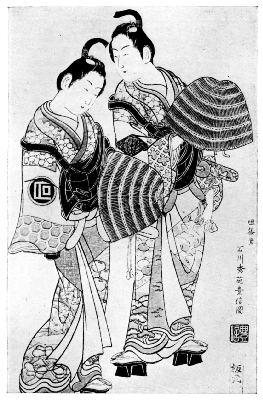
Plate 7.
A Pillar Print.
Ishikawa Toyonobu, who not many years ago was regarded as an artist of secondary importance, has of late, thanks to fresh discoveries, come to be esteemed by competent observers as one of the giants of the line—one of those masters among the Primitives whose dignity of composition makes all but a handful of his successors appear petty beside him.
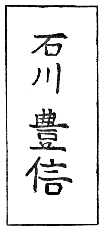
This important artist, who sometimes signed himself Shuha, was, like so many other of the better men of his time, a pupil of Shigenaga. In his early work we find him influenced by the suave and noble figures of Okumura Masanobu more than by the figures of his direct master. Born in 1711, Toyonobu lived until 1785; and the long space of his life thus extended beyond the period of the Primitives and into the period of polychrome printing. Nevertheless his real activity terminated with the end of the Primitive Period. His earliest work was in black-and-white{112} or hand-coloured; from this he passed on to two-colour prints, a manner in which he produced many hoso-ye of flawless grace; and then into three-colour prints, in which his most important work was accomplished, and "whose classic master," as Kurth says, "he may be called." Between 1755 and 1764, the great period of the three-colour print, Toyonobu stood almost unmatched in the field. A fine example of his work appears in Plate 7. After 1764 the ascendancy of Harunobu eclipsed Toyonobu; even the classic style of the older master could not match the brilliant and popular innovations of Harunobu's "brocade pictures." He was therefore driven to take up the technique of full-colour printing. In one print he gives us figures like those of Koriusai; in another he follows Harunobu with the most complete exactness. Though forced to the wall, the old giant could still fight his rivals, and with their own weapons.
The works of Toyonobu's prime—particularly his pillar-prints—produce a singular impression of lofty greatness. His line-arrangements have always a magical serenity and balance, and the repose of his compositions is equalled only by their strength. In these tall figures, where hauntingly lovely lines never degenerate into mere sweetness, there is a combination of rigour with suavity, of force with grace, that makes him forever memorable. His masterful precision, and the curiously "towering" effect which his figures produce, as in the Girl with the Umbrella reproduced in Plate 8, serve to mark him as one of the important representatives of the grand style in design.{113}
Plate 8.
Perhaps more than any other artist of the Ukioye School, Toyonobu devoted himself to the drawing of the nude. These rare works are among the finest of his productions, and are so distinctly an exception to the general practice of Japanese artists that they call for special remark. Certain other painters also produced a few such pictures, but they must all be regarded as sporadic phenomena running counter to the characteristic Japanese feeling. The national temper recognizes feminine beauty in art only when clothed; and it is due solely to the profounder perception of a few great artists that any such designs have come down to us. One is moved to speculation over this curious fact, particularly when one considers that the sight of the body, at least among the lower classes, must have been almost as common in Japan at this time as it was in Greece during the great period of Athenian art. But very different was the reaction produced upon the two races by this familiarity. In the Greeks, it encouraged an art whose prime aim was to give expression to those harmonies and hints of perfection that lie hidden in the imperfections of each individual body; so that we have from the Greeks those syntheses and idealizations of the human form which still haunt us like faint memories of the gods. But in the Japanese mind, the sense of the individual defects seems to have overpowered the impulse to creative idealism; and the people, as a race, turned from the nude figure to the more easily manipulated beauties of flowing robes and gorgeous patterns, translating Nature into images{116} of an alien richness, and love into hyperboles of public splendour. That part of Nature which lay outside themselves they could indeed cope with, as the lofty visions of landscape which they have transcribed testify; but with a few exceptions, such as Toyonobu and Kiyomitsu and Kiyonaga, they dared not attempt the final venture of rationalizing the uses and aspects of the body. And it is because of an inadequacy whose source and root spring from this attitude that posterity will perhaps rank this art below the art of Greece, adjudging even the matchless subtlety and refinement of these designs to be no adequate compensation for the absence of that frank Greek courage which attempted to clarify and ennoble the fundamental conditions of the existence of man.
Toyonobu, great artist that he was, overstepped the national barrier and came very near to surpassing the finest achievements of Greek art.
Pillar Print of a Woman.
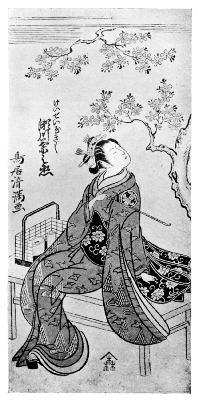
Plate 9.
Pillar Print of a Man.
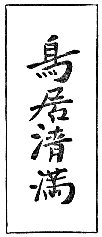
Kiyomitsu took his place as the third great head of the Torii line, succeeding his father Kiyomasu. In subject and in manner, it is the Torii tradition that he carries on. We know nothing of his life, save that he was born in 1735 and died in 1785. His work falls almost entirely within the class of two- and three-colour prints. I know of only one hand-coloured print by him; but as his dates denote, he lived far into the period of polychrome printing, and was a partaker in Harunobu's experiments in colour. Von Seidlitz is wrong in saying that no polychrome prints by Kiyomitsu are known; a few exist and are very beautiful. He did little work after 1765, and is to be regarded as most characteristically an artist of the Primitive Period—in fact one of the greatest. Certainly between 1755 and 1764, no one{120} but Toyonobu could rival him; and these two may be ranked the supreme designers of the three-colour epoch.
The outstanding feature of Kiyomitsu's work is its formalism. Whatever he touches is compressed to a pattern, and rendered into bold hieroglyphics of sweeping curves. His line is simple, powerfully dominated by a circular movement that is singularly and inexplicably delightful. His colours, even while they remain only two or three in number, never lack variety and strong decorative effect. The slightness of the use which he makes of black is noteworthy; he compensates for its absence by choosing heavy opaque colours of rich tone. Some authorities regard him as the first to employ a third colour-block.
Kiyomitsu's work is markedly stylistic—even dominated by a certain mannerism; one comes to recognize almost infallibly the formula he uses, and to regard as an old friend that peculiar swirl of drapery, swing of body, and artificial poise of head which appear, as in Plate 9, like an accepted convention throughout the larger number of his designs. The convention is an agreeable and highly æsthetic one, based on fundamental curves of great beauty. But the invariability with which he employs this formula gives Dr. Kurth some excuse for regarding him as a monotonous and over-estimated artist. Had we only Kiyomitsu's hoso-ye prints, it might be possible to agree with Dr. Kurth; for these figures, enchanting and full of elegance as they are, certainly are dominated by a sameness of manner such as one finds in no other series of hoso-ye. But{123} the truth of Dr. Kurth's depreciations must be questioned if one turns to the pillar-prints, which constitute the real glory of Kiyomitsu's career. The two reproduced in Plate 10 exhibit his power. Kiyomitsu may be regarded as one of the half-dozen greatest masters of the pillar-print shape of composition. Much of his finest work is in this form. Here his somewhat tight curves lengthen out into flowing beauty; and the dignity always inherent in his drawing appears at its best.
Plate 10.
Kiyomitsu's rare nudes take a place close beside those of Toyonobu. They have a keen poetic charm; and though their vigour is less marked than that of Toyonobu's, their grace and elegance of movement is at least as striking.
The collector may find it useful to remember that long after Kiyomitsu's death, Kiyomine and Kiyofusa sometimes used the great name of Kiyomitsu as a signature to their own works. Only an inexperienced observer could mistake these late and decadent productions for the work of the original master.
Torii Kiyohiro has been rated by some writers as more highly gifted than Kiyomitsu. This praise appears absurdly extravagant; yet in disputing such a claim, one must admit the great charm of Kiyohiro's work. He is said to have been a pupil of Kiyonobu II; his career runs parallel with that of Kiyomitsu, and he seems frequently to imitate that artist. The period of his greatest prominence was between 1745 and 1758; his work is all in two or three colours.{124} A delicate draughtsman, his figures have marked grace of poise and firmness of design. His mannerism is less stereotyped than Kiyomitsu's; some of his prints have great beauty, but he never reaches certain heights which Kiyomitsu attained. Prints by him are uncommon.
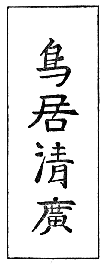
Torii Kiyotsune produced delicate and distinguished prints in two or three colours, much like those of Kiyomitsu. Most of his figures are characterized by a curious slenderness and exquisiteness; but they are somewhat lacking in vigour. After 1764 he fell under the influence of Harunobu and adopted full-colour printing, still retaining, however, that very individual type of face—a little scornful, a little fastidious in expression—which marks his designs. His work is rare.
Among the pupils of Kiyomitsu may be noted Torii Kiyosato, Torii Kiyoharu, Morotada, Kiyotoshi, Torii Kiyomoto, and Torii Kiyohide. Their work was almost contemporaneous with that of the master.
Amano Toyonaga, Ishikawa Toyomasu, and Ishikawa Toyokuma were probably pupils of Toyonobu.{125}
IV
THE SECOND
PERIOD:
THE EARLY
POLYCHROME
MASTERS
FROM THE INVENTION
OF POLYCHROME PRINTING
TO THE RETIREMENT
OF SHUNSHO
(1764-80)
From the Invention of Polychrome Printing to the Retirement of Shunsho (1764-80)
The transition from primitive to sophisticated art is very like the progression of a race from its heroic youth to its elaborately gifted maturity. Life grows more complex, the material riches and the machinery of living become more diversified; but it is still to the early days that one looks for the strongest development of personality and the most daring achievement in the face of great difficulties. Sophistication, in the history of an art as of a race, brings refinements and nuances unknown to the pioneers; but it cannot intensify and may often encumber the spiritual force and essential genius of the creators. The great individuals of the earlier time developed all that was essential as far as it could be developed; the later enlargement of scope is in the direction of the material and the accidental. In the Primitives we find the full stature of the spirit; in the art of later days, with all its parade of processes, we shall hardly find more.{128}
In the First Period the initial impulse of print-designing manifested itself in work that was powerful and beautiful, but of simple technique. In the Second Period the barriers that confined the Primitives were swept away by new possibilities of expression. The three-colour prints gave place to prints in which an unlimited number of blocks could be employed; and this enlargement of the artist's resources produced a new and splendid blossoming. In this Second Period the art seemed to hesitate midway between the forces of the primitive inspiration, which was one of pure and stately decoration, and the more naturalistic forces that were making ready for the Third Period, with its fuller rendering of the lights and spaces of life. The presence of both groups of forces makes this Second Period possibly the most interesting of all.
The specific characteristics of the period are sharply marked. They consist, first of all, in technical advances—the mastery of full-colour printing and the realization through this process of the marvellous colour-dreams of the great masters. But beyond the technical advances there is a change in spiritual attitude; the artist, heretofore content to create a pure decoration, a masterful mosaic that expressed his æsthetic ideals, now begins to adopt a more personal attitude in his treatment of the forces and spectacles of daily existence. True, he disposes these elements arbitrarily; the picture he creates is a world of imagination; but as compared with the Primitives,{129} he tells us more of his experience and is closer to our own. Even his most fanciful designs bring to us some remote and abstract echo of known voices. Lyric joy speaks through Harunobu, dramatic terror through Shunsho, splendour through Koriusai, mystery through Buncho; and though the medium be a symbol, and its connection with reality as remote as that of music, yet by the vividness of the emotion evoked in us we may judge of the definiteness of the artist's motive, and realize through colour and line an intangible human voice.
The stream of art history here flowed in two main channels. One was the Katsukawa School, headed by Shunsho, which like the older Torii School devoted itself chiefly to the representation of actors. The other was the school of Harunobu, whose gracious designs of women were the most novel productions of the period. A third school was founded by Toyoharu and a fourth by Shigemasa; but the real importance of these two schools developed only in a later epoch. During this period the great Torii School may be said to have remained dormant; it was to awaken in the Third Period to a new splendour in Kiyonaga.
There is a passage from a contemporary record that throws light on the temper of the people and the artists at this time. I have freely translated it, with the courteous permission of Dr. Julius Kurth (Kurth's "Harunobu," R. Piper & Co., Munich), from his German rendering of a unique manuscript book in his possession, which appears to have been written by the poet Yukura Sanjin, and illustrated by{130} Harunobu in 1769. The book is a whimsical, devil-may-care production of the lightest sort; but from its pages the glitter and surge and laughter of Yedo holiday life rise with a far-away yet curiously distinct echo.
"Dohei hails from Oshu. Upon his head he wears a cap; and his mouth sends up a song when in the Capital of the East he vends his honey-sweetmeats. His cape is of tiger-skin, and bears a suspicious resemblance to the loin-apron of the Devil. His umbrella is of scarlet crêpe, and recalls the plumed spears of the festival-guards. As his coat of arms he chose a Devil's head and a skeleton; upon his outer robe he wrote the sign, 'Dohei, Dohei.' While you buy his honey-sweetmeats, he sings a song of a new style, and ends it with the refrain, 'Dohei, Dohei!' Therefore the name of Dohei has become known everywhere. Even the smallest children all sing this song in chorus over and over a thousand times. If he sells his honey-sweetmeats in the Eastern part of the city, the people in the Western streets are furious; if he sells them in the Southern quarter, the people in the Northern streets are furious. For then they want to know why he came to them so late.
"If on the three hundred and sixty days of the year one goes, day in and day out, through all the eight hundred and eight streets, one finds a tavern at every five paces; and it is as if this city had been{131} changed into a pond of rice-wine. One cannot take ten steps without coming upon a shop in which whole mountains of rice-cakes and other confections are offered. If one hears in the distance an almost heavenly music, it is the song of a lady to the strum of a guitar. If there is a rattling like peals of thunder, it is the ox-carts on the side streets. People with coiffures shaped like the leaf of the ginko-tree roll up their outer robes and jostle shoulder to shoulder. Ladies with girdles of spun gold and long-sleeved girlish dresses sway their hips; and their garments, coloured like the graining of wood, flow as do torrents of Spring. Their hats of green paper resemble a clump of trees in Summer. And as they wander along, the hems of their robes flutter open, and the blood-red silk linings gleam like maple foliage—though it is not yet Autumn! The festive white material of their inner robes shines like snow—though it is not yet Winter! If it were, they would be muffled to their very noses with crêpe veils. They have arranged their hair as if surmounted by a cap, like tiers of little chrysanthemums. At their thighs sparkle tobacco-wallets ornamented with silver and gold.
"The black-and-white prints of earlier days are antiquated now, and the only thing people care for is the newly-devised gorgeousness of the Eastern Brocade Pictures. Musical plays are no longer to be seen; instead, you go to the music-girls and the dancing-girls in the taverns. The young people want lively entertainment, and visit the wine-shops. Out of a vase in which, according to the ancient custom,{132} flowers were formerly placed, lots are now drawn to fix upon the day for a party; while according to the fashionable arrangement of flowers in the hanging jars, the flowers look like arrows from a bow. The vendors of fritters call out, 'Celebrated Pasties! Celebrated Pasties!' and boast upon the brilliant paper signs of the just-opened booths, 'Headquarters! Headquarters!' Handkerchiefs at four coppers apiece hang at the loins of the servants of Samurais. The song of the New Year's dancers rings out among people who hitherto had sung only folk-songs. The caligraphist studies the Nagao style; the poet learns by heart the poems of the Chinese epoch, and the minstrel the style of the Manyo anthology. To obtain new remedies for his stock the doctor draws upon the old school for all kinds of herbs, and cures eyes and noses with them—just as pumpkins are perfected into melons. Often the priest of Buddha wanders, an object of derision, through the streets in the darkness of night in search of a girl. To be sure, he is a very learned man; but what leads more easily to dangerous labyrinths than love?
"The theatres in the Sakai Street give performances continuously. The reconstruction of the Yoshiwara is to be finished in a few days, and people come and go there only to drink and to sing. They draw water from the floods of the Sumida River, but it will not be drained dry! They view again and again the flowers of the Asuka River, but these also are without end! The Shenshuraku Theatre enlivens the public, and upon the Banzairaku stage man's life is idealized. So all are happy—like green firs that{133} become thicker and thicker and put forth new needles."
Into this crowded world of exuberant life came Harunobu and his contemporaries—into this underworld, if you will, but an underworld more beautiful and sun-drenched than any known to our great Western cities. Instead of the bar in the slum they had the tea-house on the river-bank; instead of the prize-fight they had the cherry festival; for them, vice put on robes of a certain stately beauty; their stage was marked by the same ennobling absence of realism that distinguished the stage of the Greeks. The holiday spirit of the hour seems more spontaneous than ours; their hearts seem less troubled by spiritual confusions. And manifestly their underworld knew beauty and brought forth an art that is now a universal human treasure; while our underworld has been, with the rarest of exceptions, wholly sterile.
One of the most important of the underworld institutions which the prints of this period depict is the theatre. Though Harunobu turned aside from it, his great contemporary Shunsho and the whole body of Shunsho's followers found most of their material there.
The popular theatre had sprung into importance in the days of Moronobu. Previous to that time, the classic lyric drama of the aristocracy, called the Nō, had flourished in the secluded palaces of great nobles; but the mob was obliged to divert itself with nothing more interesting than jugglers and street performers.{134} Therefore when the theatre first came into being, in the river-bed of Kyoto, it achieved great popularity; and when later it was transferred to Yedo, it rose during the Genroku Period (1688-1703) to a position of passionate favour. It appears never to have had a very savoury moral odour; and before long it became associated with so much corruptness that it presented a serious problem for the Tokugawa rulers. In 1643, as a corrective measure, they had decreed the exclusion of female actors from the stage. From this time on, only men trod the Japanese boards; the female rôles were taken by male actors whose skill in this impersonation is said to have been extraordinary.
The status of a great actor in the hearts of the people was not very different from that of a successful prize-fighter among us to-day. He was a popular idol; his movements were the subject of the eager curiosity of the gaping multitude; but his social rank was of the lowest. The prints of a later date show us pictures of actors with their gay companions on boating-parties or tea-house picnics, surrounded by inquisitive throngs of spectators. Famous and greatly sought after as these actors were, they occupied positions of even less esteem than the English players in the days of Queen Elizabeth. Nothing so well illustrates their ostracism from any kind of society as the words used by one of the greatest of actor-painters, Shunsho, in the preface to a book of drawings representing actors: "To be sure, I love the theatre, and greatly enjoy being a spectator, but I have no connection with the actors{135} themselves, and do not know them in private life." Even Shunsho, who had created the heroic designs of these men in their great rôles, dared not acknowledge himself as their familiar.
When they appeared on the stage, the faces of the actors were frequently painted with startling streaks of red and white, an effect reproduced in some of the prints. The elaborate robes worn when they represented heroic figures of bygone ages formed superb material for the designs of the artists. The Japanese stage of to-day probably does not differ very much from what it was in Shunsho's time; and we still see on it that florid elaboration of gesture, bombastic delivery, and intensification of facial expression which the prints have perpetuated.
The actors were divided into clans or schools; the name of a famous head of a clan would be handed down for generations from master to pupil. Thus there were many of the name of Danjuro, Hanshiro, and Kikunojo in succession, who were not related to each other by blood. Certain clans such as the Kikunojo specialized exclusively in women's rôles. Each clan had its mon or crest, worn on the sleeve, and each actor had a personal mon; in the prints these generally appear. In Plate 20, for example, the circle with eight crossed arrow-buts indicates the mon of Nakamura Matsuye; in other prints, the three great concentric squares of Danjuro, the trisected concentric circles of Hanshiro, or the iris within a circle of Kikunojo (Plate 9), are easily identified.
In the hands of Shunsho and his followers the figures of these actors were used as the material for{136} brilliant designs. For the moment, however, we must return to the foremost artist of this period—one who never loved the actors—Harunobu.
Figure of a Girl.
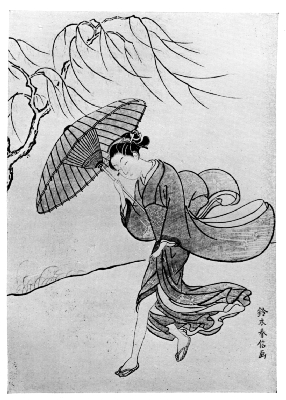
Plate 11.
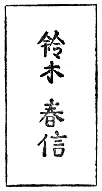
The few available fragments of information about the life of Susuki Harunobu can be briefly stated. Born between 1725 and 1730, he lived in Yedo all his life in a house near the river. In 1764 he perfected a new and epoch-making treatment of colour-print technique, and died in 1770, not much more than forty years of age. We may, where so little is known, willingly follow Dr. Kurth in his ingenious tracing of a romantic link between Harunobu and the hamlet of Kasamori, whose pine-trees, red temple-torii, and beautiful tea-house waitress O-Sen haunt his work recurrently; but we must be content to regard this as at least half fancy. Harunobu's direct teacher was Shigenaga, and he was influenced early by Toyonobu; but it was to Sukenobu and Kiyomitsu that he turned for the inspiration of those characteristic figures which he{140} created during the six great years of his real activity.
Harunobu's work before the year 1764 is relatively unimportant. It consists of prints of actors and legendary subjects, printed in two or three colours; a few of his hoso-ye prints of this period have charming delicacy of line and colour, and at least one of his actor pillar-prints is a work of notable dignity; but upon the whole his work is not very individual. Any one of a dozen of Shigenaga's pupils might have done almost as well. Before 1764 these men were all his equals; after 1764 he took a step which few could keep pace with and which none could outstrip.
In 1764 he brought forth that synthesis of the resources of his art which was to shake the Ukioye world. Whether he was the actual inventor of polychrome printing is not certain; some authorities attribute the invention to an engraver named Kinroku; but it is very clear that Harunobu was the first to seize upon and realize the possibilities of the discovery. Some technical hindrance, such as the difficulty of securing perfect register from many blocks on the wet stretching sheets, had prevented the earlier completion of the process; and it is possible that it was a printer who discovered the simple device needed to overcome the difficulty. This, however, is a matter of mere mechanics and has no bearing upon the question of the real glory of Harunobu. What is important is that he seized the new technique and made out of it an instrument responsive to every subtlest breath of his beauty-haunted spirit.{141}
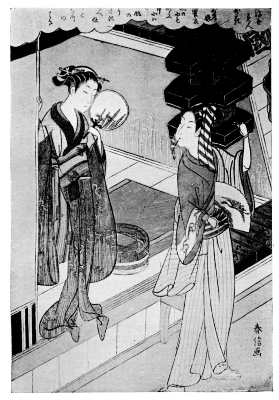
Plate 12.
The old three-colour prints had achieved fine effects by means of powerfully conceived but essentially simple mosaics of colour. Now Harunobu turned the three-stringed lute into the violin, capable of expressing the most delicate modulations of tone. Beginning with combinations of only four or five colours, he gradually increased the number of blocks used. It is certain that he used eight blocks on at least one 1765 calendar print. In the end he had at his command a palette which, by the use of no less than twelve or fifteen blocks, and with the limitless number of shades obtainable by superimposing one colour upon another, made the whole rainbow his. Constant experiment marked his further progress. We have, for example, one print which he originally printed from eight blocks, and later varied by increasing the blocks to ten, and still later to thirteen. From year to year an ever fresh succession of complex colour-harmonies emanated from his fertile brain.
Until the invention of polychrome printing, Harunobu had not adequately expressed himself; now, having found his true instrument, he played divinely. The year 1765 was a Jubilee year, celebrating the nine-hundredth anniversary of the entrance of Sugawara Michigane, the great statesman, painter, and humanist, to the Court of the Emperor. This circumstance, in connection with the desire of literary men to present to their friends specimens of the new prints as New Year cards, led Harunobu to produce a number of dated calendar-prints of this year—a fortunate occurrence which has been of great aid{144} to students of his work. The theory that these dated prints are the expression of Harunobu's naïve exultation over the new discovery is now generally discredited. Since the calendars are dated 1765, Mr. Gookin's suggestion that they were probably made in the last months of 1764 seems reasonable; and this date must therefore be regarded as marking the beginning of polychrome printing.
The brilliant new prints fittingly ushered in the festal year. And the public was not too busy with its celebrations to take note of the change. The new manner with its wealth of colour-beauty won instant popularity; and under the name of "Brocade Pictures of the Eastern Capital" grew to such fame that by 1767 prints in the old style were almost driven out of the market, and Harunobu was unquestioned lord of Ukioye.
It is not strange that in the glow of success and ambition he should have put behind him his old actor-pictures. "I am a Japanese painter," he wrote proudly; "why should I paint the portraits of this vulgar herd?" And at this moment feeling himself akin to the great classical tradition whose refined beauties had been handed down from ancient China mingled with the beauties of poets and sages, he determined that he would lift from the Ukioye School the stigma of vulgarity which the theatre had given it, and invest it with some of that gentle cultivation which fills like light the old Chinese paintings of Ming gardens. Therefore he turned his energies to the depiction of another world than the theatre—the life of aristocratic ladies, of young{147} lovers, of those famed beauties who in humbler station were the flowers and sunshine of the tea-house and the festival. Plate 14 portrays one of these. His method of handling the figures—a peculiar mingling of naïveté and sophistication, like that of a minstrel singing incredible enchanted legends with complete seriousness—was a new and never-recovered note in the history of Ukioye.
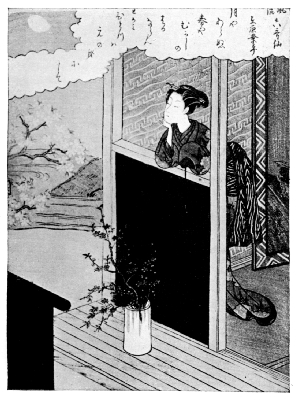
Plate 13.
From this time on, during six years, Harunobu produced a series of prints whose grace is unsurpassable. The firm and refined strokes of his brush endowed with a fresh charm all that was lovely in the flowing draperies and serene faces of the young girls of Japan. He was the painter of youth. The type which he introduced was the slender and gracious embodiment of youthful girlhood. And an indescribable delicacy and purity of manner clothes as with clear light these girl-figures of his. His draperies, as in Plate 11, are never drawn naturalistically, but always with a certain conventionalization that produces folds and swirls more abstractly beautiful than a literal rendering. He for the first time in colour-printing made a practice of giving to his figures a background that exhibited fully the scene of their daily lives. Instead of the heroic figures of the Primitives, stalking through space in colossal grandeur, he drew the familiar forms of everyday existence nestling among their natural surroundings. The world he pictures is, however, one of mortals who hardly know the burdens of mortality. Like the women of Botticelli, they seem to poise in an atmosphere of more rarefied loveliness{148} than anything we know in reality. Rich as may have been the beauty of the tea-house girl, O-Sen, whom Harunobu loved and painted, and of the little seller of cosmetics, O-Fuji, who appears many times in his pictures, they were but the starting-point, the exciting agency, from which Harunobu passed on into a secret fanciful world of his own to evoke his dream-maidens. Half of the charm of these figures, such as the one in Plate 12, lies in this unreal and unhuman impression they make; they are not Japanese women or any women, but living fairy-tales, butterfly creatures out of nowhere. All that is joyous and playful in the Japanese spirit lifts them on wings of fantasy into regions of universal delight. They are the most fragrant flowers of Japanese art.
It follows that Harunobu's subjects are almost always light and trivial scenes—a girl playing with a cat, a young man and a maiden walking amiably together, young girls engaged in some delicate occupation, or, as in Plate 13, pausing in pensive reverie. A gentle joy pervades most of them, or at least a gravity so light that it is nearer joy than melancholy. Harunobu does not handle these scenes with any especial insight into life; they are not windows through which we may look and see the human souls of the people he portrays. They are nothing more than gay, pleasing moments—records of fortunate hours—froth and foam over the real deeps of life.
Yet as the spectator allows the pure and delicate atmosphere of one of these creations to enter his spirit, he gradually becomes aware that not this{151} trivial scene, not this light episode, was Harunobu's real theme; his real theme was the great harmonics of colour and line. Out of colour and line his immeasurable genius evoked lofty improvisations. He dedicated the fervour of his passion and his vision to the creation of these orchestrations of tone, these modulated arabesques of contour. Beyond his cheerful groups, beyond his felicitous arrangements, lies the history of his prodigious essay to impose his sense of beauty upon one section of chaos. Kurth is quite right when he calls him "the great virtuoso of colour."
Most of Harunobu's prints are of small size, almost square. In this form his refinement found its most perfect expression. If we would see an aspect of Harunobu that is of more impressive proportions, and realize that scope as well as daintiness was in him, we must turn to certain rare pillar-prints which were done chiefly in the years immediately preceding his untimely death. Here dignity combines with grace, and an exalted sweep of composition adds nobility to that exquisite colour which here no less than in his small prints finds place. Two of these pillar-prints, reproduced in Plate 15, may serve to illustrate this last phase of Harunobu's greatest triumph.
The first print is a soft grey and lavender study of a girl. Within the long, narrow space, against a background of cool unbroken grey, rises the figure, whose bent, pensive head looks down at the ball she is dangling before a cat at her feet. Her hair, a mass of strong black against the clear grey background, is drawn in a conventionalized manner that{152} is perhaps the noblest formula ever devised for the painting of hair—as pure of line as a Greek helmet. Drooping from her slender shoulders fall robes whose slow curves seem moulded by the touch of faint and gentle airs that breathe around her. The long drapery is interwoven with hints of mauve melting into rose—more like ghosts of the palette than colours—and touches of translucent salmon and amber and grey are repeated like an arabesque of lights down the folds. The folds sweep in great restful curves like those of vines hanging in festoons from summer branches. At the girl's girdle a strong note of dull green strikes like a bass chord across the composition; and smaller spots of the same colour carry this motive diminishingly down to the bottom of the picture.
It is a sentiment, an emotion, a dream—as much an abstraction as a musical composition. In the lines of the dress, in the poise of the head, in the limpid tones of the whole picture, is secreted the dwelling-place of a peace, a solemnity, an awe never to be forgotten. It is reminiscent of the grandeur of the Primitives, but more etherialized; and there lingers about it still, persisting from earlier times, the penumbra of that hierarchal purity and spirituality peculiar to archaic art. Like those strange and memorable archaic statues of the Priestesses in the Museum of the Akropolis at Athens, like the frescoes of Giotto at Assisi, it holds the secret of an untainted beauty that is lost to later artists.
Plate 15.
The second pillar-print is one which, following the opinion of Professor Fenollosa and Mr. Gookin, may be regarded as one of the supreme triumphs of{155} Harunobu's career, and one of the greatest prints we know. It represents Shirai Gompachi, the white-robed lover of the beautiful Komurasaki, wandering in disguise with the basket-hat and flute of a komuso or dishonoured Samurai. There is no background; against the clear white paper the long lines of the tall figure flow in curves of jet black and purple-grey, with here and there lights of orange and white. By a simplicity of selection that is more than Greek, Harunobu has woven from these few curves an effect that is like an incantation. It has in it the power to reach into the secret storehouses of the spectator's emotion and awaken echoes from those intimations of eternal perfection which haunt every heart. Fenollosa writes: "There is something unearthly about its line themes, orchestrated in black and ghost-tints, which lifts one to the infinities of Beethoven's purest melodies. The dreamy clarinet-player seems to droop and melt away into regions of sublimity where no earthly ear shall follow his dying chords. Thus indeed we are glad at last to have Harunobu pass, transfigured, from our vision."
Pillar Print by Harunobu.
Certain puzzles for the collector and student arise in connection with Harunobu.
This is the first knotty point. Shiba Kokan, a contemporary artist who outlived Harunobu by forty-eight years, is obscurely connected with Harunobu's work. "Look out when you buy Harunobu prints!" he writes in his memoirs, published long after his death. "A great portion of the most popular ones are skilfully forged, and the forger was I, Shiba Kokan!" This warning holds good to-day, and in many cases no one can say with confidence whether certain sheets are by Shiba Kokan or Harunobu. Kokan claims, in particular, to have been the author of those with transparent draperies, those done in the Chinese manner, and those in which snow on bamboos is rendered by embossing without outline blocks. All these and other characteristic beauties of Harunobu's work he would annex, and it is doubtful if we shall ever know whether he is the greatest liar or the greatest forger in history. Probably his statements must be regarded as partly true. Until we know, however, every print signed Harunobu is suspect; for if Shiba Kokan could deceive the public of that day, we shall not be likely to detect his forgeries. There is only one consolation for the collector: if the prints of Shiba Kokan, signed Harunobu, are as beautiful as those of Harunobu, then not the collector is the sufferer, but only the unfortunate person who tries to write an accurate account of this hopeless entanglement.
Other forgers, contemporaneous or slightly later, probably took advantage of Harunobu's popularity:{157} coarse reprints from recut blocks turn up frequently in the market; and, worst of all, very fine modern forgeries and imitations of his work abound. These last two classes are the only ones that need cause the collector anxiety; they should of course be guarded against with the utmost care, for they are quite worthless. Their impure and muddy colours generally betray them to the practised eye. No means of detecting them is safe for the inexperienced amateur except a minute comparison with an unquestioned original impression of the same print. On the other hand, the contemporaneous forgeries, if beautiful, are no inconsiderable treasures.
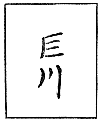
The name Kyosen furnishes another puzzle. It is signed to prints unmistakably by Harunobu, to prints unmistakably not by him, and to prints which he also signs. The solution seems to be that Kyosen is simply the name of the printer or engraver who did work for Harunobu and for other designers. Kyosen himself sometimes designed prints, but in such cases he signed distinctly as artist. The signature Kyosen does not, therefore, indicate a separate artist, and its presence on Harunobu's prints need not cause doubts as to Harunobu's authorship. Senga, a printer, and Takahashi Gyokushi and Takahashi Rosen, engravers, also signed certain of Harunobu's prints.
A further difficulty arises in the relation of Harunobu to Koriusai, an artist whom we shall{158} soon treat by himself. At times his work comes so close to Harunobu's style that earlier authorities believed his name to be merely a later signature of Harunobu. This position is now entirely discredited, and it is agreed that Koriusai was a distinct person, a friend and successor of Harunobu. But it is not so sure that Koriusai may not have signed certain of his own designs with Harunobu's name after Harunobu's death; the striking resemblances of some such sheets to Koriusai's work makes one unwilling to regard the relation between the two as settled. In the case of certain unsigned prints, it is impossible to determine with assurance which of the two was the creator. As a rule, however, the colour-schemes of the two are totally different, Koriusai running characteristically to schemes in which blue and orange are dominant. Dr. Kurth seems to think it barely possible that prints signed "Koriu" may be by Harunobu; but this theory is untenable, both because the internal evidence of the prints is against it, several of Koriusai's most characteristic prints being thus signed, and because of the difficulty of believing that Harunobu, the greatest of living Ukioye artists, should at the height of his fame have signed to his work the name of a younger and less noted contemporary.
Those prints in the Harunobu manner which are unsigned and unsealed also offer perplexities, since we must look entirely to internal evidence to discover whether they are by Harunobu.
Harunobu's work is among the most highly prized in the whole list. The great collections have many{159} of his prints, but in the market one finds the fine ones to be limited in number. In his case, even more than in the case of other artists, perfect condition is a vital requirement. For, in the process of fading, his prints lose that delicate colour-orchestration which is their supreme glory. The same changes in tone that would hardly detract from the beauty of a fine Kiyomitsu might easily rob a fine Harunobu of most of its significance. If one has once seen the copies in such collections as that of Mr. Frederick W. Gookin, of Chicago, Mr. Charles H. Chandler, of Evanston, Messrs. William S. Spaulding and John T. Spaulding, of Boston, or Mr. Howard Mansfield of New York, one loses all interest in the battered riff-raff of the dealers' counters.
Koriusai speaks.
Koriusai's life is shrouded in those mists prevalent in the cases of most Ukioye artists. It is known that he was a Samurai, or feudal retainer of knightly rank; upon the death of his master, Tsuchiya, he became, as was the custom, a ronin—that is, a retainer without a lord—and established himself near the picturesque Ryogoku Bridge in Yedo as a painter. He originally used the name Haruhiro. Shigenaga was his first teacher, Harunobu his second; his work can safely be dated between 1770 and 1781. By the end of this period Kiyonaga was beginning to advance achievements that eclipsed Koriusai's. As Fenollosa points out, it was Koriusai's misfortune to collide with Harunobu at the beginning and with Kiyonaga{163} at the end of his career; could we obliterate those two, we might think of Koriusai as "the most beautiful Ukioye designer."
Plate 16.
Koriusai was already working in Harunobu's manner at the time of the master's death; and afterward he continued Harunobu's experiments. His characteristic device in colour is the predominance of a strong orange pigment, based on lead, which when originally applied had the utmost brilliance, but which now is frequently changed by chemical decomposition into a rich mottled black. Combining this orange with a blue of his own devising, he obtained novel and striking effects.
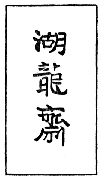
Koriusai's small prints have often a beauty almost equal to Harunobu's, but they lack individuality of invention. They never surpass the triumphs of the older master in this form. Koriusai seldom can catch Harunobu's perfect grace and repose, his luminous atmosphere and subtle colour. But in his large sheets he produced a few compositions whose elaborate magnificence is a new and individual achievement. The styles in hair-dressing which came into vogue at this time were no small element in enabling him to create his stately figures; the wide lines of the coiffure, more solid and massive than in Harunobu's day, lent itself admirably to strong decorative treatment. In a series of large sheets called "Designs of Spring{164} Greenery," each picture representing an Oiran and her two or more young attendants, some of the prints are disfigured by the heaviness of the faces; but others, from which this exaggeration is absent, are of almost unparalleled splendour in colour, even though somewhat monotonous in their repetitions. One of this type, in the Morse Collection, Evanston (described at No. 155 of Fenollosa's Ketcham Catalogue) is surely one of the greatest prints in the world. Some of Koriusai's designs of birds and other animals, occasionally printed with mica backgrounds, are admirable compositions.
But Koriusai's distinctive glory lies in the sphere of pillar-prints, of which five are reproduced in Plates 16, 17, and 18. This form of composition is one of the most interesting and exacting to be found in the art of any race; the tall sheet, generally about 28 inches high and only 5 inches wide, furnishes a mere ribbon of space that taxes all the resources of a designer. It is like a Greek frieze placed on end; but whereas the frieze gives space for a multitude of processional figures, and is essentially a stage for the depiction of a social pageant, this slim panel demands the exclusion of all but a few significant lines. In this particular it is the finest of art-forms. It exacts the quintessence of selection—one narrow glimpse of some cross-section of life. Its limitations are like those of the lyric, requiring a concentrated and finely chosen vision.
Plate 17.
The shape was first devised by Okumura Masanobu as a modification of the wider and shorter sheets commonly used by the Primitives for their large pictures.{167} As is often the case in the evolution of a fine art-form, it was not Masanobu's mere whim, but structural exigencies, that prompted the invention, the need being to provide long narrow pictures that could be hung upon the square wooden pillar of the Japanese house. Kiyomitsu and Toyonobu used this shape admirably; and the final and most perfect form for its dimensions was fixed and brought into general use by Harunobu. It became a favourite shape among the greatest of the later artists; and no small number of their supreme achievements are in this form. To the modern European eye, no other seems so distinctively characteristic of the special Japanese genius.
Pillar-prints are almost invariably works of the first importance—pièces de résistance, deliberate and studied productions, representing the best effort and highest powers of the artist. For they were intended to be mounted and rolled, like kakemono; and the artist could therefore foresee for them a degree of attention that he could hardly expect in the case of the loose square sheets. The peculiar shape is in itself so interesting and beautiful, and so ringing a challenge to the powers of the designer, that in many cases the best work of the artist is to be found only in this form.
Pillar-prints are to-day far rarer than prints of the square variety. They were probably produced in editions of smaller numbers than the square prints; and, further, the use to which they were put as hanging pictures exposed them to hazardous vicissitudes and generally resulted in eventual destruction.{168}
Koriusai's variations on the limited themes whose treatment is possible in this narrow space display daring, originality, and power of concentrated selection. He is the supreme master of the pillar-print; no one else has produced so many fine ones, and practically all his finest work is in this form. The infinite variety of his designs and the fertility of his invention make a series of his pillar-prints one of the most absorbing features of a fine collection. In one print (Plate 17), he dashes the intense black line of a screen down through the middle of his picture and sets the delicate eddies of a child's and a young girl's garments playing around its base. In a second (Plate 18), a girl in robes of gorgeous colour stands like a calm peacock, with glowing orange combs alight in her hair; while in a third (Plate 16), the whole space waves and sings with the forms of grasses, a flying cuckoo, and a maiden carried in the arms of her lover through fields of spring. And in a fourth (Plate 17), he draws the figures of two women, one behind and a little above the other, the one in the background luminous with soft neutral tints, the one in the foreground robed in a black whose intensity cuts sharply through the otherwise monotonous sweetness of the picture. To the grace of Harunobu, Koriusai has here added a vigour all his own, and a richness surpassing that of his teacher.
To-day Koriusai's small prints are rather rare, as are also the birds and the large-size sheets. His pillar-prints, which are his greatest works, were produced in such numbers that, contrary to the rule that applies to the pillar-prints of all other designers,{171} a good many of them have survived. It is still possible to secure examples that are among the foremost of all print treasures.
Plate 18.
Susuki Harushige is reported to have been the son and pupil of Harunobu. The few prints of his that are known have a grace of line that might well be a son's heritage, if such things were inheritable. The unholy rascal Shiba Kokan alleges that this name was one which he himself used, as well as Harunobu's; it is reported, on the other hand, that it is merely Koriusai's early name. It is probable that Kokan's statement must be believed.
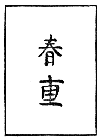
Shiba Kokan has already been mentioned as the forger of Harunobu's work. His ability needs no further recommendation when we admit that we cannot with certainty tell his prints from Harunobu's. This is his chief title to fame. He was born in 1747 and died in 1818. During his life he signed many names to his work and attempted many manners. From the Dutch at Nagasaki he learned something of the rules of European perspective, and tried, in the eighties, with success but without much beauty, to carry them over into Japanese art. In addition, he introduced shadows into some of his compositions—a device alien to the whole spirit of Chinese and Japanese painting. He was the first Japanese artist{172} to attempt copper-plate engraving. Queer renderings of European scenes by him remain to us. In a hundred different spheres of art, invention, and speculation he tried his hand. His intellectual curiosity in every field reminds one of Leonardo da Vinci. He remains one of the most interesting and puzzling figures of his time—an adventurer, a restless experimenter, a forger and a man of extraordinary though chaotic genius.
A poem written when he was dying has a curious vibrancy: "Kokan now dies, for he is very old; to the passing world he leaves a picture of the world that passes."
Komai Yoshinobu did work in the style of Harunobu during the seventies. He furnishes another example of the obscurity that covers so much of Japanese print history; for it is not known whether he was an independent artist, or identical with Yamamoto Yoshinobu, who produced two-colour prints in the fifties, or worse yet, an early signature of Koriusai. The first theory is the most probable. His work is rare, beautiful in colour, and well worthy of further research.
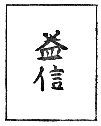
Masunobu, the second of that name, whose work, in clear, delicate colour and charming arrangement, generally follows Harunobu's closely, is also not definitely located. He appears to have been originally a pupil of Shigenobu and Shigenaga. Most writers erroneously regard him as the same man who, under the name of Sanseido{173} Tanaka Masunobu, produced two-colour prints in the forties, and hand coloured prints still earlier.
One of the Second Masunobu's pillar-prints, representing a girl with an open umbrella jumping from a balcony to meet a waiting lover, has a unique and most charming individuality of poise and colouring. His pillar-prints, of which about ten are known, are particularly fine.
Ujimasa, Kamegaki Hoōriu, Muranobu, Tachibana Minko, Banto, Chiryu, Ryushi, Kisen, and Suiyo are rare men who worked contemporaneously with Harunobu. The Hayashi Catalogue also names Shoha, Soan, Sogiku, Kogan and Seiko.
Kuninobu is an artist of extreme rarity, whose few surviving prints show distinction of line, based on the Harunobu manner. His work, done about 1775, stands out from the work of Harunobu's horde of followers; he was evidently a noteworthy artist, of whom one wishes we knew more.
Fujinobu worked in the manner of Harunobu in the early seventies. His output was small, and little of his work survives. It may be that he was the same individual as Yamamoto Fujinobu, who has already been mentioned as Shigenaga's pupil.
Komatsuken is a name signed to certain calendar-prints for the year 1765. The style is greatly like Harunobu's. His name may also be read Shoshoken. Mr. Gookin thinks him to be identical with Fusanobu, who has been previously mentioned.
Harutsugu and Susuki Haruji, said by some to be the same person, produced a few pleasing prints about 1770.{174}
Portrait of an Actor in Tragic Rôle.
Those actor-types which Harunobu and his school so scornfully cast aside became the chosen speciality of the greatest of his rivals and contemporaries, Katsukawa Shunsho. As one examines sheet after sheet of Shunsho's theatrical prints, Harunobu's contemptuous words concerning "this vulgar herd," the actors, lose their significance; for here pass in gorgeous procession a series of lofty, intense, and unforgettable figures charged with the quintessence of heroic force.
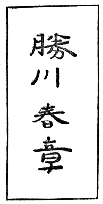
The designer of these prints was born in 1726 and died about 1792—some authorities say 1790. His period of greatest activity covered the years 1765 to 1780, thus including the working periods of both Harunobu and Koriusai, and ending as Koriusai's did when in the eighties Kiyonaga's star rose blindingly. He lived for a while at the house of his publisher, Hayashi; sometimes in his early work he used in place of a signature a seal shaped like a small covered jar with handles, on which Hayashi's name is inscribed. The legend is that he was too poor to own a seal in the early days of his struggle and so borrowed that of his landlord!
Shunsho had no antecedent teachers among the print-designers. He sprang instead from a school of painters who did not design for prints. These, headed by Choshun and his son Katsukawa Shunsui,{178} had since 1700 been producing rich paintings of women in elaborate drapery. The Buckingham Collection contains one print by Shunsui, but it is an almost unique rarity. Shunsho, by a curious shift in the stream of art history, not only took up prints, but even took up the department of prints least in line with the tendencies of his own school, the department of actor-representation, which was the speciality of Kiyomitsu and the old Torii School, and which Harunobu's popular innovations had almost driven out of fashion. To this work Shunsho brought the new technique of Harunobu and great native individuality; and with the fresh armament of full colour he defended magnificently the threatened stronghold of actor-prints. His popularity became enormous. He grew quickly to the stature of one of the great and far-reaching powers in Ukioye history. Side by side with Harunobu, he in his separate field executed year by year actor-portraits which by their vigour of line and brilliancy of colour-combination take a place as high as that held by the works of his rival.
No contrast could be more striking than that between them. The one is all grace, the other all force; the one loves to linger in quiet gardens, the other drags us up to the icy heights of tragic crisis. Shunsho's sense of dramatic composition was keen; and, as we see in Plate 19, his ferocious actor-faces peer out with a vivid menace, his tense actor-limbs shake with a concentrated and imprisoned fury not the less impressive because of its intentional exaggeration. They have not Harunobu's unreality of{181} perfect grace, but the utterly different super-reality of magnified passion. In repose they are like statues; in action they have the vigour of those natural forces—waves, river currents, storms of thunder—which, as in the Shunsho print reproduced on the cover of this volume,[Transcriber's Note: The edition used to produce this etext did not include this print on the cover.] so often form their backgrounds.
Shunsho's figures of women—or rather his figures of men acting the parts of women, according to the invariable custom of the Japanese stage at this time—are less violent, but often as tense. Two of these appear in Plates 20 and 21. In long sweeping robes of brilliant dye they move with the step of a Clytemnestra, or poise in strange attitudes of arrested motion not unworthy of an Antigone. All his figures are dynamic—the storehouses of volcanic forces whose existence he suggests by restless line-conflicts.
Shunsho's predecessors in actor representation had never equalled the intensity of these figures and faces. Shunsho tears the heart out of a rôle and holds it up for us to see. He gives the passion of the actor such expression as would have been impossible to Kiyonobu, twisting the face into a distorted and grandiose mask beside which the faces of the Primitives seem wooden and meaningless.
The spectator whose æsthetic sense embraces only a love of tranquillity will find no beauty in these disturbing faces and forms—unless perhaps the beauty of pure colour is enough to beguile him. It may well do this; few things have power to bring a richer sense of æsthetic satisfaction than a succession of{182} fine Shunshos, in each one of which a new colour-arrangement unfolds new harmonies.
Shunsho's work includes a very great number of actor-prints in the narrow upright hoso-ye form and a few large square prints. He also issued a series of small illustrations for the "Ise Monogatari," an old romantic chronicle which furnished many favourite subjects to the artists. These are quiet in design and soft in colour; to them the eye may turn for rest if wearied by the straining actors. In collaboration with Shigemasa he produced a set of ten small prints representing sericulture, which have considerable charm. In 1776 the same pair of artists brought out a series of book-illustrations called "Mirror of the Beauties of the Green Houses," representing groups of courtesans occupied with the various activities of daily life—in the street, the house, the garden, and the temple. This book has been called the most beautiful ever produced in Japan; when one examines its chief rival, "The Mirror of the Beautiful Women of the Yoshiwara," by Kitao Masanobu, one need have no hesitancy in giving Shunsho's and Shigemasa's the first place. This means, very probably, the first place among the illustrated books of the world. Its pages, printed in rose, purple, brown, yellow, and grey, are rich and delicate. Sheets from all these books are often found mounted as separate prints. Shunsho's few known pillar-prints are generally magnificent.
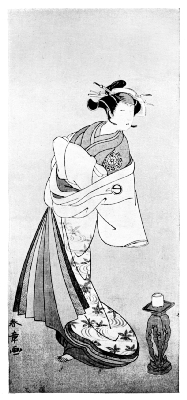
Plate 21.
Because of his enormous productiveness, Shunsho's work in hoso-ye form is common, frequently in fine condition. Most of the hoso-ye prints were originally{185} issued in joined groups of three; the groups are seldom found intact now. The grace of his women has made them more generally popular than his impressive men, and they are consequently harder to obtain. It must be noted that Shunsho's work is uneven, and that the majority of the pieces offered are either tame and uninteresting examples of pot-boiling or caricatures that lack the intensity which lifts certain of the artist's most grotesque figures to tragic heights. The matchless Shunsho collection of Mr. Frederick W. Gookin is full of such prints as rarely come into the market to-day. Occasionally the more distinguished ones are met with; and they are treasures which the practised collector eagerly seizes. Fortunately print dealers are not, as a rule, conscious of the greatness of the difference, and they will frequently offer side by side a print that is merely one of Shunsho's commonest pieces of hack-work and a print that is one of the glories of the Ukioye School. On such occasions the collector has the pleasure of profiting by his own discrimination.
Shunsho's large square prints and pillar-prints are of extreme rarity.
Connected by association with the school of Shunsho, yet lifted by his originality to a place quite apart from it, is the artist Ippitsusai Buncho. His master, a certain Ishikawa Kogen (or Yukimoto) of the classical Kano School, seems to have meant little to him; from the beginning of his production,{186} about 1765, Shunsho's and Harunobu's influence chiefly guided him. He and Shunsho jointly published in 1770 three volumes of actor-portraits enclosed in fans. Little is known of his life except that he was originally a Samurai; he is said to have turned from his original master to the Ukioye School and to have led a life of dissipation until eventually his friends persuaded him to abandon such things and procured for him the honorary title of Hokyo. After this, we hear nothing of him. He died in 1796.
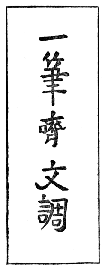
Buncho's work attracts the observer with a charm different from that of any other Ukioye artist. A curious mannerism in his way of drawing faces and a fascinating perverse grace in the attitudes of his figures mark his prints. Practically all his work is in the hoso-ye form. His subjects are chiefly young male actors in the rôles of women. Harunobu's influence, manifest in Plate 22, brought him grace but not sweetness. There is an astringent quality in his work that prevents it from ever being serene. His figures, whose line-work is the apotheosis of suavity and studied refinement, are arched into slightly strained and tortured attitudes; complex forces seem to dominate them like unseen winds; consuming or delicate passions move obscurely{189} through their limbs and faces. Their heads poise at unnatural angles as if consciously turning their indifferent eyes from the spectacle of common things toward a secret and hypnotizing world of their own. These alien beings haunt one; it seems as if they had some mystery to reveal, some disturbing wonder to communicate could one but make them speak.
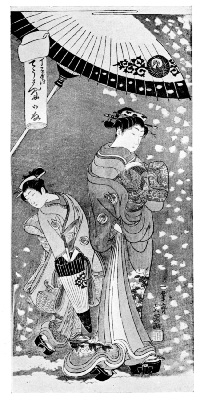
Plate 22.
Part of Buncho's strangeness lies in the fact that he seeks for his figures not a human but an abstract and geometrical grace. His famous print, often reproduced, of the actor Segawa Kikunojo as a lady in white carrying an orange umbrella beneath a willow-tree, is a study in the harmonics of pure line; to this end every other element of representation has been sacrificed. Line exists here not merely to bound a form but for its own inherent beauty. Buncho is the greatest of all masters of the geometry of lines and spaces; these have, as he arranges them, the inevitability and clarity of a mathematical demonstration.
His use of colour is equally notable and strange. By employing tints that are almost discords he produces arresting and fascinating effects. His combinations of orange and slaty grey, or dull red and slaty blue and pale yellow, or pink and purple, have an uncanny vibrancy that makes them stand out in one's memory.
Buncho's strangeness has a further aspect. There is in him an intangible spiritual abnormality. I am led to localize this in his portraits of the actor Segawa Kikunojo, and to imagine a curious relation between the two. Some of his portraits of this actor are the{190} flower of his work. In them appears a passionately rarefied beauty; they have an unusual pitch, like the overstrained vibration of violin strings stirred by some heavy blow. Segawa Kikunojo was the foremost woman-impersonator of his time. His grace in such rôles is attested by prints from the hands of many artists; but none rise to the unearthly beauty of Buncho's. Even if we knew nothing of the life of the Japanese stage at this time, or of the custom of actors like Segawa Kikunojo to dress and live like women when off the stage, we might still be put on inquiry by the peculiar ethereal quality of some of these portraits. For art whose initial impulse lies in morbid regions often flies into regions of the most disembodied spirituality for expression. Flowers of the morass frequently have a pale delicacy that is alien to the flowers of the field.
It is, however, with a confession of fancifulness that I reconstruct the following story to account for Buncho. He, a Samurai, was driven by keen artistic sensibility to the study of painting under a classical master. From this studio he was lured by the glitter and glamour of Ukioye into the world of prints and actors, and sank into a slough of dissipation above which gleamed the balefully beautiful star of Segawa Kikunojo. Haunted by a perverse susceptibility, his tense-strung nerves vibrated at that morbid touch into notes of such disembodied sweetness as the world has scarcely known elsewhere; and at last he passed into retirement and death, still the puppet of a disturbing illusion. He was an unbalanced temperament, a dreamer of keen and attenuated{193} beauty that has nothing in common with the normal wholesome life of earth.
His prints are exceedingly rare; many a good collection possesses not a single fine specimen of his work. I had never seen or heard of a pillar-print by him until very recently; but lately an interesting one has been found in Japan.
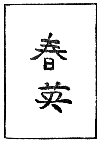
Shunsho's vigorous style had many followers, among whom Shunyei is commonly regarded as the most important. He was born in 1767, and lived until 1819. His teacher Shunsho's manner dominated his work from his earliest years, though some late sheets exist in which he followed Kiyonaga. It is believed that originally he used the name Shunjo; fine work is extant with that signature. He had many pupils, and was himself an able painter; but his ordinary work is largely derivative. At times, however, his hoso-ye actor-prints achieve an effect of great power by the use of large masses of colour. He had a certain sharpness of observation—a certain knack of catching in his portraits the peculiarities of his models, that produces an effect less dignified but more vivid than Shunsho's. A sense of humour glimmers through his rendering of some of these keenly drawn and intimately characterized actor-faces. Unmistakable as may be{194} the features of a Danjuro or a Hanshiro drawn by Shunsho, one nevertheless feels that the personality of the actor has been largely dominated by Shunsho's supreme interest in the passion or terror of the rôle; and though he pictured the face of the actor, the spirit which he sought was wholly the spirit of the part. Shunyei, on the other hand, often managed to retain the idiosyncrasies of the sitter and his peculiar spiritual flavour; and though his works are not often as beautiful as Shunsho's, they are frequently more human. On the whole, we may say that Shunsho created generalized types, Shunyei reproduced observed individuals.
Shunyei produced, besides the actors in hoso-ye form by which he is best known, a few large heads and full-length portraits of actors marked by a strength of drawing and a breadth of characterization different from his usual work. One of these is reproduced in Plate 23. On a grey background, this powerfully designed figure stands out with gigantic simplicity in masses of dull colour. The prints of this rare type are perhaps Shunyei's best. Beside them must rank the large actor-heads, interesting to the collector because of their relation to the work of another great artist, Sharaku. It is still uncertain whether Sharaku or Shunyei was the inventor of this type of large bust-portrait. Dr. Kurth assumes, for the greater glory of Sharaku, that he was the precursor; but the question cannot be regarded as settled.{195}
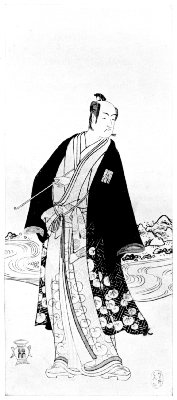
Plate 24.
The equal of Shunyei among Shunsho's other pupils is to be found in Katsukawa Shunko. He was the spiritual image of his master, except that he had not his master's full command of terror. His figures, as in Plate 24, poise or sway with gentler emotions; as a rule, they are agreeable rather than impressive. One comes to recognize him frequently by the peculiar suavity of his designs. It is true that he sometimes approaches very near to Shunsho's power; but this is less characteristic and less interesting than his quieter manner. It is unnecessary to treat of him at great length, for most of his work is of a type whose main qualities have been treated fully under Shunsho. It is not known when Shunko was born; he died in 1827.
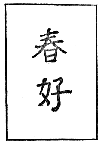
It may be noted that he sometimes sealed his prints instead of signing them, using a jar-shaped seal much like that which Shunsho had made famous.
In the Spaulding Collection, Boston, is a remarkable full-size triptych by Shunko, representing a party of actors picnicking in the country. The style shows it to be greatly influenced by Kiyonaga; and the whole composition of this beautiful piece is different from most of Shunsho's work.{198}
Shunri was another pupil of Shunsho; he appears to have been a competent designer, but no great figure. Shuntoku, Shunki, Shunkaku, Shoyu, Shunyen, Shunken, and Shunkyoku may be described in the same words. Each has perhaps produced a few beautiful works, but their originality is not marked.
Rantokusai Shundo, a gifted pupil of Shunsho, has left work so rare that one cannot make any very definite statement about him. His few known prints are admirable. One suspects that this signature is merely the early name of some well-known artist.
Shunsei, Shunrin, Sobai, and Shunkio are later artists; their importance is small.
Shuntei, "owing partly to illness and partly to systematic indulgence in drink" (Strange), and partly to complete lack of natural distinction, produced nothing of interest; and his coarse battle-scenes may be classed with the crude work characteristic of a later period. He worked chiefly between 1800 and 1820.
Kincho Sekiga is said to have been a pupil of Buncho.
Shunko II was a pupil of Shunyei. His name is written in different characters from that of the first Shunko. Kichosai Shunko also produced actor-prints.
Yumisho was a very rare pupil who adopted Kiyonaga's style in line-work. The same may be said of Yenshi, some of whose work is very beautiful;{199} he appears to have come much under the influence of Yeishi. Several of his triptychs are fine.
Utagawa Toyoharu is a strangely equivocal figure in print history; his fame is great, but no surviving print of his, so far as I have been able to ascertain, is of a quality to justify fully his reputation. Born in 1733, he studied with Shigenaga and probably with Toyonobu, produced a limited number of prints in the sixties and seventies, withdrew from prints to painting when Kiyonaga's new style grew to splendour, and died in 1814. He is said to have been a sensitive and delicately strung individual who shrank from competition and worked obscurely. His best-known work is a series of twelve designs for the various months done in collaboration with Shunsho and Shigemasa; each print is divided diagonally into two scenes—a device of unfortunate and ingenious ugliness. The figures, however, have a certain delicate grace. His pillar-prints, which are rare, have considerable beauty.
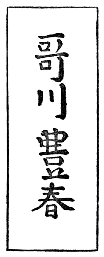
Toyoharu has been called a greater artist than Shunsho. It may be true, yet I am inclined to regard this view either as the result of his painting{200} and not his print-designing, or as part of a great Toyoharu myth, for which the later success of his pupils is responsible. Certain it is that of his surviving prints few are noteworthy, and that he was greater as a painter and teacher than as a print-designer. We shall remember him more as the instructor of Toyokuni and Toyohiro and as the precursor of Hiroshige than for any of his own prints that remain to us.
As a figure-painter, he is known as the founder of the Utagawa School. As a landscape-painter, he made successful use of European perspective, which he probably learned from Dutch engravings, and was perhaps the first Ukioye print-artist to return to the habit of the older schools and treat landscape not as a mere setting but as a thing by itself. His scenes are too stiff and too crowded with petty details to lay any real claim to beauty. He used as the dominant note in many of them the orange colour so dear to Koriusai; but no pigment can well be imagined that is less fitted for landscape-rendering. Yet the historical importance of these prints is great; for they are, so to speak, the grandparents of the marvellous landscapes of Hiroshige.
Utagawa Toyonobu is believed by some authorities to have been merely Toyoharu's early name; others think him identical with Ishikawa Toyonobu; and still others regard him as an independent artist who was a pupil of Ishikawa Toyonobu, his greater namesake. The few prints we have by him—I know of less than half a dozen—are not sufficient to enable one to form an opinion as to this.{201}
Toyomaru and Toyohisa were among Toyoharu's pupils.
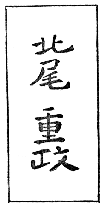
Kitao Shigemasa may be called the great chameleon of the Ukioye School: a discriminating chameleon, who chose only the greatest artists of each decade from whom to take his changing hue. As M. Raymond Koechlin expresses it, "it was his destiny to reflect in his art the art of the most original of his contemporaries." Born about 1740, he lived until 1819. His teacher was Shigenaga; this master died not long after Shigemasa commenced work with him. Thus Shigemasa began painting early enough to be influenced by the last of the Primitives; and his first prints, dating from about 1764, are graceful three-colour renderings of actor-themes in the manner of Kiyomitsu, and more brutal ones in the manner of Kiyomasu. With the rise of Harunobu and the perfection of polychrome printing, Shigemasa turned to that style; later he followed Koriusai, in whose manner he produced some wonderfully beautiful large sheets of women and some fine pillar-prints. Still later he followed the style of Shunsho. Together with this artist he produced in 1786 a set of ten small sheets representing the various stages of sericulture, in which he surpasses his collaborator. The same two artists had{202} earlier collaborated, in 1776, to produce the famous illustrated book "Mirror of the Beauties of the Green Houses." These illustrations are not signed; but comparing them with Shigemasa's portion of the sericulture series, which are signed separately by the two artists, we may well believe that a large part of the peculiar grace of the "Green Houses" is Shigemasa's and not Shunsho's contribution. With Shunsho and Toyoharu, he collaborated in a series of designs for the twelve months, of which I have already spoken under Toyoharu. Like so many other artists of this period, Shigemasa gradually withdrew from work in the eighties before the blaze of Kiyonaga's glory. Kiyonaga himself was perhaps influenced by the older artist.
Shigemasa's draughtsmanship is the one quality that marks him through all his changes; from first to last, it is superb. With a fine firmness and ease he produces, as in Plate 18, designs in which restraint combines with great expressiveness. His faces have repose and distinction; his draperies are drawn with notable simplicity and dignity; his cool and quiet colour is admirable. Through all his styles runs a fastidious delicacy of feeling, and what Fenollosa terms "an even mastery." He never attempted the impossible or strained towards the unattainable; all his work has the stamp of a calmly working, reserved, confident artist. The deliberate, flawless craftsmanship of his works places him beside the greatest.
Considering the length of his career, he produced surprisingly little work; important prints by him are now rarer than those of any other artist of this{203} period. His pillar-prints, which are particularly fine, have been for many years proverbially few. As a rule only his earlier prints are signed. His surimono are, however, generally signed with the brush-name Kosuisai. Sheets from his numerous books are often mounted as separate prints. Collectors differ in their opinions as to whether it is advisable thus to take to pieces the sheets of a bound volume, such as the "Green Houses." Any such act, in dealing with art treasures, should be approached only after careful consideration; but it seems in this case a desirable method of preserving and exhibiting what are, after all, wholly separate pictures.{205}
V
THE THIRD
PERIOD:
KIYONAGA
AND HIS
FOLLOWERS
FROM THE
MATURITY OF KIYONAGA
TO HIS RETIREMENT
(1780-1790)
From the Maturity of Kiyonaga to his Retirement (1780-1790).
With the fully developed and complex technique which had been brought to perfection by the time of Harunobu's death, the colour-print took on a new richness of expression and reached its culmination in the Third Period.
Generalizations attempting to define the difference between the work of this and the preceding periods are perilous; but we shall perhaps not be venturing too dangerously if we summarize the change of attitude as a step toward naturalism combined with a deepening of ideal significance.
In the period of the Primitives the artistic impulse was almost wholly one of decoration—an attempt to express in line and colour the great themes of design that stirred within the brain of the artist. The Primitives were inspired by what Von Seidlitz calls the desire of "presenting single characteristic motives of movement." Their creations had no relation to observed fact or to an exact rendering of{208} Nature; they were the shadows of lofty dreams of form projected by the luminous spirit of the artist against the wall of space.
The designs of the Second Period, though hardly more realistic than those of the First, were nevertheless nearer life. The delights and passions of real men, even though fancifully regarded, coloured the conception of the artist as he approached his work; so that we find in Harunobu the exquisite joys, in Shunsho the terrific revolts, and in Buncho the super-sensible longings of the heart. Yet it is all symbolistic, all fictional, and nothing real is portrayed; the sharply limited world of these prints is a world of imagination from which no paths of communication open to regions of everyday. The perception of these artists did not enter into and interpret the seen earth; absorbed in the creation of a personal dream, it imposed its arbitrary categories upon objects from without, and had little respect for their intrinsic beauty. With magic incantations, the designer shattered the forms of the real world to bits and whimsically remoulded them nearer to the heart's desire. This attitude—a mixture of adolescence, playfulness, and vision—may be described by the phrase "naïvely imaginative."
The decorative impulse of the Primitives and the naïvely imaginative impulse of the Early Polychrome masters changed in the Third Period to a different variety of inspiration—the naturalistic and interpretive. By naturalistic and interpretive, I mean the attempt to seize a number of detached elements of observed life and weave them into a design that{209} reports not only the idiosyncrasies of the artist, but also some sense of the deep nature of the elements themselves. The artists of this period, while mastering the decorative impulse of the Primitives and the imaginative freedom of the Early Polychrome masters, found reality more interesting and more worthy of faithful attention than did their predecessors. Buncho flew off at a tangent to life on the wings of geometrical design, but Shuncho lingers observant among beautiful women in quiet gardens: Harunobu abandoned the real world for his harmonious dreams of colour, but Kiyonaga weaves into harmonies the perfect forms which his creative imagination evokes from the imperfect forms of actual men.
The earlier artists had hinted at landscape backgrounds; this period was the first to go farther and relate the landscape pictorially and spacially to the figures. The world of these designs is no longer the world of a lovely but private dream; we seem to enter a region as wide and free as life itself, inhabited by groups of superb and gracious figures that are as unforgettable as the Greek gods.
This period may be regarded as one of those few moments of equilibrium in the history of art when the spiritual dominance of the artist and the claims of real fact meet in a perfect balance. Toward one extreme lies fancifulness; toward the other extreme, realism; and in the centre, this narrow isle of quiet where the two forces join in harmony. Since man lives neither by bread alone nor by dreams alone, the moments when he reconciles the claims of his visions{210} with the facts he must face are the high peaks in his history. Mind and matter, hope and experience, longing and limitation, for an instant combine in a reconciliation that interprets and ennobles his environment. This is art's maturity, its fine and perfect flower.
All these things are implicit in the prints of Kiyonaga prime. He who can take pleasure in the Hermes of Praxiteles or the Fête Champêtre of Giorgione will not find the meaning of Kiyonaga's noble figures hard to read.
In examining the work of Kiyonaga and his contemporaries, it will be impossible to ignore the fact that during this and the succeeding period the foremost artists found the chief themes for their designs among the Oiran, or courtesans of the Yoshiwara. Nor can we omit some consideration of the curious position of these women. Such an inquiry has not the unpleasant features that a similar inquiry would have were the scene Europe. In the Japan of the late eighteenth century the typical Oiran was no creature of the mire, but a cultivated and splendid figure whose mental charm was as great as her physical attractiveness. The poet and the painter, the student and the young aristocrat, found in her no unworthy companion; and as she strides glowing through the designs of Kiyonaga or Shuncho she seems rather a beloved of the gods than a mistress of men.
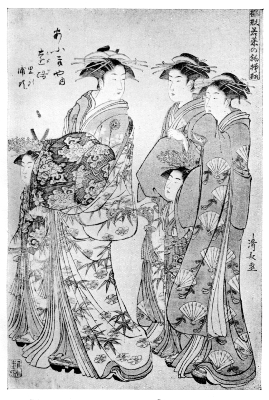
Plate 25.
The Yoshiwara or licensed quarter of Yedo was established in 1614 as part of the general Tokugawa regime of orderliness and control: even by that date{213} the authorities had tired of the cruel and ugly chaos that prevails in these matters to-day in our cities. The name of the quarter was derived from the fact that it was located in the midst of an ancient "yoshiwara" or rush-moor. In 1657, after a fire that demolished all the buildings, the quarter was moved to a site half a mile north of the great Asakusa temple in the north-east outskirts of the city, where it remains to this day. Within this moated and walled enclosure about a quarter of a mile square, to which access was obtained through one great gate, stood orderly rows of large houses crowded close together. The front of each house was latticed; behind the bars appeared the splendidly clad inmates. These were of many grades and ranks; it is, as a rule, the highest class only that are represented in the prints.
The high-class Oiran was a notable personage. Her state was like that of a princess. Attendant upon her were customarily two small girls, called Kamuro, who acted as lady's-maids; and one or two older girls, called Shinzo, whose duties were those of a kind of maid-of-honour. Her attire, of a gorgeousness wholly different from the costume of the ordinary woman, bedecks her in many of the prints with truly royal splendour. Poets sang of her; artists painted her; the common people talked of her with the same frank and admiring interest that our populace bestows upon theatrical favourites. Moralless though her life was, it was not in any external sense degraded; she stood in the position in which have stood all the great courtesans of history.{214}
The names of the more famous among the Oiran have come down to us wrapped in glowing tradition. Hana-ōgi of the House of Ōgi-ya, the most beautiful and deeply loved courtesan of her time, moves immortal through the designs of Kiyonaga, Shuncho, Yeishi, Utamaro, and their contemporaries. She was a pupil of the poet Tōkō Genrin, and ranked as a distinguished artist in both Chinese and Japanese verse. At one time, obeying the dictates of a profound attachment, she dared all perils and fled from the Yoshiwara with her lover. These facts, together with the filial piety for which she was renowned, doubtless augmented her romantic fame. Of her beauty and lordly carriage the prints leave us no doubt. Again and again we find lavished upon her well-beloved figure all the resources of the greatest artists. In Plate 25 she is the leading figure, with her attendants grouped around her; in Plate 32 she stands beside a latticed window opening on to the Sumida River, alone and meditative.
It is necessary for any one who would understand the art of the period to put aside preconceived notions and realize that these courtesan-portraits are not representations of low gutter creatures, but that they portray women of the highest degree of intellectual refinement who were in real life much like the cultivated hetairæ of ancient Athens, the companions, friends, and beloveds of Pericles and Plato.{215}
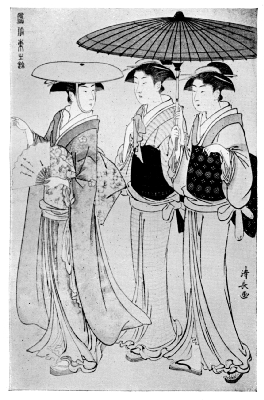
Plate 26.
And as one examines the few records which Japanese writers have given to the Western world, the conviction grows ever stronger that at this time, when the free and romantic love of men and women{217} was a thing alien to the businesslike Japanese marriage system, the one region where love as we understand it might flourish—the one region where might arise those desperate attachments of heart for heart which we regard as heroic—was the isolated enclosure of the Yoshiwara. There no shrewd parents arranged the unwilling, blind match; there the hampered spirits of that day found freedom, however perilous; and there alone men and women, though surrounded by an atmosphere of sordid corruption, faced death as did the Tristram and Iseult of our legends, in the service of a passion more precious than life itself.... For the Oiran could turn lover.
Festival Scene.
The reader will perhaps have noted how many artists of the preceding period withdrew toward the close of their careers from the field to which a new conqueror had come. This universal victor was{218} Kiyonaga. No other Ukioye artist ever so dominated his period. All earlier print-designers were gradually driven into retirement by his colossal success, and the majority of his contemporaries adopted his style. In him all previously developed resources met; after him began that long decline which led through intermediate stages of such hauntingly lovely decadence to the final death of the art. The Torii School now awoke from its quiescence, and for the second and final time assumed the dominance it had in the days of Kiyonobu.
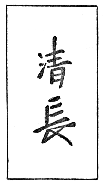
Little is known of Kiyonaga's life. Born in 1742, he worked as a young man for a bookseller in Yedo. He studied painting under Kiyomitsu, became the fourth head of the Torii School, produced the most important portion of his work between 1777 and 1790, and not long after 1790 retired from any large amount of further print-designing. His death occurred in 1815.
Though Kiyonaga was a pupil of Kiyomitsu, little of that artist's influence is visible in his work. It is true that his earliest sheets, actors in hoso-ye form, are precisely like Kiyomitsu's; but he appears to have abandoned this style very quickly, and most of his early actor-prints resemble Shunsho's more than his master's. In certain of his early works Harunobu's influence is evident; and the long-dead Moronobu's manner of line-work sometimes appears.{221} From Masanobu he perhaps inherited the grand carriage of his women. Later, Shigemasa's style influenced him, and Koriusai had a marked effect upon his development. He absorbed inspiration from all these artists, gathering to himself the best in the heritage of the past, and then struck out with a boldness that is never bizarre, an originality that is never affected, into his own natural and masterful manner.
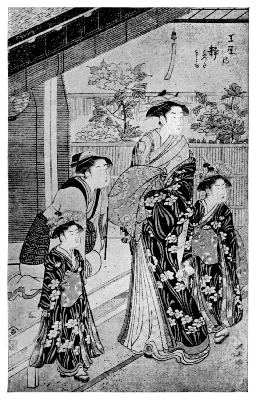
Plate 27.
By about 1777 he had developed his distinctive style. Its most obvious characteristic lies in the new quality of the figures he depicts. His types perhaps grew out of those of Koriusai; but he combined with Koriusai's richness a monumental quality to find the equal of which we must go back to the Primitives. It is his union of the pre-Harunobu dignity with the Harunobu grace and colour, in a superb and easy synthesis of his own—a truly grand style—that has made him by common consent the foremost Ukioye artist.
The type of figure which Kiyonaga created is expressive of a more stable equilibrium of spiritual forces than any seen before. It embodies a normality of attitude characteristic of the great culminating periods of art. The primitive artist expresses himself in figures whose mannerisms and constraint suggest the limitations of his technique; the decadent artist, as we shall see later, pours his visions into figures of a slender langour and relaxation that parallel his own weariness and satiety; but the artist of the prime draws large-limbed, wholesome, magnificently normal figures as the symbols of his magnificently normal mind.{222}
These figures of Kiyonaga's mature period are unforgettable creations. Tall and strong, moving with the unconscious and stately grace of superb animals, they carry the suggestion of a spiritual structure even more glorious than the structure of their bodies; and one looks upon them with a sentiment not unlike awe, as upon princesses of some land of the gods. Kiyonaga's perfect drawing, operating through a naturalistic yet highly imaginative convention, ennobles the forms he portrays as did the convention of the Greek sculptors; and he comes nearer to the Greek sentiment toward the nude than does any other Japanese artist except Toyonobu. His nudes themselves are not what I now refer to, but rather to that sense of bodily presence, that consciousness of the limbs beneath the draperies, which, as in Plate 28, one finds recurrently in his pictures. He keeps his draperies simple, denying himself the gorgeous brocades of birds and flowers which Koriusai used so richly. The garments he draws are beautiful; but he does not lose in their ornamentation the lines of the splendidly proportioned body beneath; muscles contract and limbs move under the fine folds; and our sense of the textiles is dominated by our sense of the organism within.
The movements, gestures, and attitudes of these figures are tranquil and strong; their forms are never melting or seductive, but always touched with a fine rigour. In one notable diptych, where a group of women and a seated man are gathered on the terrace of a tea-house overlooking the seashore,{225} vigour of spiritual sanity and refinement of pictorial composition touch the highest point reached in the whole course of the art. The harmonies of this particular design, "The Terrace by the Sea," embody the best and most characteristic powers of Kiyonaga.
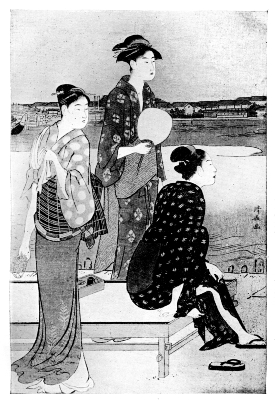
Plate 28.
We have never seen in bodily presence such people as Kiyonaga's. Yet, as Turner is reported to have said of his sunset, "don't you wish you had?" These figures are serene, supernatural, Olympian; fictional, just as Harunobu's are but differing from his in that they interpret possible development and portray the human ideal, and do not lie apart from reality in a region of private vision.
Kiyonaga saw, as the greatest artists of mature epochs have always seen, that the fictions of personal fancy are not so interesting or so beautiful as imaginative renderings of reality. In so far as he respected reality he was a realist. Yet he was never the dupe of that realism which attempts to report photographically. In his renderings fact took a harmonious place alongside of those idealizations which were personal to him. Kiyonaga saw Nature with clear eyes, and on the solid foundation of observed fact he reared the noble structure of his vision of life—a vision in which the world is peopled by a race such as the human race ought to be.
This was Kiyonaga's primary contribution to Ukioye art. Consequent upon it he introduced certain important innovations.
We have seen how Harunobu, dreaming in colour and pushing to the farthest limits the refinements of{226} technique in colour-printing, produced miniature jewelled improvisations that have never been equalled. Harunobu customarily elaborated every portion of his sheet with these inlayings of beautiful tones, enriching his figures with gauffrage and tinting his backgrounds of sky and water. He resembled a worker in enamels who must cover every inch of his surface with luminous hues.
But just as Harunobu toward the end of his life felt these effects to be only partially adequate, and turned to the larger world of pillar-prints—so from the beginning Kiyonaga found this jewelled delicacy to be incompatible with the scope that was the need of his specific genius. He discarded all those lovely tricks of the engraver and the printer which had been almost an end in themselves to Harunobu. He abstained from giving to his backgrounds Harunobu's exquisite neutral tones, feeling that they could only suffer by the addition of tint. He was no colour-dreamer, but a great harmonist of lines and spaces; and the lofty skies and wide horizons that create distance behind his figures attest his wisdom.
Similarly he was unable to content himself with the flawless grace of line that Harunobu and Buncho had mastered. Either from the powerful and massive brush-strokes of Moronobu or from the even more expressive brushwork of Shigemasa, he derived a style that is one of his chief glories. No use of line was ever more virile than his. The brush seems to vibrate in his hand; the strokes are instinct with life along every fraction of their length; the line narrows, widens, swirls, breaks, and flows in perfect response{229} to the will of the mind behind it. So individual is Kiyonaga's touch that it would be possible for an expert to attribute to him a print of which only one square inch survived.
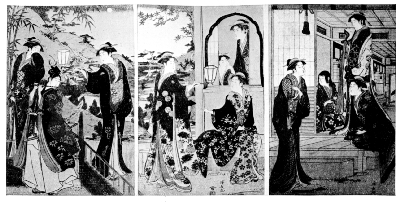
Plate 29.
It is characteristic of Kiyonaga's style that he did not confine himself to the small square sheets used by Harunobu and the small oblong hoso-ye used by Shunsho. His most important work is in the form of the large full-size sheets which he adopted from Koriusai. In these he rose to a height unparalleled in Ukioye; and M. Koechlin is quite right in esteeming Kiyonaga's sense of elaborate composition, here so impressively displayed, as his chief grandeur.
In the series of large sheets without backgrounds, "Designs of Spring Greenery," one of which is reproduced in Plate 25—Kiyonaga produced work not very different from that of his collaborator Koriusai. Only in certain sheets is there a harmonious grasp of the full possibilities of pictorial composition. But proceeding to other series, the gap widens. In the series "Present Day Beauties of the Yoshiwara," he advanced to his own unique field. Possibly he touched the supreme height in the great group "Brocades of the Customs of the East," which includes such well-known prints as the two saltwater carriers on the seashore, the three singers at the bath, the two ladies conversing with a flower-vendor, and the print reproduced in Plate 26.
From these prints Kiyonaga proceeded to still further combinations, devising compositions in which two, three, or even five sheets unite into one wide design. For the triptych we have Kiyonaga to thank.{230} The triptych was not, it is true, literally Kiyonaga's invention; many artists in the First and Second Periods had produced hoso-ye sheets in sets of three that could be joined together to form one picture. In fact, each set of three was originally one sheet printed from one set of blocks; and it was convenience and economy rather than the idea of producing any real three-piece composition that led to the production of these sets. The prints were almost always conceived as separate pictures; they seldom gain by juxtaposition, and frequently suffer by it.
Far other was the impulse that led Kiyonaga to his diptych and triptych compositions. The great triptych of the "Disembarkment," the diptych of the "Night Expedition," the "Serenade" triptych reproduced in Plate 29, and the whole series of diptychs called "Twelve Months of the South," to which belongs the marvellous "Terrace by the Sea," are all dominated by an indigenous rhythm of line and colour. These designs have not Shunsho's startling force, nor Harunobu's minutely detailed grace, nor Koriusai's richness; all these elements Kiyonaga sacrifices for a broader sweep and a more unified pictorial quality. His designs co-ordinate the elements of line, colour, figures, and landscape into total impressions of such large harmony as we have not seen before and shall hardly see again. To over-estimate the genius that produced the grouping of his best work is impossible; to realize it fully requires careful analysis, so unobtrusive and inevitable are its effects.
Plate 30.
Kiyonaga's greatest works are these triptychs and{233} diptychs in which he depicts the holiday life of his Olympian figures. Even single sheets from them are treasures; for though they combine into still greater compositions, each one, as we may see in Plate 27, or in any one of the sheets of Plate 29, is a perfect unit that can stand alone. His pillar-prints, of which two appear in Plate 30, are ranked among the foremost works in this form.
Eventually Kiyonaga's finest manner passed. Though the vigour of his brush-strokes remained, his figures began to take on an exaggerated length and slimness characteristic of the coming decadence. Therefore his retirement from print-designing, a little after 1790, was not, as in the case of Harunobu's untimely death, an irreparable loss. His greatest work was finished. Why he retired is not known; the various speculations on the subject are not very enlightening.
Though the finest Kiyonaga prints rarely come into the market nowadays, the less important examples of his work are by no means impossible to obtain. His smaller prints, and his pillar-prints in particular, are among the most attractive acquisitions remaining for the collector. The large single sheets, if fine impressions and in fine condition, are among the foremost of the collector's treasures. The great triptychs are almost unprocurable, except in poor condition.
The collector must patiently await his opportunity. There is probably not a single Kiyonaga obtainable anywhere to-day that is of the quality of that unique group of marvellously printed masterpieces which{234} once belonged to Fenollosa, and which is now one of the glories of the Spaulding Collection in Boston. Similarly, the Mansfield Collection in New York and the Buckingham Collection in Chicago contain Kiyonagas which are the result of long years of search and which could not be duplicated in all the markets of the world combined.
Torii Kiyomasa was the son of Kiyonaga. His work, produced between 1810 and 1825, is without special distinction.
Among the minor pupils may be named Kiyotsugi, Kiyohisa, Kiyokatsu, Kiyotei, Kiyotoki, Kiyoyuki, Kiyohide II, Kiyotsune II.
Every artist of the day was influenced by Kiyonaga; among those difficult to classify otherwise may be named the following men:—
Sanchō, who worked in the neighbourhood of 1780, produced prints somewhat in the manner of Shuncho. Delicacy rather than strength distinguished him in the few examples of his work I have seen.
Harumitsu is an artist whose work is known to me only by one pillar-print in my collection. Fenollosa, who once owned the print, noted on the margin of it: "A rare man. Name may be also read Shunkō, but not the same as the pupil of Shunsho. A follower of Kiyonaga." And this is all the information I have been able to obtain about him. It is possible that he is the same as Shunko II.{235}
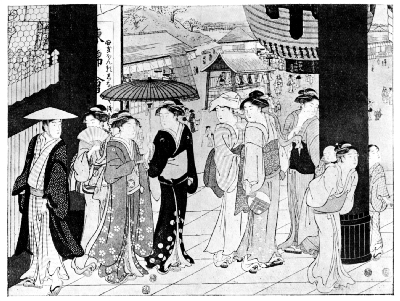
Plate 31.
Nothing is known of the life or personality of Katsukawa Shuncho. His name and certain{238} peculiarities of his drawing indicate unmistakably that he began his career as a pupil of Shunsho; but he soon fell under the influence of Kiyonaga and became that artist's most notable follower. His main work lies between the years 1775 and 1800; it is thought that he stopped designing prints before the latter year, though he is said to have lived until after 1821. His designs, one of which appears in Plate 31, comprise chiefly figures of women, drawn with extraordinary grace of line and softness of colouring.
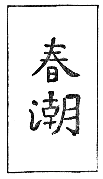
Except in a few early actor-prints, Shuncho had only one manner—that which we have come to call the middle Kiyonaga style. It was early in his career that he threw off the harsh dominance of Shunsho. M. Raymond Koechlin points out that had he remained under that influence he would without doubt have been lost in the banal horde of designers of actor-prints who spiritlessly followed that great artist. For there was nothing in common between the rugged masterful genius of Shunsho and the luminous grace of his pupil. Kiyonaga's style, however, Shuncho could adopt and utilize to express his own peculiar and mild sense of beauty, with a perfection that makes him stand out unique among Kiyonaga's disciples. Other pupils of Kiyonaga followed the master for a longer or shorter while; but all the others sooner or later developed styles{241} of their own or copied the styles of other leaders—often eccentric and decadent leaders, far inferior to him whom they had abandoned. But Shuncho, having adopted the Kiyonaga manner at its noblest, when the proportions in the drawing of the figure were most natural and dignified, never departed from it except to make it slightly less naturalistic, in accordance with what he had learned from his first master Shunsho. That this was so manifests Shuncho's purity of feeling, and also reveals his strange lack of desire to experiment in new manners. No artist so great as Shuncho has ever been so little endowed with initiative and invention. I fancy that he marks the point in the development of the Ukioye School where, after the progressive force of Kiyonaga had spent itself, the art stands still for a brief moment of perfect balance before it begins to take its course down the long slope of the decline.
Plate 32.
In many respects like Kiyonaga, Shuncho can hardly be regarded as second even to his master, except in originality. He lacked Kiyonaga's great creative imagination—an imagination which brought into being the Olympian style. But his gifts enabled him to assimilate this style perfectly and turn it to his own slightly different uses. His sense of composition is rather undistinguished when compared with Kiyonaga's; but the delicacy of his drawing, the restrained harmonies of his colour, and the clean vitality of his line have a beauty that we could ill afford to sacrifice even for Kiyonaga's strength. Kiyonaga brings down the gods in all their noble dignity to walk the earth in calm magnificence; but{242} Shuncho leads us into a secret heaven where the loveliest and most flower-like of the gods have remained behind. His is a softer beauty, touched with remote half-lights, vibrant with faint wistfulness; his superb women turn in mid-joy as though far and grave music had suddenly drifted to their hearing; their perfection passes over into the region where beauty becomes sadness. No women in the whole range of Japanese art so haunt one's memory as do his; no beauty seems at the same time so flawless and so charged with the burden of transitoriness. One cannot but feel that where Kiyonaga's healthy vision saw only the happiness and brilliance and splendour of the forms that swept by him in the mortal procession, Shuncho saw also the ghostly fleetness of their passing and the melancholy of their radiance sunset-bound; and around his figures this sense throws a quiet tender light, a suggestion of brooding and caressing sweetness.
Plate 33.
In his finest prints the softly luminous colour and the gently sweeping lines of his ladies move sometimes through the palely glowing rooms of palaces, but more often through sunlit fields and gardens and blossoming groves—regions of delight and cloudless skies, scenes of eternal happiness. His colour-schemes in these natural settings are artfully contrived to produce, through the limited agency of flat tints, an impression of crystal-clear atmosphere around and behind the figures. In both his triptychs and his pillar-prints there often stretches away this delicate world of hills or seashore or river-bank that plays no small part in the incantation of beauty.{245} His pillar-prints, of which three are reproduced in Plates 32 and 33, are especially fine; I sometimes think that here he surpasses Kiyonaga.
And yet there is about all his work a strange impersonality, an absence of any note that brings to our notice Shuncho himself, the observer and recorder. He is detached even from his own most perfect work. Compare him with Harunobu or Sharaku or Utamaro, and observe how invisible he is—how his designs have a transparency that absolutely conceals him.
In historical importance and in originality Shuncho is secondary to Kiyonaga; in absolute beauty his work deserves a place beside that of the master. As a colourist—his most distinguished rôle—he was perhaps the greater of the two.
The collector may be interested to note that practically all Shuncho's work is printed with the utmost sharpness and refinement; poor impressions of his prints are almost unknown. In this particular he is in striking contrast to many of his contemporaries; and one may perhaps trace his care to the training of Shunsho, of whose work also I have seldom seen a really poor impression. Shuncho's work is unfortunately not common; finely preserved copies are scarcer than Kiyonaga's.
Katsukawa Shunzan was a little-known artist who worked from about 1775 to about 1810. He was first, as his name would suggest, a pupil of Shunsho; in his rare early prints in hoso-ye form he produced{246} actors in the manner of that school with considerable charm of line, but without great vigour. Even in these early pieces Shunzan's leaning towards sweetness and suavity suggests that he was not at home in the Shunsho manner; and it is not strange to find that he later turned to Kiyonaga, under whose powerful influence he produced his best-known work—beautiful ladies in robes of splendour. He generally copied the Kiyonaga type of figure closely, but a little stiffly; and he was not often master of those harmonies of arrangement and grouping which distinguished his teacher. But occasionally his colour is very rich and glowing.
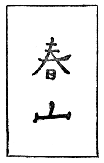
Either he produced little or else time has been even less than normally kind to his work, for few prints by him survive.
Kubo Shunman was one of those singular artists who fascinate us almost as much by mystery as by beauty. Living from 1757 to 1820, or, as some authorities say, to 1829, he was at one time a pupil of Shigemasa; but he later turned to Kiyonaga as his final and most important teacher. From Kiyonaga he learned the rudiments of his style; yet on the whole his work resembles Kiyonaga very little. An individual touch dominates all his compositions. He may be called the symphonist{247} of greys; for a large part of his most notable production is done in modulated shades of this colour, heightened and made luminous here and there by carefully calculated touches of green, yellow, red, or violet. His figures are drawn in a manner less solid than Kiyonaga's; as in Plate 45, the lines seem tormented and strained into arabesques of peculiar and restless beauty. The harmony of his colour is kept by this sharp intensity of line-work from sinking into mere sweetness and flatness.
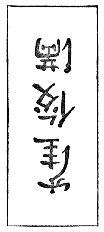
These figures of Shunman, sketched with the curious uneasiness of line of which I speak, stand before backgrounds of equal strangeness. The landscapes seem instinct with an obscure life; the Talking Oak of Dodona was never more haunted than are they. His great six-sheet composition, "The Six Tamagawa," is positively disturbing in the feeling of supernatural forces that it awakens. As Fenollosa says: "Everything he does has a strange touch. The Kiyonaga face becomes distorted with a sort of divine frenzy; trees grope about with their branch-tips like sentient beings; flowers seem to exhale unknown perfumes, and the waters of his streams writhe and glide with a sort of reptilian fascination." Or, as Mr. Arthur Morrison puts it: "There is a touch of fantasy in most of his published designs, as well as in some{248} of his original pictures—an atmosphere as of some strange country where the trees, the rocks, the flowers, and the streams are alive with human senses and mysterious communion."
For reasons not wholly clear, the work of Shunman is received by the Japanese connoisseurs with more favour than that of most Ukioye artists. Some obscure quality of restraint and imagination relates him to the older classical schools in a way that makes him acceptable to their aristocratic exclusiveness of taste.
Shunman's best prints are so rare as to be beyond the dreams of the ordinary collector. His complete "Tamagawa" is a work for which all the great collectors in the world compete. His smaller prints and book-illustrations are, however, procurable; and his surimono are excellent and fairly numerous. His pillar-prints, of which only three or four designs are known to me, are remarkably fine.
Two Women.
Kitao Masanobu was another of the pupils of Shigemasa who marched eventually beneath the banner of Kiyonaga, though he retained to the last much of his first master's manner. Born in 1761, he lived until 1816. His occupations besides painting were various: he kept a tobacco-shop, and was best known in his own day under the literary name of Kyōden, for his highly popular novels and comic poems. He produced very few prints, but those few are of distinguished quality, all of them probably the product of his early years, before he reached the age of thirty. At least one of these, reproduced in Plate 31, is an unsurpassable triumph. His resemblance to his first master is so marked that it is not always possible at first glance to distinguish his prints from those of Shigemasa. In fact there is a certain unsigned pillar-print, representing the two lovers Komurasaki and Gompachi, which is still of doubtful authorship, some authorities attributing it to Shigemasa, while others assign it to Masanobu.
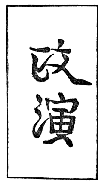
Possibly Kitao Masanobu is most widely known for his elaborate illustrated book, "Celebrated Women of the Tea Houses and their Handwritings." This volume was published about 1780; I have already referred to it in dealing with the great illustrated book of Shunsho and Shigemasa. It consists of seven large double-page illustrations in many colours,{250} and is a highly praised work, sheets of which are often mounted as separate prints. It appears to me, however, to have been overrated; and my impression is that in these designs elaborateness has smothered composition and richness has obliterated beauty.
Kitao Masanobu's single-sheet prints are lamentably few, as are also his pillar-prints; but from those that remain to us it is possible to rank Masanobu as an artist second to only the very greatest. Spirituality is a clumsy word to use in describing work so definitely embodied as this; yet none other conveys the sense of his peculiar and grave harmony. The mature beauty of his work carries us back to the perfection of Shigemasa.
The collector will search long before he finds an important print by this artist to add to his collection.
Kitao Masayoshi, who frequently signed himself Keisai or Shosin, was a curious and original designer, who lived from 1761 to 1824. Though a pupil of Shigemasa, he appears to have drawn a large part of his inspiration from a source outside the Ukioye movement—the Kano School of painting, in which the classical traditions still flourished. In his main period, contemporaneous with Kiyonaga, his work was little influenced by the great master. His designs are marked chiefly by the vividness of his observation of flowers, animals, and landscape, and by his technical skill in recording them. His books of sketches are his best-known works—drawings in a manner new to wood-engraving; he seldom{253} employs any key-block, but leaves the main body of his colour in broad impressionistic sweeps of the brush without definite boundary. He approached Nature somewhat as did Hokusai in later days, with a sharp perception and infinite interest. His work lies aside from the main current of Ukioye history—an interesting backwater that comes more properly within the region of classical painting than within that of prints.
Single-sheet prints by Masayoshi are very rare. His book-sheets are somewhat more frequently met with.{255}
VI
THE FOURTH
PERIOD:
THE DECADENCE
FROM THE
RETIREMENT OF KIYONAGA
TO THE
DEATH OF UTAMARO
(1790-1806)
From the Retirement of Kiyonaga to the Death of Utamaro (1790-1806)
The change that confronts us as we turn from the period of Kiyonaga to that of Utamaro, Yeishi, and Toyokuni is one whose significance is not at first sight wholly clear. We find the sound and classic figures of Kiyonaga gradually replaced by new and fascinating types—slender drooping bodies, wonderfully piled coiffures, elaborately brocaded robes; and the virile drawing of the earlier master gives way to the sinuous curves and arresting plasticity of the new designers. The favourite types of this time are almost as unreal as those of the Primitives, but they convey a totally different feeling; on the one hand, in their curious perverted way, they are far more realistic than the Primitives ever dreamed of being; and on the other hand, they seem the products of minds weary of reality, who turn to the phantasies of the not wholly normal spirit for their ideals and their consolations.
It must not be supposed, however, that the transition to this style of the Decadence was a sudden{258} one. The painters who had most perfectly assimilated the style of Kiyonaga were the very ones who, in this period, turned to the depiction of figures in which every line betrays the weariness of the hour and its craving for novelty. The apex of creative energy in this art had been reached and the inevitable decline was under way.
Of the forces that produced this decline we have comparatively little knowledge. Fenollosa's account of the social conditions of the period throws some light upon the problem. "It was," he says, "a period of crisis in Tokugawa affairs. The cleavage between the aristocratic and the plebeian strata of Japanese life, which had become placidly conscious of itself in the days of Genroku, now threatened a moral, a social, if not a political disruption. The new factors of popular education—art, prints, illustrated books, the theatre, novels, contact with the Dutch at Nagasaki—all had stimulated the spirit of inquiry and of unrest which had penetrated back in investigation to the facts of the Shogun's usurpation; which wrote new, popular histories of the national life; which gave plays and novels a semi-political aim. This deeper wave of self-consciousness on the part of the people was met by the authorities with sterner repressions. The better elements that might have drifted into improving the popular standards in pleasure and art were driven out by a strict censorship. There was thus a sort of natural, or unnatural, selection which tended to isolate and give prominence to the coarser side of the popular feeling. If the issue were squarely made between{259} Confucius and rank demoralization, there was little resource for the commoner but to choose the latter. Thus there arose a sort of alliance between the theatre and the houses of pleasure on the one hand, and the disaffected among the literary and political agitators upon the other. Men, great men who sowed the seeds of the revolution which ripened in 1868, had to flee for asylum, not to Buddhist temples, but to the labyrinths of the Yoshiwara, where, in the care of a romantic love lavished upon them by its then highly cultivated hetairæ, they could print and disperse, from their hidden presses, seditious tracts which set the heart of the nation on fire. It was not the ideals of a ripe self-consciousness, such as Kiyonaga had attempted; it was a struggle of living desires against outworn conventions and hopeless tyrannies. Hence, the two phases of a new Ukioye art—its pressure outward toward fuller scientific realisms, and its frank recreations in the vulgarities of its surroundings."
In addition to the restlessness growing out of such political conditions, we should remember that it is not the nature of the human race to be satisfied even with perfection for very long. Kiyonaga, with all his placid beauty, could not forever suffice men who felt themselves to be living as passionately "modern" lives as we do to-day. Change was required to keep them interested; and since the idealization of sound vitality could hardly be pushed farther than Kiyonaga had taken it, the obvious path for the artist lay in the direction of fantastic variations on the old theme and in the idealization of the erotic phantoms evoked by{260} uneasy weariness. New refinements had to be introduced; new emotions had to be stirred; and the unending search for novelty led in due time to strained efforts, perverted mannerisms, and distorted outlooks upon life.
So much for that part of the decadence which was due merely to the desire for change. But there was another element of even more definite operation. It is fairly clear that part of the fatal development resulted from that slow drift toward realism which we have seen growing, period by period, since the days of the Primitives. The age of Harunobu, with its new technical resources, had abandoned pure decoration and aspired to put into its designs something of the flavour of life. The age of Kiyonaga, with its complete mastery of technique, had projected into its designs its observation of real beings—drawn with a fine idealization, but nevertheless based on a deep fidelity to concrete forms. The age of Utamaro had a choice of only two steps left to take if it were to advance to any new position—a step in the direction of still closer fidelity to nature, or a step in the direction of complete revolt from naturalism into regions of wild phantasy. Characteristically, it took both!
Particular instances will show this. Utamaro and Sharaku recorded the peculiarities of real things with a sharpness of observation and an accuracy of rendering that the earlier artists had never approached. And at the same time they used these sharply mastered details of nature as mere brick and mortar out of which to construct fantastic edifices of the{261} most unbridled imagination. Because they were geniuses, they did this and created masterpieces; but they left to later times and lesser artists only the sterile heritage of a deadening realism which they had found it convenient to employ, but to which they themselves had never been truly subject.
At the beginning of this period Yeishi, Choki, Sharaku, and the young Utamaro produced work that ranks quite as high in beauty as that of preceding days. Yeishi's visionary figures of women, drawn with a disembodied and fragile grace, are in their way matchless things, whose only fault is their lack of virile strength. Choki's finest works are wholly beyond praise. Sharaku, the supreme master of actor-portraits and one of the great artists of the world, created designs of stupendous power; if there is any trace of decadence in him it is not weakness but brutality. Utamaro, in his earlier years at least, was as wholesome as Kiyonaga; and even when, in later times, he turned to figures that have about them an indescribable atmosphere of languor and decline, he made of them designs that are to many people the most beautiful productions of the whole school. In all of these men, technical power and sense of composition were of unimpaired vigour. Why, then it may be asked, should we speak of the decadence?
The answer lies partly in the fact that these productions, as a rule, express in their languid or overstrained figures tendencies of emotional super-refinement and nervous tension that impress every beholder with a sense of disintegration, and partly in the history of later days. For the moment, the{262} rivalry between the great men of the period was so keen as to sustain what was, after all, the dying effort of their art. The successes of each one spurred the others on to new types and new feverish devices, feeding thus the flames of the desire for novelty among the people. But the end was at hand. By 1800, in the later work of Utamaro, in most of the work of Toyokuni, and in practically all the work of their followers, genuine artistic weakness appeared, sensationalism took the place of vigour, garishness supplanted harmony, and crude emotions, crude drawing, crude colour became the common feature. The ancient sense of style gave way to a desire to push pictorial effects beyond their legitimate boundary, and the edge of the abyss was in sight.
But before that moment came there remained sixteen years in the productions of which we shall find beauties less sane and sound than those of Kiyonaga, but nevertheless perpetually delighting.
Portrait of a Woman.
The career of Hosoda Yeishi as a print-designer began about 1780 at the time when Kiyonaga was in full sway, and lasted until shortly after the beginning of the nineteenth century—a date when Kiyonaga had for some years been in retirement. Thus in Yeishi perhaps more fully than in any other artist except Utamaro may be observed the crucial transition from the period of Kiyonaga to the period of complete decline.
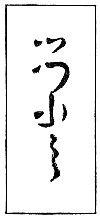
Yeishi was originally a noble of high rank who studied under Kano Yeisen, the court painter; and not even in the last years of his career, when vulgarizing influences were dominant, did he lose the refinement and aristocratic delicacy that are his most striking characteristics. Shortly before he became a Ukioye painter he had been attached to the household of the Shogun Iyeharu. It is not difficult to imagine the horror of Yeishi's early circle of associates when he threw over conventionality and station, and plunged into{266} the vie de Bohème of a popular painter. "This youth," remarks Fenollosa, "doubtless shocked all his friends in tiring of the solemn old Chinese poets who had been gliding about in impossible landscapes since Tanyu first labelled them, and of the semi-serious, long-headed old gods who gave knowing winks to their turtles and storks, and in running off to such abominable haunts of the cow-headed Buddhist Satan as Danjuro's theatre-pit, fragrant with the odours of saki and raw fish, or the lantern-hung balconies of merry damsels on the river-boats."
But the elegant court gentleman was not destined to sink in the maelstrom. To this underworld he brought his own subtlety of vision and evoked from it figures of unfading beauty. At the outset Kiyonaga was his guide—a guide perhaps too blindly followed. Certainly Yeishi's first productions, superb as they were, cannot be called his most characteristic. Plate 35 is an example. They are wholly in the Kiyonaga manner except that they have a touch of fragility and delicacy that is alien to Kiyonaga. The proportions of the figures are the same, but Yeishi's curves are less naturalistic; they seem the product of one whose hungry visions lapped like waves against the shore of reality, shaping it into contours determined by their own demands. The "feeling of repose" which Mr. Strange notes is not repose at all but weariness. At first the perfect poise of these forms may deceive us; but as we advance along the calendar of Yeishi's work we find it pervaded by a spirit less serene, more high-strung, more drugged with beauty than was Kiyonaga's.{267}
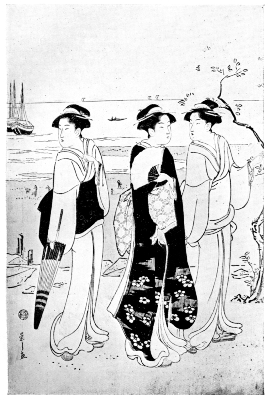
Plate 35.
In what we may call Yeishi's second style, he gives the peculiarities of his nature full expression. The tall slender figures cease to recall Kiyonaga's; the robust vigour goes out of them; they become impalpable, wistful creatures, hovering before us with slow grace, moving by us in grave procession. These beautiful women are like creatures seen in a dream; they have the solemnity and aloofness of priestesses intent on the performance of secret rites. Their long robes sweep in stately pageant; their delicate heads bend in exquisite weariness.
Fenollosa strangely speaks of the "keenness of Yeishi's characterizations," and says that, "with no idealizations to trouble him, he put down what he saw as frankly as a young reporter." This is a surprising misinterpretation. Yeishi was perhaps more notably a visionary than any other Ukioye artist; he was haunted by supersensible intimations, perverted by a search for unearthly beauty. A fascinating painter! He has not the brilliancy and versatility of Utamaro; but the taste is hard to please which finds monotony in his series of perfections. In his second period—his most individual and powerful—he produced compositions that are hardly inferior to Kiyonaga's. Yeishi may be regarded as one of the few designers who perfectly mastered the triptych form. His arrangements are simpler than Kiyonaga's but no less beautiful. A notable series depicting various polite occupations from the life of Prince Genji are so harmonious in design, so lovely in colour, and so instinct with spiritual refinement as to rank among his finest works.{270} In some of these triptychs Yeishi introduces his interesting colour-invention—a scheme of grey, yellow, violet, blue, and black, which he handles superbly. Among his other triptychs, "The Treasure Ship" is especially notable. In this print, a barge whose prow is shaped like the head and breast of the mythical Hoho bird seems adrift on a river of peace; its wonderful freight—nine noble ladies engaged in the refined entertainments of paintings, games, and poetry—express the nostalgia of Watteau's figures and the line-beauty of Botticelli's. The repose of heaven is upon them, and the delicate satiety of heavenly beings.
Yeishi was one of the few painters besides Shunman who successfully managed grey as a dominant tone. In certain of his prints he produced notable results in this manner, using a style in which lights of yellow and purple are arranged with beautiful effect. Sometimes, though rarely, he omitted them altogether, as in Plate 37, and contented himself with modulations of pure grey that are the last word in subtlety.
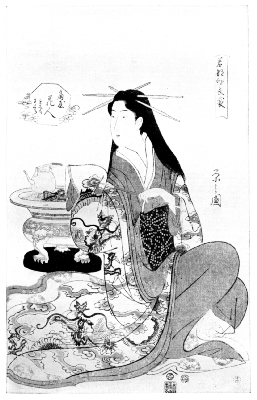
Plate 36.
He produced a considerable number of notable full-size sheets depicting single figures of women seated or kneeling, engaged in gracious occupations such as flower-arrangement. Some of these are without background; others have backgrounds of pale grey wash; while still others, perhaps the finest of all, stand out against luminous yellow grounds. One of these appears in Plate 36. In these prints is displayed Yeishi's power to draw exquisitely the long sweeping curves of draperies; and the strangely pensive, hieratic quality of his faces is at its best.{273} Their charm lies not in the brushwork, which is never as free and bold as Kiyonaga's, but in the sentiment of remote beauty of which these haunting curves are such pure symbols. He also produced a number of groups of courtesans on parade, with little or no background, after the fashion inaugurated by Koriusai and Kiyonaga. These appear stiff beside Kiyonaga's; but they have nevertheless great charm of line and colour. His album of the Thirty-six Poetesses, about 1800, is a series of fantastic and gorgeous colour-dreams. His series of standing women against chocolate or silver backgrounds rises in colour to the level of Sharaku.
Yeishi could not, however, escape the influence of the growing decadence. The public taste at the end of the eighteenth century was debased by a craving for gaudy eccentricities. Utamaro led in the rush to gratify this craving; and even the aristocratic Yeishi was unable to resist the general decline. Therefore toward the end of his career as a print-designer his work greatly altered. His figures grew very tall and willowy; their necks became so exaggeratedly thin that they seem unable to support the great pile of the coiffure; an attenuated snakyness distinguishes their lines; and the curves of their garments are distorted into the most fantastic folds and swirls. It was in this period that Yeishi produced most of his large bust-portraits on yellow or mica grounds; in these he followed the lead of Utamaro, who had influenced him considerably during his whole career. The noble and grave faces of his earlier days became wooden and distorted;{274} and when Yeishi at last stopped print-designing and returned to the life of society and painting from which he had been so long a renegade, the loss was not a great one; for the degradation of the age's taste had engulfed him—as, indeed, it did all his contemporaries.
Yeishi's ordinary work is not particularly rare. Even his slightest prints have so much charm that they may be highly recommended to the attention of the modest collector. Yeishi's important works are of great scarcity. His figures on yellow or mica ground, his grey prints, his large heads, and his pillar-prints are quite as difficult to obtain as any of the prints of this or the preceding period; his best triptychs are extraordinarily hard to procure.
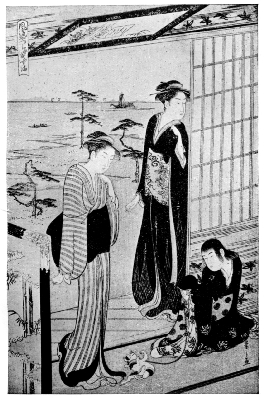
Plate 37.
Of Yeishi's many pupils, Shokosai Yeisho stands out as the most important. Nothing is known of him except that his work was done toward the end of the eighteenth century.
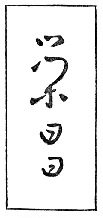
Yeisho may be regarded as the veritable shadow of Yeishi. He wholly adopted his master's style; but he was not able to impart to his figures that reserved aristocratic poise which was Yeishi's distinguishing mark. Instead, Yeisho's figures not infrequently have a certain very pleasing and{277} plausible elegance, fuller and rounder than his master's. His curves sweep more assertively and less subtly; and his decorative effects are often superb even though not particularly complex. He too passed from the manner of Kiyonaga into that of Utamaro; but his middle period is his most characteristic. In this he produced many fascinating single sheets of seated or kneeling women, several admirable pillar-prints, as in Plate 33, some large bust-portraits that are perhaps his finest works, and a number of triptychs. These last, as a rule, lack the element that is the real glory of the triptych—a broadly grasped correlation of complex elements into one great harmonious composition. Yeisho's triptychs are merely three sheets placed side by side with only a rudimentary attempt at unification. But so completely attractive are the separate figures and the great sweeping curves of his best work that these triptychs are nevertheless delightful productions—more striking than many a subtler composition. They have, however, a stereotyped quality that makes one unwilling to take Yeisho very seriously as an artist. His curves sweep splendidly, but they are dominated by a formula.
Yeisho's works are not common; they are far rarer than Yeishi's. Yeisho may serve to illustrate the difficulty of appraising these artists. I had hardly written the foregoing estimate of Yeisho when I received as a gift from a friend a large bust-portrait of a woman by Yeisho which is so unexpectedly magnificent and so much finer than{278} any work of Yeisho's I had ever seen that my previous opinion had to be modified. In subtlety of line and delicacy of colour this head is at least equal to Utamaro's finest works in the same manner; it utterly contradicts my previous impression of Yeisho's stereotyped quality. Now, what has happened to me in the case of Yeisho is happening to students of Japanese prints every day; and not until the last secreted treasure is brought to light and made known can we be confident that we are even approximately right in the ranks which we assign to the various designers.
Yeishi's vigour, barely sufficient to create his own exquisite works, could not transmit itself to any very vital body of pupils. Though his disciples were many, no one of them achieved independent renown; the seeds of life were not in the teacher. Out of a large number, the following pupils may be named as the most important:—
Ichirakutei Yeisui, of whom nothing is known, inherited from his master an elegance of line that is often pleasing. He cannot, however, be regarded as an important or original artist. His large bust-portraits, with charming piquant faces, are his best-known works. His prints are rare but not especially sought after.
Gokyo, an interesting artist who probably died young, worked in the same manner as Yeishi. His prints, soft and pleasing in colour, are very rare indeed; the few known examples of his work have{279} a distinction worthy of more attention than they have hitherto received. Had he lived he might have given the school of Yeishi a fresh fame.
Yeiri, of whom not much is known, sometimes signed himself "Yeishi's pupil Yeiri." He is to be distinguished from the almost contemporaneous Rekisenti Yeiri. The latter worked more in the style of Utamaro; his work is rare, and his finest prints are beautiful and valuable. It was Yeishi's pupil Yeiri who created that rare and astonishing portrait of Kitao Masanobu which must take a place beside the most brilliant portraiture of any time or land.
Yeishin is known only by half a dozen prints; these, though attractive, are not as greatly prized as their scarcity might lead one to expect.
Chotensai Yeiju is a slightly stiff and not very interesting disciple whose work is rare.
Yeicho also is notable chiefly for his rarity.
Yeiru followed his master with little originality.
Yeiki and Sōraku are later unimportant pupils who followed Utamaro also.
Portrait of a Woman.
Utamaro, the central and in some ways the most fascinating figure of this period, has been from the first a great favourite in the esteem of European collectors. His graceful, sinuous women are the images that come most readily to the minds of many people at the mention of Japanese prints. In his own time and land his popularity was equalled by that of no other artist.
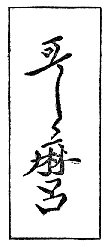
It was by his portraits of women that Utamaro won his great fame. Passing outside the influence of Kiyonaga, he developed in his designs of the last decade of the nineteenth century his characteristic feminine type. Her strange and languid beauty, the drooping lines of her robes, her unnatural slenderness and willowiness, are the emanations of Utamaro's feverish mind; as her creator he ranks as the most brilliant, the most sophisticated, and the most poetical designer of his time. His life was spent in alternation between his workshop and the haunts of the Yoshiwara, whose beautiful inhabitants he immortalized in prints that are the ultimate expression of the mortal body's longing for a more than mortal perfection of happiness. Wearied of every common pleasure, he created these visions in whose disembodied, morbid loveliness his overwrought desires found consolation.{283}
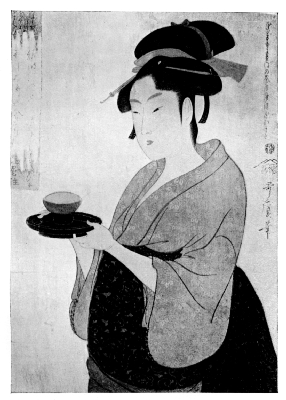
Plate 38.
Utamaro was born in 1753 in the province of Musachi. Early in life he went to Yedo and there studied under the noted Kano painter and book-illustrator Toriyama Sekiyen, whom some authorities say was his father. Almost from the beginning of his career he lived with the famous publisher Tsutaya, who issued his prints; and this relation continued up to the date of Tsutaya's death in 1797.
In Utamaro's early work, which began with an illustrated book in 1776, the influence of Kiyonaga was strong. Shunsho's and Kitao Masanobu's characteristics are sometimes also visible, but Kiyonaga's style is the dominating one. Some of his early work is signed Toyoaki.
In 1780 the first important product of Utamaro's career saw the light—his famous "Gifts of the Ebb-Tide"—a book of exquisitely conceived and delicately printed representations of shells and rocks on the seashore. The effort of a trained conchologist to produce accurate descriptive drawings of these objects could hardly achieve a more scrupulous fidelity than do these pages, which have in addition an æsthetic charm of a high order. The same characteristic appears in his celebrated "Insect Book" of 1788. These two works, dominated by a scientific realism that was new to Ukioye, may serve as an indication of the growth of that naturalistic spirit whose effect upon the stylistic ideals of the art was later to be so destructive.
In the decade between 1780 and 1790 Utamaro produced many additional books. Notable among them are the "Customs of New Year's Day" (1786),{286} "The Mad Full Moon," a series of lovely moonlight landscapes in monochrome (1789), and "The Silver World," a series of delicate snow scenes (1790). The single-sheet prints which he issued during this decade are exceedingly beautiful works of a type that the inexperienced eye would never recognize as Utamaro's. The figures are like those of Kiyonaga's prime, but drawn with a slenderness of line and restlessness of poise that strikes a different and shriller note. His work of this period may be distinguished by the fact that the signature is written in a squarer, more compact, and more formal manner than the sprawling, cursive signature of his later days. The two long, tail-like lines of the later signature, by which even the casual tourist learns to recognize Utamaro's name, are wholly absent.
With 1790 begins the classic period of Utamaro's work. This was the year of Kiyonaga's retirement and, according to some authorities, of Shunsho's death. With the two giants of the older generation gone, Utamaro was left to compete for leadership with Yeishi, Shuncho, Choki, Toyokuni, and the lesser men. During the decade from 1790 to 1800 Utamaro was, except for the isolated figure of Sharaku, outstandingly the most versatile and brilliant among them. All were profoundly influenced by him, and he had not a few imitators who attempted to profit by his popularity.
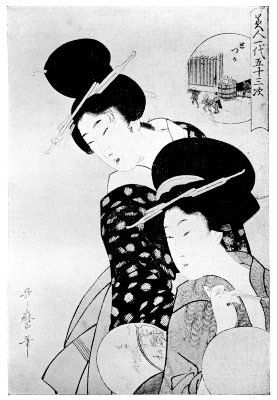
Plate 39.
During this last decade of the nineteenth century Utamaro produced the greatest of his works. Among these must be counted the remarkable series of half-length figures on silver backgrounds,{289} for which no admiration can be too extreme. One of them appears in Plate 38. The type of face which Utamaro drew in these prints differs from the Kiyonaga type; it has something of the girlishness of Harunobu or Sukenobu—wholesome, rounded, with eyes that are large and not narrowed to slits as in his later years, and with coiffure of modest proportions. It resembles the type characteristic of Choki at this time. These charming figures, drawn with subtle precision, stand against their dull silver backgrounds in colours whose few and soft tones produce an effect so harmonious as to almost justify Von Seidlitz in calling Utamaro "the first colourist of his nation." The prints of this class are as rare as they are beautiful. The collector who is familiar with nothing but the later work of the artist can have only an imperfect conception of the greatness of Utamaro. They constitute the purest and most tranquil of his productions, and perhaps the high point of his genius.
This 1790 decade, when Utamaro was at the zenith of his powers, saw many triumphs besides the silver-portraits. He was incessantly busy with experiments of every kind; pushed by the keen competition of Yeishi, Choki, and the others, he laboured incessantly for new effects and passed on to new manners. Plates 39 and 41 are examples. Discarding the type of head that had appeared in the silver-portraits, he devised that more restless, haunting type by which we best know him. The ethereal and supple bodies, the slender necks, the slightly strained poses, all indicate the nervous{290} hyper-æsthetic tension of the hour. Toward the end of the decade his peculiarities grew even more marked. The necks of his figures became incredibly slender; the bodies took on unnatural length; a snaky languor pervaded them. One print, his famous "Woman Seated on the Edge of a Veranda," reproduced in Plate 40, may serve as representative of them all. The drawing of the draperies and of the figure beneath them is studied with extraordinary fidelity; in fact, so human and real a figure is hardly to be found in the work of any preceding artist. But on the other hand, Utamaro has used his keen realistic power merely as a scaffolding, and has proceeded to build up on it a work that goes over almost into the region of symbolism. In the slender delicacy of this figure, the splendid black of her elaborate coiffure, the drooping fragility of her body, the sensuous grace and refinement, the languor and exhaustion—in all these speak the super-sensible gropings and hungers of Utamaro himself. Out of a living woman he created his disturbing symbol of the impossible desires that are no less subtle or painful because they are born of the flesh. With nerves keyed beyond the healthy pitch, he dreamed this melody whose strange minor chords alone could stir the satiated spirit. He caught and idealized the lines and colours of mortal weariness.
"Woman," says Von Seidlitz, "had always played a prominent part in the popular art of the country, but now Utamaro placed one type of the sex in the absolute centre of all attention—the type, namely, of the courtesan initiated into all the refinements of{293} mental culture as well as of bodily enchantment, and then playing in the life of Japan such a part as she must have played in Hellas during the golden age of Greek civilization. For expressing the inexpressible, the simple rendering of nature did not suffice; the figures must needs be lengthened to give the impression of supernatural beings; they must have a pliancy enabling them to express vividly the tenderest as well as the most intense emotions of the soul; lastly, they must be endowed with a wholly peculiar and therefore affected language for uttering the wholly peculiar sensations that filled them.... It is true that soon after he yielded to the general tendency of his age ... and gradually insisted on these attributes to exaggeration, even to impossibility, while his fame of having been the first to give such morbid inclinations completely satisfactory and therefore unsurpassable expression is a title of somewhat doubtful value, even if in any case a high historical significance cannot be denied it. Nevertheless, we must not forget that within this domain of the hyper-æsthetic Utamaro was the creator of a most original and individual style. Nay, if we could only admit the morbid and exaggerated to be as fit subject-matter for art as the healthy and sane, we must grant that this style is one of altogether enchanting originality, and that, however dangerous might be its immediate influence upon the spectator, and particularly upon possible successors, it does none the less lift us beyond the cramping limits of reality, and is therefore not wanting in idealism of a kind."{294}
But weary as seems the spiritual content of these end-of-the-century designs of Utamaro's, there is no lack of brilliant vigour in their composition. The great triptychs—such as the "Night Festival on the Banks of the Sumida River," or the "Firefly Catchers," or the "Persimmon Pickers"—stand among the finest prints we know. In colour, rhythm of line, and dramatic quality of composition they are triumphs. There is a startling beauty in even those extraordinary bust-portraits in which the enormous coiffure, minute neck, slips of eyes, and dot of a mouth, carry exaggeration to a bizarre and delirious extreme.
Not long after 1800 the pressure of work brought upon him by his great popularity, together with the effects of a none too well spent life in the Yoshiwara, combined to strain his powers unduly. His work no longer kept its earlier freshness; his exaggerations became coarser; his invention grew less fertile. He began to rely on the assistance of his pupils, as we know from his "Book of the Green Houses" (1804), in which several collaborated with him. Doubtless many an Utamaro print of this time is their work.
In the year 1804 came the final catastrophe. Consequent upon the publication of the well-known triptych representing the ancient Shogun Hideyoshi entertaining his five concubines in the eastern quarter of the capital, the ruling Shogun Iyenari took umbrage at the salacious disrespect to his ancestor and the delicately implied allusion to himself, and Utamaro was thrown into prison for his offence. There he remained, it is said, for a year; when he emerged, it was with impaired health and a broken spirit.{295}
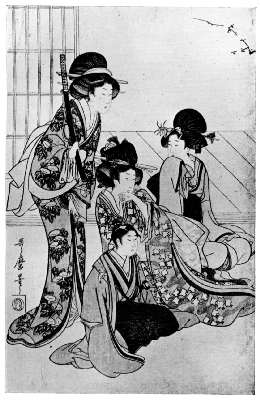
Plate 41.
His productions after this time were not comparable with his earlier work. In the year 1806 he died, and with him died the great days of the Japanese print.
In this rapid survey it has been impossible to do justice to the many-sided powers of this great designer. His beautiful landscapes, his fine animal pictures, the tender and whimsical mother-and-child and domestic scenes he produced, have all had to be ignored in favour of his central achievements—his unparalleled designs of the courtesan of the Yoshiwara in her weary glory. Certainly no more varied and distinguished talent than his illumines the roll of Ukioye artists. Beside his perpetually fresh invention even the great Kiyonaga seems stereotyped and academic.
To-day the poorer examples of Utamaro's work are still readily procurable. His greatest works are rare. Certain of his triptychs, his silver half-length portraits, and his large heads on mica backgrounds, are very uncommon. But with patience and judgment the collector may still obtain now and then a fine specimen of Utamaro's work.
But some care is necessary. Even during Utamaro's life his work was forged by unscrupulous persons who hoped to reap the benefit of his popularity; and his pupils, under his direction, produced an unknown quantity of work signed with his name. After his death, from about 1808 to 1820, the Second Utamaro worked in the manner of his predecessor, issuing work that cannot with certainty be distinguished from the late work of the master. Besides these perils there is the fact that Utamaro's prints{298} have been well reproduced in recent years; and reproductions are sometimes put forward as originals by ignorant or dishonest dealers. Considerable familiarity with authentic examples of Utamaro's best work, or expert advice, can alone protect the would-be purchaser.
Though Utamaro's influence upon his contemporaries was incalculably great, he left behind him a body of pupils who were almost without exception rather insignificant artists. With cruder colour and composition, they carried still farther the vulgarities of Utamaro's declining period. Among them may be mentioned the following men:—
Utamaro II, whose original name was Koikawa Shuncho or Harumachi, was a pupil of Sekiyen; he married Utamaro's widow, and from about 1808 to 1820 continued to produce prints in the debased Utamaro manner. Dr. Kurth believes he must be distinguished from another Koikawa Shuncho whose family name was Kurahashi, and who died in 1789. The whole matter is by no means clear.
Banki and Shikimaro were among the best of this group. Particularly the former, before Utamaro's death, produced some fine work.
Tamagawa Shucho was a rare pupil of Utamaro who worked about 1790 to 1810.
Kikumaro I (who also called himself Kitagawa Tsukimaro), Kikumaro II, Tanimoto Tsukimaro, Takemaro, Toyomaro, Yukimaro I, Yukimaro II, Yoshimaro I (also called Kitao Shigemasa III),{299} Yoshimaro II, Rekesenti Sogaku, Goshichi, Hidemaro, Mitemaro, Minemaro, Kitamaro, Michimaro, Toshimaro, Hanamaro, Isomaro, Ashimaro, Kanamaro, Kunimaro, Yoshimune, Yoshitora, Yoshitsuya, Yoshiki, Yoshimori, Yoshitoshi, Yoshikata, Yencho, Yumiaki, Hokokujin Fuyo, Chikanobu, Shintoku, Shunkiosai, Hisanobu, Soraku, Senka, Ryukoku, Sekkyo, Sekicho, Sekiho, Sekijo may all be classed as late followers, fellow-pupils, or rivals of Utamaro.
Bunro, some of whose work is fine, was a rare imitator of Utamaro. He worked chiefly about 1800 to 1810.
Dramatic Portrait.
Few people approach Sharaku's work for the first time without regarding him as a repulsive charlatan, the creator of perversely and senselessly ugly portraits whose cross-eyes, impossible mouths, and snaky gestures have not the slightest claim to be called art. At first these strange pictures may even seem mirth-provoking to the spectator—a view of them which he will remember in later years with almost incredulous wonder. To overcome one's original feeling of repulsion may take a long time; but to every serious student of Japanese prints there comes at last a day when he sees these portraits with different eyes; and suddenly the consciousness is born in him that Sharaku stands on the highest level of genius, in a greatness unique, sublime, and appalling.
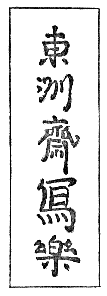
Toshiusai Sharaku is a figure more shadowy than most, even in this region of shadows. The wilful neglect of a public that hated him has folded him in a mystery deeper than the mere accidental obscurations of time. Of his birth and death we know absolutely nothing, nor of the name of his teacher, if he had one. The resemblance between his work and that of Shunyei cannot be fully explained until we know more accurately their relative dates. Kiyonaga's{303} noble drawing certainly affected his style. The influence of Shunsho upon his colour-schemes is fairly obvious; but we do not know whether this was due to personal contact, or only to familiarity with Shunsho's work. The one indisputable fact about Sharaku is that he was originally a Nō-performer in the troupe of the Daimyo of Awa. The Japanese authorities state that he worked at print-designing only one or two years, somewhere between 1790 and 1795. Dr. Kurth, in his stimulating but somewhat too imaginative volume, "Sharaku," believes that the evidence justifies us in fixing Sharaku's working period as a much longer time—1787 to 1795; but he cannot be said to have wholly proved his case. Whether or not these dates are accurate, we may at least say that Sharaku's years of activity lay chiefly within the early part of the last decade of the eighteenth century.
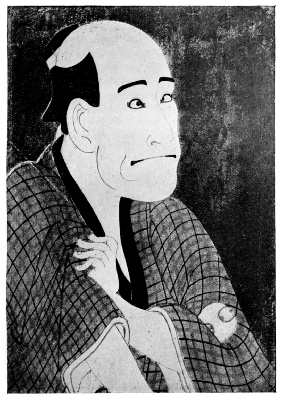
Plate 42.
Sharaku's work consisted entirely of startlingly powerful and ironic portraits of actors, some in the form of large bust-portraits, some in the form of full-length figures of hoso-ye size, and a few large sheets each containing two full-length figures. Their savage intensity is arresting and unforgettable; it at once drives one to consider what manner of man could have created them.
Sharaku was, as we have said, professionally a member of the Nō-troupe of the Daimyo of Awa. This fact is of far-reaching significance.
The Nō was a highly developed and aristocratic form of lyrical drama, based upon ancient and classical legends; it was full of a poetry and allusiveness{304} that made it incomprehensible to the populace, who, indeed, had no opportunity to see it; it was as much the exclusive concern of the cultured aristocracy as the private revival of a Greek tragedy is with us to-day. In brocaded costumes, perhaps the treasured reliques of centuries ago, the Nō-dancer appeared upon his empty stage before a hushed audience of nobles—his face masked, as were the faces of the Greek actors, his voice lifted to an unnatural pitch of vibrant chaunting; and with stately motions, elaborately devised steps, and stereotyped gestures, he intoned the rolling strophes of the drama's long and hallowed strain. A complex formalism pervaded every word and step; in no art-form with which I am familiar is an accepted convention, a totally unrealistic medium, so rigidly adhered to as in these Nō-plays.
The Nō-actors were a caste utterly apart from the actors of the common stage. They were the protégés and associates of great nobles who would not, save incognito, appear in the presence of the common actor. The gap between the two classes of actors was as great as that between Sir Johnston Forbes-Robertson and a juggler at a fair—one, the inheritor of a distinguished literary tradition, the interpreter of our classic dramatic heritage; the other, a crude beguiler of the populace, with station no higher than the pedlar. Caste-feeling may very well have been rather harsh between the haughty Nō-performers and their despised and ostracized brothers of the gutter.
As we have noted, the Nō-dancer wore a mask; these masks are creations of the greatest interest.{305} They are carved out of wood, frequently with a skill that makes them striking works of art. It is impossible to convey in words the remarkable degree of characterization which they express. The smooth guilelessness of the young girl, the deep wrinkles of the old man, the leer of the rascal, the savagery of the villain, are all in their turn summarized in these haunting representations whose simplicity of outline is matched only by their intensity of effect. Nature seems to speak in them—but a heightened nature, stripped of all incidentals; the very essence of the character of the rôle is revealed to our eyes the instant the actor, wearing his impressive and vivid mask, steps upon the stage.
Bearing these things in mind, we may follow Dr. Kurth ("Sharaku," München, 1910) in his imaginative summary of the probable effects of the calling of a Nō-dancer upon the mind and art of Sharaku:—
"Picture a richly endowed painter—at first only dimly conscious of his powers—as in a mystery-play he treads the consecrated stage in the sacred precincts of a temple of Tokushima or in the shadow of the cryptomerias and firs of the Hachisuka castle—a fantastic mask covering his features, other masked spectres before his eyes—surrounded by the atmosphere of the occult tradition of ancient and lofty dramatic art—while, in the depths of his soul's abysses, chained Titans would storm up to the outer world, and confused pictures of his future creations hover before his spirit, ... and we shall realize that this man, as a painter, must become a dramaturgist.{306}
"And if we summon to our vision the gorgeous stretches of Awa—its chasmy mountains with the forests rustling around them—its picturesque sea-lapped beaches—its sun-drenched groves of oak—its glowing scarlet maples—the brilliant flowers of its Spring—the evergreens of its Winter—then we shall realize that this man, as a painter, must become a colour-dreamer.
"Brooding spirit that he was, he, an Edipus, approached venturously to the Sphinx of passion that peers forth from the faces of men. Uncanny powers lurked in the grotesque furrows and demoniac grimaces of his Nō-masks, but nothing little or shallow—nay, in spite of all grotesqueness, only the significant and symbolic. And then he looked down from his buskined height upon the popular actors—bombastic barn-stormers—greasy low-comedians—louts from nowhere, as the illustrious Harunobu had called them—performers who brought before their gaping audience not, as did he, august things in strangely wonderful guise, but often things far too human in strutting stage-pomp. He looked upon them, a guild not only despised but sometimes even outlawed—a guild that stood on the same plane as the idiotic profession of the wrestler,—a class whose vulgar faces could not hide their swaggering gutter-vanity and their cringing lust for applause behind even the red paint of the ferocious warrior-rôle or the corpse-coloured rice-powder used when aping women. And if we see him thus, we shall understand that this man, as a painter of actors, must eventually become a pitiless satirist."{307}
It was therefore with the colossal and tragic gestures of the Nō-dance in his soul, the distorted and monumental intensity of the Nō-masks in his eyes, and the contempt and irony of the Nō-performer for the common actor in his heart, that Sharaku, coming to Yedo, took up his terrible brush to depict the Yedo actors as he saw them. The resulting series of portraits is surely one of the supreme examples of graphic characterization and devastating contempt that the world has ever seen.
In the earlier portion of Sharaku's work, among which are his large portraits on yellow backgrounds, the originality of the man is already striking enough; but his acid qualities are hardly at their fullest development. Certain of his hoso-ye prints must belong to this first period; in these, after the manner of Shunsho, he devoted his attention chiefly to the attaining of a powerful dramatic rendering of the rôle he was depicting. Strutting Daimyo, beguiling woman, ferocious warrior, shrewd peasant—he made each part move with the vigour and force of the seen stage. Shunsho was never more impressive; and here, in addition, there is in every design a strange distortion of line, a disturbing abnormality of pose, that makes one realize that no mere copyist of Shunsho is at hand.
Then, beginning with an astounding series of twenty-four portraits with mica backgrounds (Plates 42, 43, 44) representing actors in the play of the Forty-seven Ronin, Sharaku's mood changes. He ceases to remind one at all of Shunsho; it is rather the scrutinizing individual characterization of Shunyei{308} that he recalls. But Shunyei never reached the point to which Sharaku is now coming. The dramatic force, the histrionic illusion of his pictures abates no jot; but beyond it, disturbing lights and movements are lurking. The mighty rôle towers like a shadow before us in its full dramatic sweep; but from the depths of the shadow peers with stealthy glance the indwelling personality of the actor—like a jackal's eyes seen suddenly in a king's tomb. This contradiction—this complex of two utterly antagonistic forces—is one of the miracles of Sharaku's genius: it is an antinomy which he resolves sufficiently to produce an equilibrium, but not enough to take from these portraits the insoluble mystery of two spirits, the tangle of two meanings, the explosive and inscrutable life that makes them unforgettable.
Thus the sweeping rhetoric of the stately rôle and the sudden naturalistic cry of the discovered actor's soul meet in a discord unique, subtly calculated, magnificent, and harrowing. Sharaku pierced deep into the hearts of his sitters to grasp the weak, the grotesque, the pathetic, the tragic; he appraised the lust, the horror, the vacuity that was there, and these qualities he dragged out to the light through the avenues by which he had entered—through the eyes, the lips, the hands—tearing these gates into terrible and distorted breaches eloquent of the booty that had been forced through them. No portraits so blasting as his have ever been created by another; no other hand has so devastatingly shattered the conventional contours of faces to reshape them into the awful images of their own hidden potentialities.{309}
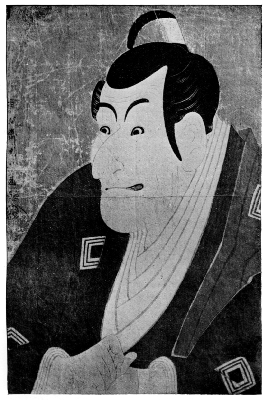
Plate 43.
To call Sharaku a realist is a silly, untruthful attempt to muffle in words forces that one does not understand. He was hardly more a realist than Kiyonaga. He saw in the spectacle before him certain elements of beauty and terror; he selected and moulded them into his cunningly devised designs; and the result was as much a creation of the visionary mind—a true idealism—as the pictures of the fairy-tale-telling Harunobu. It is no mere realism, but an insidious dissection and a mordant reconstruction, that is so striking in these works. The most savage efforts of modern caricature are child's play beside Sharaku's disintegrating analysis and his satanic reassembling of features. He does to the face and its concealed passions what Michael Angelo's anatomical figure does to the nerves and muscles—revealing appallingly the secrets of structure and the machinery of power.
Yet, in spite of all the distortions and exaggerations and displacements, Sharaku's satyrical faces live. They have an unnatural and monstrous life—like the life of Gothic gargoyles and fabulous animals, whose parts are brought together into an incredible yet organic creation. Looking upon them, one realizes that for Sharaku beauty meant not sweetness or grace, but vitality—the clench and rending of the earthquake forces of life. He sought no harmonies of sentiment like those of Harunobu; he plunged wholly into a maelstrom of powers whose magnificent surge and flow was to him the sole end and the sole consolation.
He drew no courtesans, no scenes from the daily{312} life of the people, no festivals, no tea-house gardens by the river; but with a baleful concentration he, the proud master of the esoteric Nō drama, kept his eyes fixed unswervingly upon the pathetic mimes of the vulgar stage—outcasts, common lumps strutting for an hour of glory in gorgeous robes and heroic rôles before a gaping populace. How one longs for one more work from Sharaku's hands—a portrait of himself, seated in the stalls, watching the play at its height! One can almost imagine the peering eyes, the tight lips, the hidden hands....
So far I have spoken chiefly of the large heads of Sharaku. But it must not be forgotten that he produced a number of designs in hoso-ye form that are the very flower of his work. Kurth places certain of these early in Sharaku's career; he is, perhaps, wrong in this, for many of those which he thus dates give evidence of an art so mature and masterful that they must be at least contemporaneous with the Ronin Series. Such are the print of Arashi Ryūzō as an aged noble in robe of black with violet girdle, and the print of Segawa Kikusabrō in robe of olive and purple holding an open fan. In the finest of these hoso-ye the dramatic force of the composition is so subtle that the element of caricature takes a subordinate place. A lyric mood pervades them. It is impossible to contemplate these figures without a sense, not merely of the irony and contempt which they sometimes embody, but also of the tragic heights on which they move. Lofty conflicts, desperate destinies, immense strainings toward desired goals, immense despairs before impassable barriers—these{315} are some of the emotions that confront us here. The echo of the tragedy of the Greeks is around them; their gestures seem the shadows of titanic cataclysms. Kiyonaga gave us the gods; Sharaku gives us those who fought against the gods. If it were my fortune to choose, out of the tens of thousands of prints that I have seen, one print which could alone be saved from some impending universal destruction, I am not sure whether I would take Harunobu's flawless "Flute Player," or Kiyonaga's serene "Terrace by the Sea," or that terrible print of Sharaku's, illustrated in both Kurth and the catalogue of the exhibition at the Musée des Arts Décoratifs, in which the orange-robed figure of Nakayama Tomisabrō stalks by with an intensity of passion that makes one's flesh creep—a vibrancy of line, colour, and emotion that seems the apogee of beauty and terror.
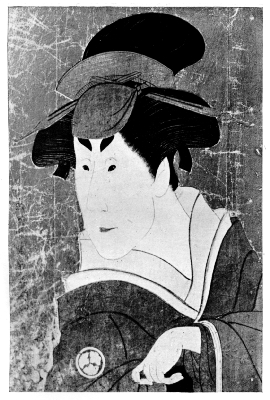
Plate 44.
The hoso-ye prints have, upon the whole, more poise and serenity than the busts; and they will perhaps be judged—in a hundred years, when the excitement of the discovery of Sharaku is over—to be among his greatest works. When they occur in triptychs, as probably all were originally designed to do, they constitute more harmonious and dramatic units than any of Shunsho's actor-triptychs. The finest, and latest in order of production, are generally those without background; in these, isolated and sublime against an empty universe of yellow tint, rise the supreme evocations of Sharaku's genius.
Great distinction of composition marks all of Sharaku's work. Both the hoso-ye and the large bust-portraits are drawn with classic simplicity of{316} lines and masses. Nothing short of certain of the Primitives can approach them. Every superfluous ornament is omitted; as in Plate 43, each line is cut down to its meagrest possible limit. But the expressiveness of the drawing is unsurpassable; and the æsthetic effect of the direct composition grows with every repeated sight. These strange heads against the dark glimmering backgrounds seem Titans rooted in the void; they loom upon one's vision enormously; they are overwhelming with the spiritual greatness of their creator. In spite of all the disturbing unquietness of their conflicts, they are charged with a monumental equilibrium of design, sealed with an exalted peace of conception, poised as for eternity with the repose of measureless space and time around them. At first sight, one would imagine these portraits to be impossibly restless things to live with; but greater familiarity proves them to be like the Sibyls of the Sistine Chapel—vast and enduring figures, whose large passion does not obliterate the fundamental tranquillity of their conception.
The colour which Sharaku employs is of a unique quality: sombre, with lurid lights; heavy and opaque; nightmare colours, leashed into miraculous and incredible harmony; things of infernal and dusky splendour; "tragic colours," Kurth calls them. The dark mica backgrounds, which Sharaku is said, without much proof, to have invented, heighten to a remarkable degree his colour effects. Words and reproductions are alike powerless to convey any sense of them; they hold in store an impressive{317} sensation for him who has not yet seen them. With them Sharaku takes first rank as a colourist.
Toward the end of his brief career, his portraits became almost too terrible in their savage and tragic irony. In the large double-portraits Sharaku tears the mask of humanity aside and shows the very beast. Yet to call even these most extreme of his productions caricatures is to obscure a subtle spiritual essence by a crude word. They are exactly as comic as the ravings of Lear, as mirth-provoking as the laments of Shylock. They are not the light mocking of a scoffer or a comedian, but the appalling and tortured sneer of a man whose vision of men is coloured by his desire for the gods.
"Because he did not represent reality, but on the contrary painted unnatural figures, the public became hostile toward him." ... "His figures were too realistic." ... "He was a bungler in art." ... From these conflicting criticisms, found in various Japanese authorities, we may gather with what comprehension the public of that day accepted the final work of the great painter; and we may conjecture what neglect and hatred forced him into a never-broken retirement.
Dr. Kurth is of the opinion that, after the year 1795, Sharaku still continued to produce secretly a few prints under the assumed name of Kabukidō Yenkyō, and attempted under this disguise to win back the popularity of his prime. This is an alluring but somewhat fantastic theory, which neither the documentary nor the internal evidence of Yenkyō's work adequately supports. Other authorities believe{318} Yenkyō to have been an independent artist who was a pupil of Sharaku. His work strangely resembles that of Kunimasa I. At the present time it cannot be said that the question is wholly settled; but it would be rash to accept Kurth's theory at its face value.
In conclusion, let us grant that Sharaku is not for every one. One cannot quarrel with a person who says, "I understand Sharaku; I see the measureless depths of his tragic irony, the unique splendour of his colour, the perfect mastery of his composition. But I do not like him. I prefer Kiyonaga, just as I prefer the stately beauty of Keats to the troubled profundity of Blake." Such a position is comprehensible and impregnable. But he who finds Sharaku merely grotesque or absurd or repellent should return to the portraits for further study; he has not yet reached the immortal heart of Sharaku's work, and he is missing a memorable experience.
Exact comparisons are profitless; but most students of Japanese prints have at certain times turned from the work of Sharaku with the deep conviction that this man was the greatest genius of them all.
Sharaku's output was not large, and his work is now of the utmost rarity. The Parisian collectors long ago recognized Sharaku's greatness, and at a time when Fenollosa was proclaiming Sharaku as an "arch-purveyor of vulgarities," and Strange was grudgingly describing him in seven lines as an artist "of great power but little grace," the collectors of{319} Paris had already acquired such Sharaku treasures as are now a lavish and deserved reward for their foresight. Perhaps the only collection of Sharaku prints that can rival those of Paris is the notable Spaulding Collection of Boston, which takes high rank.
A Silver Print.
Though Choki is probably not to be counted as one of the few supremely great artists of the Ukioye School, his fame has been steadily increasing during the last twenty years; and whereas he once held an insignificant place in the esteem of amateurs, he has of late been regarded with an interest and admiration that at times seem almost more than his deserts. Mr. Strange calls him the most graceful of all the figure-designers of his time, and Kurth does not hesitate to deal with him as "mit einem Riesengroszen." I note in Kurth a tendency to exalt an artist because of his proficiency in technical processes, to an extent that I cannot assent to; Choki was superb, but hardly Titanic. It would be difficult to characterize him more justly than{320} in the words of M. Koechlin, "Le plus curieux des petits maîtres." This description certainly does not err on the side of over-enthusiasm; perhaps these are rather lukewarm words to apply to a grace so exquisite, a precision so sharp, and a spiritual appeal so strangely alluring as that of Choki.
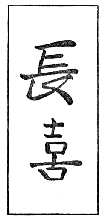
Absolutely nothing is known of Yeishōsai Choki's life; it is believed that he was a pupil of Sekiyen, who also taught Utamaro. The Japanese authorities are inexplicably silent about him. Internal evidence, however, tells us that his work lies between the years 1785 and 1805. His earliest designs are strongly after the manner of Kiyonaga, whose feminine types he at first adopted almost literally. These he modified somewhat a little later when he came under the influence of Yeishi, whose slender and delicate figures led him away from the robust ones of Kiyonaga. One of Choki's pillar-prints, illustrated in Plate 45, marks an interesting transition stage. The face and figure seem at first sight almost purely of the Kiyonaga variety, but on closer examination differences appear; and most striking of all is the fact that the colour-scheme is that peculiar combination of yellow, grey, violet, blue, and black which was distinctive of some of Yeishi's finest work. The influence of Sharaku on Choki was at some time{323} very strong, though the precise date is almost impossible to determine. So great was Choki's admiration for this master that later, when he had arrived at his own distinctive manner, he produced a pillar-print of a girl holding a fan on which appears Sharaku's famous design of "The Man with the Pipe." But Choki followed no one else as badly as he did Sharaku; though he appears to have learned things that were of great value to him later, his immediate imitations of the great ironist reduced the superb effects of the latter to the level of caricatures and dissipated the effect of concentrated force which marks his work. Utamaro proved a more congenial influence; and in Choki's earlier prints there are many traces of the grace, though not of the versatility, of that artist.
Plate 45.
About 1790 there came out of this series of imitations a curious blended type, which finally became Choki's distinctive own. This type is a composite of Kiyonaga, Yeishi, and Sharaku, but ultimately unlike any of them in its effect. The lower part of the face is prominent; the neck is elongated and wonderfully delicate; about the eyes there is a narrowing that is unusual. These figures of Choki's are distinguished by a precision in drawing so sharp as to be almost an affectation, and by a grace half of whose unique fascination is produced by some strangeness of gesture, some keenness of characterization, or some unusual angle of vision. Few examples of Choki's work in this manner survive; but they are sufficient to lift his reputation from that of a copyist to that of a notable creator of women's portraits.{324} Woman was his great theme. "Er hat ihrem Liebreiz das Hohelied der Japanischen Malerei überhaupt gesungen," says Kurth, in a burst of enthusiasm for these subtle designs. His most striking works in this manner, and perhaps the greatest of all his works, are undoubtedly his half-length figures on mica or silver backgrounds. Of the fascination of these rare prints it is impossible to gain any idea from a reproduction. They rise into the world of the miraculous; they are pure incantations. Such sheets as the famous "Fireflies," or the two women smoking by the river, or the falling-snow scene, or the sunset by the sea, have a beauty as unique as it is haunting. The colours, dull in tone, produce against the metallic sheen of the silver backgrounds unparalleled arrangements that are positively disturbing in their super-refinement.
Choki's blue and silver and red tones seem to pass over into a region where dwell things inexpressible by ordinary pigments. The most sophisticated amateur shivers before some of these colour-harmonies. Choki's characteristic prints are never restful, but always exciting and vibrant; they are dominated by some hidden instability of equilibrium that reacts on one's nerves like a drug. Their beauty has a certain madness in it, or at least a note of strain and disquietude. Thus in the end, for all his imitative efforts, Choki stands, as did Sharaku, in solitary isolation and impenetrable mystery.
Plate 46.
For reasons unknown to us, Choki late in his activity changed his signature to Shiko and produced under this name a small number of prints regarding{327} the quality of which opinions differ. They are all in the manner of Utamaro's later style, and so little resemble the work signed "Choki" that one has to use a distinct effort to restrain one's incredulity, in the face of pretty clear evidence that the two names were used by a single artist. Easily first among these prints are a few splendid pillar-prints; one of these, the two singers with the black box, illustrated in Plate 46, seems to me almost the finest pillar-print post-dating 1795 that I have ever seen. Of this form Choki was a consummate master. But M. Koechlin regards these Shiko prints as mere imitations of Utamaro's period of decadence, and rejoices in the fact that they are so rare. Mr. Arthur Morrison, on the other hand, who points out correctly that Shiko is Choki's late, not his early name (a matter on which most writers have inexplicably gone astray) feels that the Shiko sheets are, in the best instances, of more elegance and distinction than anything produced under the Choki signature. I should hardly like to agree with either view, but am content to put the Shiko pillar-prints and the Choki silver-prints side by side, and regard them as the supreme examples of the double talent of this puzzling genius.
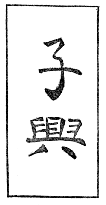
All of Choki's work is of great rarity; that signed Shiko is possibly even rarer than that{328} signed Choki. Rarest and most highly treasured of all are his silver-prints; the ordinary collector will probably never have an opportunity to obtain one.
Nagahide II and Ichirakusai Nagamatsu (Chōshō) may be mentioned as followers of Choki. The fact that we do not know of more disciples of so brilliant a designer is another one of the inexplicable things that surround him.
The Pupil of Toyokuni.
Utagawa Toyokuni was born in 1768, and early began his apprenticeship as a pupil of Toyoharu. From this master he learned the rules of European{331} perspective—a device which he soon abandoned for the true Japanese convention. He may have studied under Shunyei for a short time. Though he was later to become a fertile producer of actor-prints, he inaugurated his work with the figures of women. His first works imitate the type of face and figure made famous by Shunsho's and Shigemasa's book, "Mirror of the Beautiful Women of the Yoshiwara." Before 1790 he gave up this type for one copied from Kiyonaga, who was at this time at the height of his fame. But Toyokuni was no such draughtsman as Kiyonaga, and his figures in this manner are generally poorly drawn and awkward. At this time he frequently adopted colour-schemes from Shunman. After Kiyonaga's retirement Toyokuni began to use the delicate type made popular by the rising genius of Choki; but after a short interval he went over to Utamaro, who was then coming into supreme mastery.
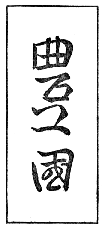
Up to 1791, therefore (according to Friedrich Succo, "Toyokuni und Seine Zeit," München, 1913), Toyokuni was exclusively a painter of women. But when in the early nineties the colossal Sharaku brought out his revolutionary actor-portraits, Toyokuni abandoned his old field and adopted, to the extent that a smaller man could, the themes and eventually the manner of this great genius. At first{332} Sharaku appears to have been an awakener rather than a guide to Toyokuni; for we find that it was to Shunsho's style that Toyokuni first looked for a model. But when Sharaku's great series of the Ronin bust-portraits appeared, Toyokuni at once responded to them as the strongest influence of his whole life and produced a number of similar portraits in a manner that captures all the eccentricities but little of the strength or insight of Sharaku. A more successful series, also definitely inspired by Sharaku's Ronin busts, was a set of full-length Ronin figures which Toyokuni then brought out. These tall monumental designs, with striking masses of black and deep colour against grey or mica backgrounds, are perhaps the finest actors in the whole long list of this artist's work. Though they never surpass Shunsho's or Sharaku's supreme creations, they are powerful conceptions, and constitute some basis for the claim of Toyokuni's admirers that he was the third-greatest of the actor-painters.
When, about 1794, Sharaku's career came to a sudden and tragic close, Toyokuni turned back from actors to women. Once more he followed Utamaro in the selection of his type, and with greater success than heretofore. To this period belongs the really splendid triptych, "The Journey of Narahira," representing a man on horseback and six attendants, admirably spaced, at the foot of Fuji. In this period also must be placed the series of pillar-prints of unusual width and shortness, very richly printed, representing courtesans and actors together. The print of this series which shows Ichikawa Kōmazō{335} pushing back a reed blind to surprise a half-clothed courtesan is a very fine work. These, and other productions of this time, justify us in calling this decade the best period of Toyokuni's activity.
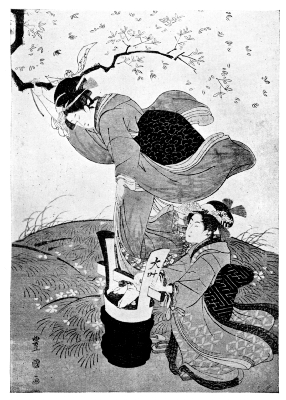
Plate 47.
But before 1800 Toyokuni had followed Utamaro in that artist's adoption of the thin necks, enormous coiffures, and distorted bodies which not even Utamaro was always able to handle beautifully. Toyokuni's success was far inferior. The over-ripeness of the type required all Utamaro's subtlety to make it attractive or significant; and Toyokuni was by no means subtle. Therefore it was no loss when he returned to actor-prints shortly thereafter. One print of this, his second actor-period—the savage portrait of Matsumoto Kōshirō, reproduced by Succo—is notable and fine. But on the whole his second period shows Toyokuni as only slightly more original than in the Sharaku period. In his portraits of women at this time he sometimes leaned a little toward the Yeishi type, with Yeishi's stiffness but without his distinction. Many books, from these as well as from other years, bear witness to his industry; he was a veritable geyser of prints of every sort.
In 1804 Toyokuni was obscurely involved in trouble with the authorities over some of his historical prints. This was the time when Utamaro also suffered at their hands. In 1806 Utamaro died; and Toyokuni, who had so long leaned on the greater painter for his stimulus and inspiration, went to pieces like a house of cards. Without a rival to emulate, he was nothing; and we see him, a tragic figure—indisputably the{336} most famous master then living, who had survived the great days when he had competed with Kiyonaga, Yeishi, and Utamaro for popular favour—now alone in a glory which he could not sustain—a master bereft of those conditions which had once enabled him to produce almost-masterpieces.
From this time on his work steadily deteriorated. The raw and over-complicated colours of his designs of women made a melancholy contrast to the "Narahira" triptych. He abandoned woman-portraiture about 1810. His actors continued—a mere outworn formula—awkward, angular creations, with senselessly crossed eyes, twisted necks, wry mouths—the veriest parody on those devices which had once been employed by Sharaku for a sublime end. Toyokuni died in 1825, a man who had outlived himself.
Toyokuni's production had been enormous. The contemporaneous popularity indicated by this is hard to understand unless we remember his frequent shiftings of style and realize that at every moment he was ready to throw off his old manner and adopt that of whatever artist most strongly appealed to the taste of the hour. He was the most imitative of all artists. What the mob wanted he gave them unreservedly, losing his own integrity thereby.
Toyokuni seems to have been without real individuality or individual view-point. He was devoid of either illusions or insight; and the true artist must have the one or the other passionately. He drew his women without enthusiasm and without tenderness. He conceived his actors without the white-heat of real artistic creation. There is something rasping{337} about the greater part of his work; it seems full of sound and fury, signifying nothing. It is rhetoric, not the profound and tragic poetry of Sharaku, nor the subtle and decadent lyric strain of Utamaro. Rarely did he make an authentic attempt to capture the beauty or wonder or terror of life as he himself saw it. It is always the vision of other men that he is reporting, not his own. He had no vision.
So long as he could attach himself to some productive master, catching that master's feeling and style to a certain extent, he produced creditable works. But when the support was withdrawn he seemed powerless to take another step along that road. Kiyonaga's retirement, Sharaku's downfall, Utamaro's death—each in turn cut short Toyokuni's prosperous career in the footsteps of these masters. When left to himself he had only one thing to revert to—the typical Toyokuni actor at its worst, a thing of common ugliness.
No fame has tarnished more than his with the passing of time. As Sharaku's has brightened, his has dimmed. Once he was esteemed the greatest living print-designer; now I find that many students feel a sense of surprise when occasionally, out of the thousands of Toyokuni's prints, one appears that is really distinguished.
It must, however, be admitted that at certain times Toyokuni's native brilliancy enabled him to create prints that are not surpassed by any of his contemporaries. He did more poor work than any other artist of his time; but such triptychs as the "Ryogoku Fireworks," in the Kiyonaga manner, the "Bath House," in which shadows appear on the wall, the{338} "Fan Shop," and the "Ladies and Cherry-blossoms in the Wind," are beyond criticism.
The best Toyokuni prints are very rare; the common ones are to be found plentifully in every print-shop. His few finest triptychs, such as the "Narahira," or the "Ladies and Cherry-blossoms in the Wind," of which one sheet appears in Plate 47, are among the collector's important treasures.
The beginner should be warned that there were, in all, at least five men who at various times bore the name Toyokuni. No one of the successors of the first Toyokuni ever produced work comparable with the finest work of Toyokuni I; but it is a matter of great difficulty, not yet by any means wholly clear, to distinguish between the late inferior work of Toyokuni I and the work of several of the succeeding Toyokunis. One simple indication may be of service to the inexperienced collector: If the Toyokuni signature is in a red oval or cartouch, it is not by the first master. This statement cannot, however, be reversed, for the later Toyokunis often signed without the cartouch.
A Group of Ladies.
Utagawa Toyohiro, sometimes also called Ichiriusai, was born in 1773; he was a brother, fellow-student, and probably pupil of Toyokuni. It is well known that about 1800 these two artists collaborated to some extent. Toyohiro's own chief work—landscapes, book-illustrations not unlike Hokusai's, and figures of women—was done between 1795 and 1820; he died in the year 1828.
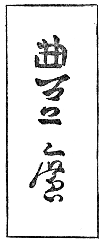
Fate has been unkind to him in associating him with a man tremendously more productive and incomparably more popular in his own day than himself. Even to the present time, the reputation of Toyokuni still overshadows that of his brother. But the close student of Toyohiro's work will probably come to the conclusion that this present difference in fame is due less to difference in merit than to the fact that Toyokuni was enormously prolific, while Toyohiro's work was scanty. The contemporaneous popularity may be ascribed to the ability of Toyokuni to shift and veer with every change in the public taste, while Toyohiro was unable or unwilling to move with these fluctuating winds. It is reported that a serious breach occurred between the brothers because of Toyohiro's refusal to produce actor-prints as the popular taste demanded. His work is, however, coming to be recognized as of a quality at least{340} equal to his brother's, and in some respects finer and more truly the expression of a rare sense of beauty.
We may conjecture that Toyohiro inherited two things from his first teacher Toyoharu. One was a leaning toward landscape drawing. The other was a certain distinction and shy aloofness that marked the older master.
All Toyohiro's work has an aristocratic touch, a fine subtlety of curve and colour, that contrast markedly with the frequently blaring compositions of Toyokuni. He seldom drew actors or courtesans; most of his figures are ladies of birth and breeding. The beautiful spots of black which are important elements in the majority of his compositions are handled with a keen sense of contrast that not even Kiyonaga's surpassed. His brushwork is firm and delicate, but not so sparkling with vitality as that of some of his predecessors. His colours are soft, his figures wonderfully graceful; the impression he produces upon one is that of a subtle and beauty-hungry spirit, detached from the mob by a refinement beyond their comprehension, driven on by a consuming passion, devoted to the quest of a perfection he was able to project but not to realize.
In style, he draws considerably upon Toyokuni's early Utamaro manner; but in spirit he is nearer to Yeishi and Utamaro himself, both of whom must have influenced him somewhat. Not even the work of Yeishi is so saturated with the wistfulness for beauty, the sense of vanishing loveliness, the homesickness for regions of otherwhere. One of his triptychs, the "Daimyo's Kite Party," reproduced{343} in Plate 48, so embodies these qualities that it is worthy of special attention.
In a landscape of green hills, where a circle of low slopes encloses a space of level ground, stands, on the rising edge of that natural amphitheatre, a group of noble ladies and children in the soft brightness of festal attire—richly decorated pink, black, white, translucent heliotrope. Below and behind them boys are manœuvring a kite, and older men direct briskly. The ladies for whom this simple and charming pastime is arranged do not seem wholly intent upon it. Their tall slender figures move as if in abstraction, an isolated group in the foreground. One grey cherry-tree, with gnarled branches etched against a clear sky, stands in their midst, bare except for the pink of earliest blossoms; and the pale green of the more distant encircling hills is here and there touched with the same luminous flowers.
Across this landscape the slender figures move in slow procession. Their robes sway about them slowly. These sweeping draperies, which Harunobu would have charged with peace and solemnity, are here touched with the tension of more unquiet curves, restless, troubled with some element of torture in their beauty. These are the lines of the branch and of the wave, bent by the strain of hidden and conflicting forces. The clear festive brightness of pink cherry-blossoms with the light of spring shining through them serves but to accentuate the faint melancholy of the trailing figures on whom lies a wistfulness that no spring can satisfy. They linger, exquisitely aimless; beautiful, and weary for a yet-unattained{344} beauty; happy, but grave with the shadow of fleeting happiness; sad, though reconciled by the knowledge that beauty is half sadness. They have walked with expectant steps to the edge of the world; and now they pace, delicately wondering, not far from the abyss where there is nothing. Autumn will always be to them cold and unkindred; yet in the flush of the spring their thoughts will turn toward death and autumn. One cannot imagine them wholly joyous. They seem haunted by a nostalgia for remote delights, unearthly music, secret and dimly remembered gardens. Strange, late, exotic flowers are these, whom a pensiveness not known to simpler and sturdier natures disturbs with futile dreams.
A similar feeling is so often repeated in Toyohiro's work that I venture to regard it as the keynote of his genius.
Toyohiro's landscapes are without notable beauty. He had a habit of cutting across the middle of his picture with wide streaks of white mist—an unpleasant device adopted to produce the effect of distance. He is, however, an historical link of great importance between his master, Toyoharu, and his pupil, Hiroshige, the greatest of all landscape painters. As a conduit of landscape painting at a time when the Ukioye School was little given to this as a separate study, Toyohiro's work in this field may well engage our attention; but one suspects that it is the fame of his great pupil's landscapes rather than the intrinsic merit of his own that has given his their prominence.{345}
Toyohiro produced a few pillar-prints of birds which have great distinction; an almost classic feeling marks some of them.
Toyohiro's prints are not numerous; Toyokuni's outnumber his twenty to one. His pillar-prints are very rare; his triptychs are generally notable. It is necessary to add, however, that poor impressions of his work, printed in poor colours, are more common than any other kind.{347}
VII
THE FIFTH PERIOD:
THE DOWNFALL
FROM THE
DEATH OF UTAMARO
TO THE
DEATH OF HIROSHIGE
(1806-1858)
From the Death of Utamaro to the Death of Hiroshige (1806-1858)
When Utamaro died, in 1806, the great days of the figure-print were ended. There were to be no more Harunobus or Kiyonagas or Sharakus—only a horde of little men whose work retained few traces of the earlier greatness. And our serious interest in the art as a whole must end here. Were it not for the superb renaissance of landscape which this period includes, side by side with the decay of figure-designing, it would be my choice to mark this date as the end of our history.
The causes of the degradation of prints in this period appear to have been of several natures. For one, the accidents that regulate the birth of geniuses operated unkindly, and few artists of first-rate talent came to take the places of the dead masters. Further, the colour-print had gone somewhat out of fashion among its original public, and the people who now bought were chiefly of a lower and more ignorant class than the purchasers of Kiyonaga's day. To the less exacting but eager demands of this class{350} the publishers catered with coarser designs, cruder colours, and more careless printing. Now, in literal truth, the print-designer was the artisan; and amid the vast flood of commonplace productions of the time it is difficult to search out those few works that have a claim to beauty.
It is probable that a general loss in refinement of taste marked the epoch and was reflected in the prints. The uncouth flaring designs of the textiles, the gross overladen coiffures, the excess of decoration that lay like a blight over all the instruments of life at this time, naturally had their influence upon the standards of the artist.
Furthermore, the movement toward realism here reached its climax. Dominated by Hokusai's earlier work, the artists abandoned the old traditional devotion to stylistic restraint and went madly in chase of a distorted kind of literal truth that had no relation to beauty. Men who were too impotent to create visions nobly and too dull to observe reality keenly attempted to conceal their double weakness by a double evasion—spoiling what claim their work had to idealistic imagination by touches of crude realism, and ruining it as realism by the most grotesque aberrations of fancy. In the sphere of erotic prints this was characteristically and repellently manifest. Certain examples of this type, produced in the first quarter of the nineteenth century, surpass in grossness even the most studied of European specimens. In landscape alone has the period something of the highest charm to offer us.{351}
As we have seen, Toyokuni's career ended anything but brilliantly. Unfortunately his numerous followers appear to have been influenced more by his final work than by the production of his better days. I do not regard it as profitable to wade, as some writers have done, through this wearying period of degenerate production and tabulate every fact obtainable about every insignificant artist with the same care that one would bestow upon Kiyonaga. I shall therefore be content to note down only the most salient features of this epoch of disintegration.
Following Toyokuni, at least four men used the name made famous by him. The first of these, Toyokuni II, was that same Toyokuni Gosotei of whom we shall treat under the heading of Landscape. His use of the name Toyokuni appears to have been between the years 1825 and 1835.
Toyokuni III was better known as Kunisada I; for though he was born in 1786 and lived until 1865, he did not adopt the name of Toyokuni until about 1844. He added to our confusion by the fact that he signed himself "Toyokuni" or "Toyokuni II," never recognizing the claims of the real Toyokuni II to the name. Most frequently Kunisada's Toyokuni signature is enclosed in a long red cartouch, a device never used by Toyokuni I. This very undistinguished artist was one of the most prolific producers of the school. All that meaningless complexity of design, coarseness of colour, and carelessness of printing{352} which we associate with the final ruin of the art of colour-prints finds full expression in him. Every tourist returning from Japan brings back dozens of crudely coloured prints by him or by the members of his school, under the misapprehension that these are the famous and valuable Japanese prints of which he has vaguely heard. The only figure work of Kunisada's that I am able to recall with any pleasure is his really notable Memorial Portrait of Hiroshige, a dignified and impressive print. The few landscapes he produced are of much greater beauty than his figures, and one is inclined to wish that he had done more in this field and less in the other.
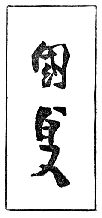
Toyokuni IV was also known as Kunisada II and as Kunimasa II. Born 1833, he died 1880. His prints, largely executed in cheap analine colours, set one's teeth on edge with some of the most shrieking discords that I have ever encountered. There exists an unfortunate collector who proudly brought back from Japan one hundred and nineteen triptychs by this artist.
Toyokuni V was also called Kunisada III and Kunimasa III. His work was worthless.
Kunimasa I (1772-1810) was an exceedingly able pupil of Toyokuni, who was influenced by Sharaku. Some of his work is very fine; he stands{353} out as one of the few notable designers of this group.
Kuninaga, who died in 1804, was a rare pupil of Toyokuni. His work is pleasant, though it has no great distinction; but it is far more attractive than the work of most of these men, for the reason that he had the good luck to die before the period of general disintegration began. The Spaulding Collection contains a fine diptych by him, in black and several shades of yellow, in the early style of Toyokuni.
Kunimitsu was also an early pupil of Toyokuni. His work is agreeable but not notable.
From the vast number of minor followers of the Toyokuni tradition, I select the following as the most common: Kuniyasu I, Kuniyasu II, Toyokiyo, Toyohiro II, Kunifusa, Kunihiro, Kunitane, Kunikatsu, Kunihisa, Kunitera, Kuniteru, Kunikane I, Kunikane II, Kunitaka, Kunimune, Kunihiko, Kunitoki, Kuniyuki, Kunitsuma, Kunikiyo, Kunihana, Kunitohisa, Kunimichi I, Kunimichi II, Kuniao I, Kuniao II, Kunitora, Kunitaki, Kunitsugi I, Kunitsugi II, Kunitada, Kuninobu II, Kuniaki, Kiyokuni, Kunimaru I, Kunimaru II, Kunichika, Chikashige, Yoshitaki, Yoshitsuru, Yoshiume, Yoshitsuna, Yoshisato, Yoshifuji, Yoshikage, Yoshikuni, Yoshichika, Yoshikazu, Yoshiharu, Shunbeni, Yoshitomi, Yoshifusa, Sugakudo, Sencho, Tominobu.
Chikamaro is said to be identical with Kiosai, whose work sometimes resembles Hokusai's. Born in 1831, he died very late in the century. He was{354} a vigorous designer—perhaps the best of all the later men. His crow pictures are famous.
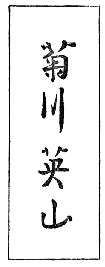
Kikugawa Yeizan, a prolific and undistinguished designer of the first quarter of the century, was a late rival and imitator of Utamaro. He eventually sank even to imitating Kunisada. The flowing draperies of some of his prints of women are at first sight attractive to eyes not accustomed to the finest works in this field; but the complete banality of Yeizan's powers becomes manifest on more prolonged acquaintance, and any trace of charm disappears.
Here may be mentioned those artists in whom the once-great Torii School came to its inglorious end.
Kiyomine, the fifth head of the school, sometimes signed himself Kiyomitsu; his work is easily distinguishable from that of the first Kiyomitsu. He studied under Kiyonaga, and later adopted a style somewhat like that of Toyokuni. His work is graceful, but not distinguished. Prints by him are rather rare. He died in 1868.
Kiyofusa, who died as late as 1892, was the sixth Torii. He also called himself Kiyomitsu III{355} and Kiyosada II. Other late members of this school were: Kiyomoto II, Kiyoyasu, Kiyotada II, Kiyotada III, Kiyosada I.
In the first half of the nineteenth century there grew into importance in the city of Osaka a group of designers who constituted an exception to the statement made earlier in this book—that the art of colour-printing was exclusively a Yedo art. Hokusai is known to have visited Osaka in 1818; and possibly it was his influence that encouraged the movement. At any rate, a large number of the Osaka group were pupils of Hokusai or followers of his manner.
The school thus entered into real activity at a date when the art was far gone in its decline; and its designs produced no arresting effect. Most of the work of these men is crude. Yet when we look at the products of the second quarter of the century in Yedo, we may very possibly feel that the Osaka output was at least no worse. It included chiefly theatrical portraits, all done with a peculiar hardness of line and cold brilliance of colour, and printed as a rule very skilfully. These by no means approach the works of Shunsho, Shunyei, and Sharaku, after which they were obviously patterned, nor even the works of Toyokuni; but the hard treatment so characteristic of them gives a certain dignity of effect which Kunisada's flowing and formless earthquakes of draperies generally lack.
The school does not call for elaborate treatment;{356} the following men may be mentioned as among the best known: Hokushu, Hasegawa Sadanobu, Sadakage, Kagetoshi, Sadafusa, Sadatora, Sadamasa, Sadamasu, Sadahiro, Sadayoshi, Ashikuni, Ashiyuki, Hirosada, Shunshi, Horai Shunsho II, Hokumio, Hanzan, Yoshiiku, and Ranko. Others will be mentioned later as pupils of Hokusai or as landscape-painters.
Like a beautiful island in the midst of a sea of wrecks, the landscape prints of the first half of the nineteenth century stand apart from the general debasement of print-designing. The great days of the figure-print were over; but now, into an art filled with the second-rate followers of Utamaro and Toyokuni, came the fresh and brilliant landscape genius of Hokusai and Hiroshige. Their work did not share in the general decline; it must be regarded as a new shoot sent up by the roots of a tree whose main trunk had already fallen into irreparable decay.
Landscape-prints were not a new thing; Utamaro and Toyohiro had already produced fine work of this nature, and interesting examples are to be found as we look backward through the work of Toyoharu, Shigemasa, Kiyonobu, and Masanobu—back, in fact, almost to the beginning of the art. But these earlier landscapes were, upon the whole, of subordinate importance; beside the figure-prints of the earlier masters, they seem crude and rudimentary. Previous to Hokusai and Hiroshige, they{357} were chiefly of topographical, not of æsthetic, intention and interest. In the nineteenth century their importance became paramount.
"Japanese colour-prints devoted to landscape," writes Mr. Strange, "form a class apart in the art of the world. There is nothing else like them; neither in the highly idealistic and often lovely abstractions of the aristocratic painters of Japan, nor in the more imitative and, it must be said, more meaningless transcripts from nature, of European artists. The colour-print, as executed by the best men of the Japanese popular school, occupies an intermediate place; perhaps thus furnishing a reason why we Westerners so easily appreciate it. Its imagery and sentiment are elementary in the eyes of the native critics of Japanese high art. Its attempts at realism are in his eyes mere evidence of vulgarity. On the other hand these very qualities endear it to us. We can understand the first, without the long training in symbolism which is the essential of refinement to an educated man of the extreme East. And the other characteristic forms, in our eyes, a leading recommendation. In short, the landscapes of artists such as Hiroshige approach more nearly to our own standards, and are thus more easily acceptable to us than anything else in the pictorial arts of China and Japan; while they have all the fascination of a strange technique, a bold and undaunted convention, and a superb excellence of composition not too remote in principle from our own."{358}
Until rather recently Hokusai was, for European spectators, as isolated and commanding a figure in the domain of Japanese art as Fuji is in the Japanese landscape. He was regarded as the one culminating and all-inclusive genius among Japanese painters and print-designers. At precisely the same time, he was esteemed by Japanese connoisseurs to be a prolific but vulgar artisan, whose mere craftsman-dexterity could not compensate for his lack of lofty feeling and poetic vision.
It is not necessary to quarrel with either of these views. Almost every student of Hokusai passes through three stages. At first, he is overwhelmed by Hokusai's technical skill and imaginative brilliance, and regards him as unrivalled. Deeper experience brings him the conviction that much of this magical dexterity is somewhat in the nature of a juggler's antics in a vaudeville, and that his first burst of enthusiasm was not wholly warranted. Then, finally, he comes to perceive that there are qualities in Hokusai's work which, in spite of so much that is vulgar, justly entitle this artist to his high fame.
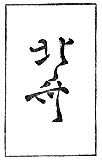
One classes Hokusai as a landscape-artist; yet his work was by no means confined to landscape. He pictured, as M. Théodore Duret wrote, "everything to be seen by the eye or invented by the brain of a Japanese." His "Mangwa," that vast twelve-volume{360} collection of drawings, includes sketches of a whole world of varied scenes and objects and people. The bulk of his production was colossal—dozens of designs a day throughout most of his eighty-nine years!
His figures are drawn with a swift and sure realism that is generally tinged with humour and often with vulgarity. His vigorous power of observing and recording faces and attitudes is almost unparalleled. Fantasy, whimsical conceits, irony, grotesqueness animate them; always they have superabundant life. The play of his brush is miraculous.
His landscapes are his greatest works. In the best of these he shakes off his trifling mood, and, as in Plate 51, creates designs whose stark brilliance and originality of composition is unsurpassed. And at least once, in the noblest of his prints—the rare and monumental series of "The Imagery of the Poets"—he achieves a high seriousness that will always be impressive.
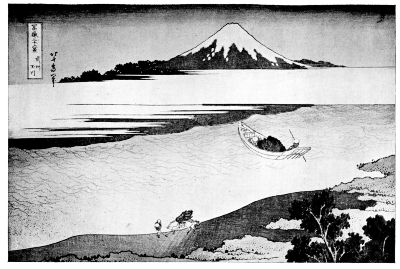
Plate 49.
Hokusai was born in 1760, the son of a mirror-maker. He lived to the age of eighty-nine years—a long life, crowded with privation that wins our sympathy, and with incessant devotion to his art. When in his seventies, he said: "Ever since the age of six years I have felt the impulse to draw the forms of objects. Up to the age of fifty years I made a great number of drawings; but I am dissatisfied with everything that I created prior to my seventieth year. At the age of seventy-three I, for the first time, began to grasp the true forms and nature of birds, fishes, and plants. It follows that at the age{363} of eighty I shall have made still greater progress; at ninety I shall be able to create all objects; at a hundred I shall certainly have attained to still higher, unimaginable power; and when I finally reach my one hundred and tenth year, every line, every dot will live with an intense life. I invite those who are going to live as long as I to convince themselves whether I shall keep my word. Written at the age of seventy-five years by me, formerly Hokusai, now called the Old Man Mad with Painting." His dying words were: "If the gods had given me only ten years more—only five years more—I could have become a really great painter!"
Hokusai's education began as an apprentice to a wood-engraver, a valuable experience for his later career. At the age of eighteen he entered the studio of Shunsho and adopted the name of Shunro. Under this name he produced actors in the orthodox Shunsho manner and melodramatic illustrations for the popular romances of the day. About 1786 a quarrel with Shunsho, due to the pupil's insubordination, led to Hokusai's expulsion, and he thereupon launched out for himself, to begin his long life of poverty and madly enthusiastic labour.
His work may be divided roughly into three periods. In the first he followed the traditions of Shunsho, Shunyei, Utamaro, and others of his contemporaries, with great skill but no special originality. His countless book-illustrations of this time were all conceived with lively fancy and vigour; but perhaps the finest works of this, his conventional period, are the very wide prints and surimono in which, against a{364} delicately suggested landscape, move extraordinarily graceful women's figures not unlike those of Utamaro. Already he was a master of drawing; but he kept incessantly at his studies under many teachers, learning, among other things, European perspective from Shiba Kokan. His work was done in this and the following periods under a dozen different names, of which Sori, Kako, Shunro, and Taito are the most important.
In 1812 began his second or realistic period, with the publication of the first book of his fifteen-volume series of drawings, the "Mangwa." In this epoch he turned from the styles of his predecessors and launched into a hitherto unknown journalistic realism. With a lively sense of the comic and the burlesque, and an insatiable interest in the homeliest details of life, he threw overboard all formal stylistic quality and set sail on a riotous voyage of naturalistic discovery.
The "Mangwa," which may serve as a type of his whole production in this realistic period, is praised sometimes as his greatest work. In it we shall find not only his most striking tours-de-force as a draughtsman but also the key to his weakness. All existence thrilled him as it did Walt Whitman; and each object on which he turned his eyes stirred him with the desire to record it in his pages. Day after day he worked like a madman, throwing off his sketches of man, beast, and phantom, of rock, river, and sea, in endless profusion and with inexhaustible ingenuity. And though we grant our admiration to the enthusiasm, sharp vision, and clever draughtsmanship of these sheets, we may still find in this undiscriminating{365} passion a quality incompatible with the highest reaches of artistic greatness. There is something vulgar, childish, under-developed in the mental attitude revealed; it seems a coarse greed for all experience, unlighted by the power to judge and reject, or by any consciousness of the ranks and hierarchies of beauty. It is a vast and dull enthusiasm; a celebration of the victory of the will to live over the will to perfect; a triumph of meaningless sensation over the just judgments of the discriminating mind. All shapes seem equally interesting and beautiful to it—all smells equally sweet. As Pater writes of Balzac—a man who was in many ways not unlike Hokusai—this artist "had an excess of curiosity—curiosity not duly tempered with the desire of beauty."
I can never look through the "Mangwa" without a sense of distressing chaos and a longing for the purer beauties which more finely organized artists have evoked from the heterogeneous welter of the seen world. But just this welter is at this time Hokusai's theme. "A debauch of sketches," Fenollosa calls it. In this work Hokusai stands beside Harunobu exactly as Whitman stands beside Keats—a more interesting mind but a far less perfect artist.
"Hokusai is incomparable," writes the commentator who furnished the introduction to one of his books. "While all his predecessors were more or less slaves to classical tradition and inherited rules, he alone emancipated his brush from all such fetters, and drew according to the dictates of his heart." True:{366} and this was his curse. No man has ever lived with heart profound and subtle enough for such emancipation. Nor have the supreme artists ever attempted it. In Hokusai's case this upstart-abandoning of all tradition was an error from which he was able later to retrieve himself; but so great was the impression produced by his vulgarities on the mob that even to this day popular Japanese art has remained under the cloud of it.
Hokusai himself did recover. In his third period, the stylistic one, the greatness that was in him transcended his petty interest in the trivial idiosyncrasies of seen things, and he created those visions which constitute his lasting glory. Between 1823 and 1830 he issued those series, "The Thirty-six Views of Fuji," "The Bridges," "The Waterfalls," "The Loocho Islands," and "The Imagery of the Poets," in which we hail him as master. No longer the dupe of realism, he brings us his dreams.
"The Thirty-six Views of Fuji" stands as one of his two greatest works. Here, in the forty-six plates that constitute the main series and the supplement, the same motive is treated recurrently, but with infinite variety. He depicts Fuji, the sacred mountain, in storm and calm, in mist and sunlight—sometimes dominating the colossally empty frame of the design, sometimes receding to a mere speck in the distance; and around the noble peak beat the waves of the sea and the foam of the clouds and the restless stream of human life, in a great epic of infinite diversity and profound unity.
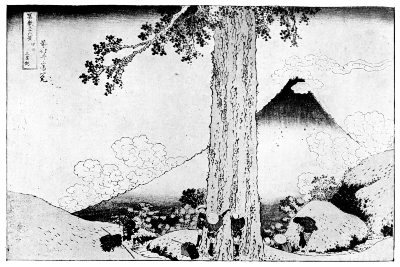
Plate 50.
In this series his trivial realism is forgotten, or{369} employed only in just subordination. Throwing aside his earlier vulgar absorption in the minutiæ of existence, he concentrated his vision on one conception, one chosen impression, so sharply and personally seen that he evoked a new style in landscape. Much it borrowed from tradition; but the flavour was Hokusai's. These designs are, primarily, magnificent studies in linear composition. The great sweep of Fuji's slope is related to the rhythm of every other line in the picture. And the line-dominance is preserved by the use of the simplest and most original of colour-schemes—green, blue, and brown—broadly laid on in large masses. A highly decorative quality and great boldness are the result.
The justly famous "Wave" belongs to this series. Here for the first time in our survey of the prints do we find elemental fury depicted with grandiose eloquence. In the majestic composition of the "Great Tree" (Plate 50) the calm sublimity of nature and the infinitely minute, vermin-like aspect of man is superbly expressed. In the "Tama River" (Plate 49) Hokusai gives us a sweep of wave and shore, mist and mountain, that his great predecessors, the landscape-painters of Sung days in China, might have envied. In all these prints he relates man and nature to each other with a vividness and dramatic power foreign to his great rival Hiroshige.
The world which Hokusai pictures in this series is not the real world, but Hokusai's highly personal translation of it into terms of superb imagination. A thousand memory-stored impressions combine to make the sharp composite of each design; and it is{370} to use the term in its technical Platonic sense, the Idea of the scene that he flashes before us. Herein lies the abnormal vitality that emanates from these pictures. "We feel," says Mr. Binyon, "that the world holds more wonders than we dreamed of, sources of power and exhilaration which Hokusai has revealed, and which we may go and discover for ourselves."
Hokusai's other great work was a series of ten upright prints of very large size, "The Imagery of the Poets." It returns in feeling, though not in technique, to the style of the classic masters; and remains, because of its high seriousness of mood and its sweeping magnificence of composition, at the very top of all Hokusai's work. Of all his thousands of designs, the one that is supreme is probably the print of this set which depicts the famous Chinese poet Li Peh beside the chasm and cascade of Luh.
Even his latest years were crowded with continued efforts. In 1849, at the age of eighty-nine years, he died.
Fine and well-preserved Hokusai prints are not common. His "Poets" and really brilliant impressions of his "Thirty-six Fuji" are very rare, particularly the former. Poor impressions of the latter are numerous. Practically all of Hokusai's most famous prints have been reproduced, and the collector must be on his guard against these worthless sheets. One of the best-known judges in Europe was recently deceived by a fraudulent set of the "Poets." Hokusai's fine bird-and-flower designs and his large early surimono are rare; as also are{373} good copies of his famous books, the "Mangwa" and the "One Hundred Views of Fuji." Numerous late blurred impressions of these are extant, and should be avoided. His other books are not uncommon.
Hokusai had many pupils; no one of them equalled the landscape work of the master, though several of them produced designs of great interest. As a body they were distinguished for their matchless work in the field of surimono.
The surimono was a type of print not sold in the market; it was made upon special order of private individuals for use as a festival-greeting, an invitation, a congratulatory memorial, or an announcement. Its size was generally small, about five or six inches square; printed on very soft thick paper, it displayed the utmost complexity of the technique of colour-printing. The number of blocks was lavishly multiplied; the most subtle gradations of colour were contrived; and the effect was heightened by every variety of gauffrage, gold, silver, and bronze powders, and mother-of-pearl dust. Yet in spite of all this effort, the surimono is, in the opinion of many collectors, not as a rule very important as a work of art. In the ordinary surimono the medium employed has outstripped the motive expressed, and what should have been the means has become the sole end. Nevertheless they are unrivalled as specimens of workmanship and printing, and the best of them are highly treasured. Some of Hokusai's pupils excelled their master in this form.{374}
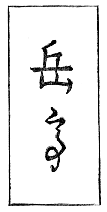
Gakutei, who also signed himself Gogaku, produced perhaps the finest surimono of any that we know. His work in this field was voluminous and distinguished. He also issued a few exceedingly decorative landscapes.
Hokkei stands beside Gakutei as a brilliant producer of surimono, closely in the manner of Hokusai. Some of his landscapes, printed in blue and green, have a curious charm and individuality.
Hokuju produced landscapes in a strange semi-European style, with angular mountains and unusual cloud effects.
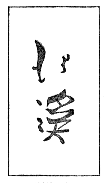
Yanagawa Shigenobu, the son-in-law of Hokusai, copied his master closely; some of his work has great charm. According to some authorities he is the same person to whom Hokusai gave his discarded name, Katsushika Taito. Certain prints signed Taito are still somewhat in doubt, notably the well-known leaping fish and the moon-and-bridge scene, both from the "Harimaze Han"; Mr. Happer has brought forward evidence that these are by Taito, but many authorities still hold to the idea that they are the work of Hokusai under his early name{375}. Among the numberless Hokusai pupils may be named: Hokuba, Hokuga, Niho, Shigeyama, Gokei, Shinsai, Isai, Hokuun, Hokuyei, Hokutei, Hokutai, Hokusui, Taigaku, Renshi, Juzan, Yasumichi, Bokusen, Keiju, Ryusai, Gangakusai, Keiri, Hokuyo.
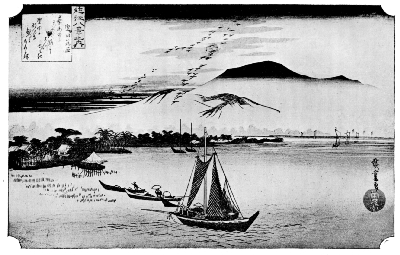
Plate 52.
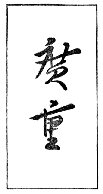
Hiroshige takes rank by unanimous consent as the foremost landscape artist produced by the Ukioye School. His prints, known to every one, have been more greatly admired in Western lands than the prints of any other artist except Hokusai. Hokusai's main concern was with the fundamental architecture of landscape; he outlined the structure of mountains, rocks, rivers, waves, and bridges with a hard and brilliant sharpness; but Hiroshige, less rigid in his treatment, seems chiefly intent upon the more delicate and transitory appearances of cloud and mist, rain and snow, sunrise and dusk, that give to a landscape at each moment so much of{380} its specific character. These atmospheric effects of his are justly famous. Few landscape painters of any race have succeeded in rendering so finely the mood of a scene. No one can be insensible to the delicate peace and sweetness of a twilight like that of Plate 52, or the vigorous life of wide sea spaces in Plate 53, or the heavy hush of nightfall over the snow-covered village of Plate 54. Even more impressive are the luminous and solemn dusk on the Sumida River (Plate 55) and the mystery of the print called "The Bow-Moon" which appears as the frontispiece.
The Bow-Moon.
Hiroshige's great strength lay in his genius for strikingly effective composition, and in the skill with which he adapted his designs to the limitations of the colour-print technique. He reduced the pictured scene to a few simple elements of a highly decorative character, and managed to make them so symbolic and suggestive that we do not miss the multitude of details which he purposely omits. A strongly dominant unity of impression is the result. His finest designs convey a sense of personal feeling that even the Barbizon artists at their best do not surpass. With the limited resources of the wood block, he achieved subtle renderings of distance, aerial perspective, atmosphere, and light; and the poetic quality of his designs has endeared him to generations of print-lovers in a way more personal than is the case with any other artist. His work will stand beside the "Liber Studiorum" of Turner; it remains perhaps the most complete and magnificent landscape record that any land has ever had.
One curious characteristic of these prints at once strikes the Western eye—the use of a band of dark colour along the top of the picture, which is shaded gradually down into the clear white of the lower sky. This convention serves several purposes. It provides a mass to balance the colour at the bottom of the design, bringing the whole sheet into the picture and not leaving the upper portion as a mere margin above the landscape proper. It also creates depth and atmosphere, setting the brightest part of the design, the middle, back into the frame created by the upper and lower masses. And finally, it renders with{382} peculiar accuracy the effect of gradual vanishing which we actually experience as we look at a landscape: in our visual field, the sky does not end in a sharp line, but blurs and darkens at the upper edge of the space that our eyes survey.
Hiroshige's bird and flower designs are works of extraordinary freshness and loveliness; a unique and idyllic charm emanates from them, and as compositions they take high rank (Plate 56).
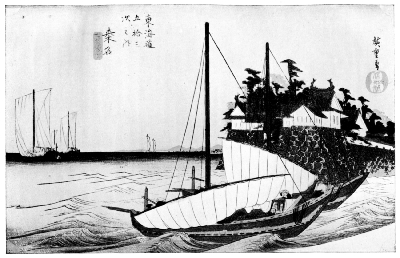
Plate 53.
Hiroshige was born in 1796, just as the great period of figure-designing was drawing to its close. As a youth he attempted to gain entrance to the studio of Toyokuni; but the fortunate fact that there was no room for him forced him to enter the studio of the less popular but more subtly gifted Toyohiro. Here he studied landscape, a branch in which he was destined far to outstrip his master. That delicate genius which was Toyohiro's cannot but have produced its effect upon the pupil; and it pleases one to fancy that it is some echo of Toyohiro's inarticulate{386} refinement of feeling that gains at last full expression in some of Hiroshige's most beautiful landscapes.
In 1828 Toyohiro died; and Hiroshige became independent. His earliest works probably antedate this time a little; they consist of a few figures of women and actors, and two very fine horizontal landscape series. These were the "Toto Meisho," or earliest series of Yedo views, distinguished by curious long red clouds in each plate; and the "Honcho Meisho," a group of views of the main island of Japan. Particularly the first of these sets contains work of great beauty.
Shortly after 1830 Hiroshige found occasion to travel from Yedo, the northern capital, to Kyoto, the southern capital, along the great post-road which he has immortalized—the Tokaido. There resulted his series of horizontal plates, "The Fifty-three Stations of the Tokaido," completed about 1834. This remains his best-known and unsurpassed work. Plate 53 is from this series. Each picture records with unfailing vividness and originality some famous scene along the crowded national highway. For reasons unknown to us, Hiroshige prepared new designs for some of the plates after the original publication of the series; and these variation-plates are of great interest to collectors.
Of the many series that followed, only the most important can be named here. All are of horizontal shape unless otherwise designated.
Naniwa Meisho, ten views of Osaka—chiefly crowded wharf and market scenes.
Kyoto Meisho, ten views of Kyoto; a varied and delightful series containing many fine prints.{387}
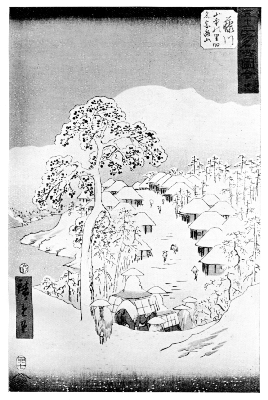
Plate 54.
Omi Hakkei, the Eight Famous Views of Lake Biwa; the most poetic and possibly the greatest of his works (Plate 52).
Kanazawa Hakkei, the Eight Famous Views of the Inlet of Kanazawa; distinguished by a fine simplicity of composition.
Yedo Kinko Hakkei, the Eight Famous Views of Yedo; a series of masterpieces, of great rarity.
Chiushingura, sixteen scenes from the story of the Forty-seven Ronin; fine dramatic compositions, with powerful blacks and greys predominating.
Toto Meisho and Yedo Meisho, names under which more than fifty different series of Yedo views were issued by different publishers. These sets include many masterpieces.
Nihon Minato Tsukushi, ten views of the Harbours of Japan.
Toto Meisho, a series of narrow upright panels of Yedo; several are very distinguished.
Mu Tamagawa, views of the Six Tama Rivers.
Series of Fishes.
Kwa Cho, upright panels of birds and flowers, some on full-sized sheets, others very narrow; uneven in quality, some being masterpieces (Plate 56).
Fan Prints, with landscapes or bird designs.
In the year 1842 began the so-called Prohibition Period of twelve years, when the sale of actor and courtesan prints was forbidden. The effect of this was to redouble the demand for landscape prints; and Hiroshige was called upon to supply it. This he did by issuing, among others, the following sets:{390}—
Tokaido Series, published by Maruzei; next best to the "Great Tokaido Series" of 1834.
Tokaido Series, published by Yesaki; slightly smaller than the "Great Series"; when well-printed, which is rare, they take a very high place.
Tokaido Series, published by Sanoki, half-plate size; including many charming designs.
Kisokaido, the Sixty-nine Stations of the Kisokaido Road between Yedo and Kyoto; a series in which Keisai Yeisen collaborated, producing twenty-three of the seventy plates. Many of the plates are uninteresting; but a quarter of them are superb. The set was reprinted at least twice in inferior editions.
In this, which we may call the Kisokaido Period of Hiroshige's work, he abandoned to a certain extent the delicate drawing of his Great Tokaido and Yedo Period and employed larger unbroken colour masses, aiming at broader effects.
In the fifties, Hiroshige abandoned almost entirely the horizontal or lateral prints of his earlier days and adopted the upright shape. In this form he produced the following series, as well as others not named:—
Upright Tokaido, published by Tsutaya, 1855; a fine series when well printed, but the late editions were crude in colour (Plate 54).
Views of the Sixty-nine Provinces, 1856; the rare first edition, which is much the finer, is distinguished by having five seals on the face of each plate. It contains a great deal of uninteresting work, but also ten or fifteen masterpieces.{391}
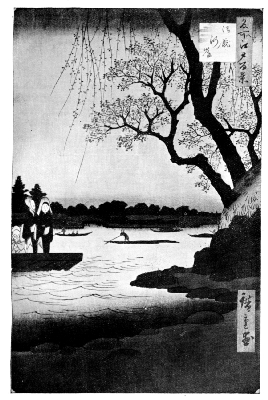
Plate 55.
Three Triptychs.—The Rapids of Awa No Naruto, Moonlight View of Kanazawa, and Snow Mountains on the Kiso Highway, all dated 1857, and all magnificent.
Two Kakemono-ye, very large—the Monkey Bridge and the Snow Gorge of the Fuji River, things of matchless impressiveness.
The One Hundred Views of Yedo, 1858; 119 plates, including, besides much rubbish, 25 masterpieces (Plate 55).
The Thirty-six Views of Fuji, 1859; inferior, upon the whole, to his earlier work. There are in existence very few well-printed copies.
In the last two or three of these series it is more than probable that Hiroshige was assisted by his pupil Hiroshige II. The finest plates in all these later series are equal to the master's most splendid earlier designs; but certain of the plates are of so banal a character that it is impossible to believe them to be from the great man's hand. Doubtless the distinction between the work of the two artists cannot always be drawn with certainty; but as a general rule we may regard the work as that of Hiroshige II if we find the figures stiff and wooden, if the composition is lacking in any central unity, or if some large ugly object is thrust into the foreground with the hope of thus putting the background into its proper relative place. At this period less care was taken with the printing, and the majority of prints from these later series are miserable impressions that libel Hiroshige's powers. When well printed they can be very fine indeed; but the{394} poor copies outnumber the good a hundred to one.
In the year 1858, just after the publication of the "One Hundred Views of Yedo," Hiroshige died. He did not live to see the plates for his "Thirty-six Views of Fuji" completed. One of the collector's treasures is a striking memorial portrait by Kunisada that was issued shortly after Hiroshige's death. The old man is represented with a finely shaped head, powerful, quiet features, and eyes as piercing as an eagle's.
The number of Hiroshige's different designs runs into at least three or four thousand, not counting his illustrated books; and there must be in existence a hundred thousand prints by him. His work is almost as plentiful as that of all the other artists taken together. In spite of this great abundance, the collector finds it difficult to-day to obtain many really fine prints by him. The prints usually offered are either in bad condition, or they are careless impressions produced without proper attention to the difficult problem of printing. The rush occasioned by Hiroshige's popularity naturally led to slighted work. Even in these poor copies a certain fascination of design generally appears; but it is only in the carefully printed copies, where the register is accurate and the colours are delicately graded, luminous, and soft, that the full beauty of Hiroshige's conception is made clear. Familiarity with the finer impressions forever spoils the attentive observer's taste for the crude ordinary copies. The task of the collector of Hiroshige's work to-day resolves itself{397} into a search for these rare and precious early prints. The collector should lose no opportunity to compare different copies of the same print; only thus can he educate his eyes sufficiently to appreciate the vast difference between fine and inferior examples. The difference, once grasped, is unforgettable.
The reader who desires detailed information as to the long list of Hiroshige's work is referred to the Sale Catalogue of the Collection of John Stewart Happer (Sotheby, Wilkinson, and Hodge, London), which is the present foundation for any real study of the subject. A valuable article on seal-dates by Major J. J. O'Brien Sexton, in the International Studio for May, 1913, should also be consulted by the student.
Hiroshige II, born 1826, was the adopted son of the great Hiroshige; as we have seen, he probably assisted in some of the master's last work. After Hiroshige's death the pupil assumed the master's name, previous to that he had been known as Ichiusai Shigenobu. He is not to be confused with Yanagawa Shigenobu, Hokusai's pupil.
It was once thought that Hiroshige II produced all the upright prints signed Hiroshige. Mr. Happer has once for all discredited this idea, and it is no longer held by any one.
Some of the work of Hiroshige II is very good; upon the accidental destruction of one of the plates of the "One Hundred Yedo Series," he produced a new design that is admirable. But he lacked originality,{398} and at his best merely trod in the footsteps of his master. Most of his designs are flat and uninspired. About 1865 he fell into disgrace, and moved to Yokohama, where he gave up his name, and is said to have worked henceforth under the name of Hirochika II. He died in 1869.
There was also a Hiroshige III, who died in 1896—a wholly commonplace and unimportant artist, who assumed the great name about 1865.
Keisai Yeisen, who collaborated with Hiroshige in the "Kisokaido Series," was born in 1791 and died in 1851. He produced many figure-prints, following Yeizan, in the debased style of his contemporaries. His landscapes, however, are his most interesting work. Many of these follow Hiroshige tamely; but a few, in the older Kano manner, are surprising and splendid designs. One of these, a rare sheet depicting a bridge and mountains in moonlight, in kakamono-ye form, must be regarded as a masterpiece. His ordinary work is rather undistinguished.
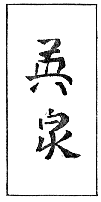
Gosotei Toyokuni produced, besides some unimportant actor-prints, a few fine landscapes in a very hard, sharp style. Chief among these is a "Tamagawa Series," each plate of which has a large{399} purple panel at the top. The artist's original name was Toyoshige. Born in 1777, he became the adopted son of Toyokuni I; after Toyokuni's death in 1825, he married Toyokuni's widow and called himself Toyokuni II, a title which Kunisada also claimed.
Utagawa Kuniyoshi, born in 1798, was the best pupil of Toyokuni I, and an artist of more power than most of his contemporaries. His figures sometimes have dramatic force of a rather fine kind; but the majority of them are crude. His landscapes are his greatest claim to fame. Among them are some of extraordinary quality. They have hardly been sufficiently appreciated as yet by collectors. Kuniyoshi died in 1861.
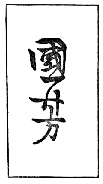
Katsukawa Shunsen, a pupil of Shunyei, produced, besides ordinary figure-prints, a few graceful landscapes, chiefly in tones of green and rose.
Hasegawa Sadanobu, who has been mentioned under the Osaka School, was an arrant imitator of Hiroshige. The Hayashi Catalogue, page 236, reproduces a print of his that is nothing more than a replica of one of Hiroshige's "Sixty-nine Province Series"; and the Victoria and Albert Museum Catalogue, Plate XLVI, shows a Lake Biwa print that copies Hiroshige's half-plate "Omi Hakkei" almost line for line.{400}
Sadahide and Yoshiyuki, both Osaka artists, may be mentioned among the unimportant landscape designers of the second half of the nineteenth century.
To-day the old art of the colour-print is completely dead. But an entirely new school has produced some pleasing though weak designs of birds, flowers, and landscapes; and some attractive illustrated books have also been issued. The larger part of such work bears the obvious stamp of having been produced for the tourist and the foreign market, and has not a trace of that vigour and integrity which marked the prints of the great masters, whose inspiration sprang from and spoke to the heart of the Japanese people. European influence has produced a bad effect upon the style of these modern prints; and the weak colour used tends toward prettiness rather than toward beauty. It is idle to hope that real vitality will ever return to animate this lost art.{401}
The field of Japanese prints is so wide, and the cost of different classes of prints is so various, that almost any taste and almost any pocket-book can find appropriate material for collection. A print-lover who is prepared to invest considerable sums of money, running perhaps into many thousand pounds, will naturally seek only important examples from the hands of the most renowned designers. A great collection must in the first place contain representative specimens of the distinctive manners of the notable men in each period; and in addition a great collector will wish to acquire considerable numbers of the supreme treasures—large-size Primitives, Harunobu pillar-prints, Kiyonaga triptychs, Utamaro silver-prints, Sharaku portraits, matchless impressions of Hiroshige landscapes, and the like. But even the modest collector who is able to expend only a few pounds a year can, with patience, secure beautiful and desirable pieces. It would be vain for him to imagine that he can have things of the first importance and rarity; but he may confidently expect to obtain delightful minor examples of the{404} work of even great artists, at prices that are within any one's reach. A Yeishi triptych will cost from ten to eighty pounds, but a charming small sheet by Yeishi can perhaps be bought for two. The pleasure which the collector obtains from his collection is not necessarily proportionate to the amount of his expenditure; and the intelligent lover of beauty can derive lasting satisfaction from his carefully selected but inexpensive little group of Hiroshige landscapes, Shunsho actors, Harunobu book-illustrations, and similar works.
When, however, the owner of some such sheets finds his ambition is growing with his interest, he needs to be somewhat cautious in his effort to extend his collection. A few charming minor prints are a highly desirable possession; a large collection of them is not. It is easy for the lover of prints who has begun modestly to go on year after year with increasing enthusiasm, piling up numbers of cheap mediocre sheets; and in the end, after having spent enough money to purchase ten great Kiyonagas, he finds himself the owner of a numerous but undistinguished collection in which there is not a single print of the first rank, nor a single one that will compel the admiration of the connoisseur. It is interesting to have a few prints of each type and period as examples, even though they are not notable works; but when the collector has a moderate number he will be wise to cease his miscellaneous buying and husband his resources for the occasional purchase of a masterpiece. More pleasure is to be found in acquiring two or three fine sheets a year{405} than from the wholesale acquisition of hundreds of insignificant works.
It is, however, well to define one's limits carefully. If one is not able to expend from ten to a hundred pounds on a single print, one must dismiss from one's mind the idea of owning an important Kiyonaga; for that is the lowest sum at which one can hope to get it even with luck. If an expenditure of thirty to eighty pounds is impossible, one must put aside all idea of a Sharaku. But lesser treasures at lower prices are to be had; let the collector only remember to take care that he gets the best things he can afford even though his purchases be few, rather than allow himself to be tempted into buying a great many of a cheaper kind.
Remarkable opportunities to acquire fine prints at low prices sometimes occur, but they are rare. Certain prints may come up for sale only once in a collector's lifetime. These exceptional examples must be seized when they are offered; one of the characteristics of a great collector is the ability to make these swift and often expensive decisions. He must know the available supply of prints and the probability of having another chance to get this particular sheet; if he estimates such a recurrence as improbable, and if he esteems the print a masterpiece, he must take it at any price he can afford to pay.
It is, after all is said, the masterpieces that bring the unwaning satisfaction. Most collectors find that the few supreme treasures of their collections give them more pleasure than all their other prints put together. Therefore it is well for the inexperienced{406} collector to bear in mind that quality, not quantity, will prove his most profitable aim. For it is one of the delightful characteristics of collecting that the collector's perception is likely to grow continuously in fineness; and the acquisitions of his earlier years may fail to satisfy his more educated taste of later days. This will sometimes be true of even the prints he once loved best; and much more is it likely to apply to those which he bought merely because they were cheap or would increase the bulk of his collection.
Discrimination is the life-blood of collecting. He who collects everything collects nothing; he is the owner of a scrap-heap or a second-hand shop, not of an ordered series of specimens that illustrate historical or artistic ideas. The true collector would rather have ten selected prints than the whole mass of prints now in existence, if in the latter case he had to keep them all. Many a collection has been improved both in monetary value and in power to give pleasure by merely throwing out of it the second-rate things it contained.
The collector, as a rule, sets out in the beginning with little knowledge and with no very definite notion of what he intends to collect. If he is to profit by his efforts or is to end by having an interesting group of possessions, he must before long define for himself the idea of a collection and the conception which his own is to express. He may decide to obtain at least one representative example of the work of every important artist; or he may prefer to specialize, and assemble all that he can of{407} the works of a single man or a single period. A certain well-known collector has selected Harunobu and Shunsho as his special objects of interest, and has brought together a notable and illuminating series of specimens of their work. Another has chosen Hiroshige, and after many years of effort he can display to the student a fine copy of almost every important print by that artist. A third has especially sought the works of Kiyonaga; while a fourth has pursued the less costly but very interesting aim of bringing together the sheets of Kuniyoshi. Another is devoted to surimono; still another, to pillar-prints. The possible list of specialities is inexhaustible. Narrow and exclusive specialization is, however, uncommon among amateurs of Japanese prints; and even the specialist tries to have in his collection a few representative examples of all important types.
The inexperienced collector may find himself confused, amid so many unfamiliar names, and fail to separate in his mind the notable artists from those of secondary interest. A little study of the following list will perhaps be of assistance. It contains thirty-two names, selected from the three or four hundred mentioned in this book; each one in the list is important, and a collection that contained even one fine example by each of these designers would represent very fairly the whole scope of the art. In fact, the beginner will not go far astray if at the outset he confines his purchases to the work of the men here listed; he will at least be saved from the danger of accumulating the productions of unnoteworthy{408} designers. The names preceded by two stars are the ten outstanding figures whose historical and artistic importance makes it imperative that they be adequately represented in any self-respecting collection. Thirteen more names, preceded by one star, are of next conspicuousness. A collection containing a really brilliant example by each of these thirty-two men would cost from three hundred to three thousand pounds to bring together, depending upon the quality and importance of the prints selected.
| * | Buncho |
| * | Choki |
| ** | Harunobu |
| ** | Hiroshige I |
| ** | Hokusai |
| * | Kiyomasu |
| * | Kiyomitsu I |
| ** | Kiyonaga |
| * | Kiyonobu I |
| * | Kiyonobu II |
| ** | Koriusai |
| * | Kwaigetsudō |
| Masanobu (Kitao) | |
| ** | Masanobu (Okumura) |
| ** | Moronobu |
| ** | Sharaku |
| * | Shigemasa |
| * | Shigenaga |
| * | Shuncho |
| Shunko (Katsukawa) | |
| Shunman | |
| ** | Shunsho |
| Shunyei | |
| Sukenobu | |
| Toshinobu | |
| Toyoharu | |
| Toyohiro | |
| * | Toyokuni I |
| * | Toyonobu (Ishikawa) |
| ** | Utamaro I |
| * | Yeishi |
Collecting is to a certain extent creative; for the picture of the art of Japanese prints that a collection presents is almost as definitely an expression of a personal interpretation as is a book on the subject. What the collectors treasure will be preserved; what they reject will doubtless perish as valueless.{409}
One of the collector's joys is the sense that he is laying by immeasurable riches for posterity. Much remains for us still to learn from Japanese prints; and any sheet in a collection may prove to be the key that will some day unlock doors leading to treasure-chambers. Both historically and æsthetically, the field of Japanese prints still offers many undiscovered regions to the explorer. By making available the material for such investigations, the collector performs a valuable service.
The collector's own satisfaction is not dependent upon the fact of possession. To seek, to desire ardently, is not to covet; and the most eager collectors are the very ones who most thoroughly enjoy a beautiful print owned by another. Possession is an accident; but enjoyment is a form of genius.
Collecting at its best is very far from mere acquisitiveness; it may become one of the most humanistic of occupations, seeking to illustrate, by the assembling of significant reliques, the march of the human spirit in its quest of beauty, and the aspirations that were its guide. To discover, preserve, relate, and criticize these memorials is the rational aim of the collector. The joy of pursuit which he experiences is a crude but delightful one; and discovery has the triumphant sweetness of all successful effort. The act of restoring and preserving is a pious service to the future, and a delicate handicraft. To arrange examples in accurate relation to each other, and illustrate a conception of complex history by means of concrete{410} specimens, is a constructive task that involves detailed knowledge and wide vision. And finally, the attempt to appraise the spiritual values of the parts and the whole may be an illuminating achievement, relating all this material to the general stream of cultural development and to the history of the race.
The best way to study an art of the past is to collect examples of it. The collector's historical sense is trained and his discriminative powers are sharpened by his activities. As his education progresses, his chief interest is in works of an ever higher quality. He attempts always to acquire the best, and his knowledge of what is best is always widening. His is the task of judging between degrees of perfection. It differs not so very widely from that desperate search for an ideal fulfilment which is the curse, the inspiration, and the one abiding joy of the artist.
The artist's sense of triumph in an achievement must be only momentary; if he continues long to regard his creation as admirable, he has reached the stagnation of his powers and the end of his career; he must ever hate to-day what he created yesterday, in order that he may be driven on to produce a still finer thing to-morrow. The collector, also, must eventually abandon his present position and move forward; and, tragic to confess, perhaps his ultimate triumph comes on that day when the field he long has loved ceases to suffice his growing sense of beauty, and he sends his collection under the hammer, having mastered it and passed beyond it.{411} For every collector must in the end transcend his collection, unless he is to perish in it as in some fatal Saragossa Sea.
A collection is a life-estate only, and the important question confronts every collector as to what disposition shall be made of his possessions after his death. My personal feeling is strongly against the bequest of such a collection to a public institution. These prints are inherently suited to private exhibition and not to public display. They must be kept in portfolios, not hung up in galleries, or they fade. They must be examined closely and at leisure; the spectator should be able, seated at ease, to study them as he holds them in his hand. To walk through a gallery of prints is only a slight pleasure; to sit in the library of the collector and inspect and discuss the same prints one by one is a great delight. Further, they require a degree of care that they would not receive in the public institutions. The prints in most public collections are repaired, mounted, and handled with a carelessness that horrifies the collector. That painstaking skill in restoring, preserving, and mounting to the best advantage, which means so much for the ultimate effect of a print, is seldom, if ever, exercised except by the private owner. It may be said that if these treasures are in private hands, the public is deprived of them. This is untrue. The great body of the public would pass them by in a gallery, for this is not a spectacular or obtrusive art like sculpture. On the other hand, any person who gives evidence of a reasonable degree of interest can{412} not only obtain free and willing access to all the private collections with which I am familiar, but he may have at his disposal the services of the owner of the collection to explain, interpret, and guide. There are at present scores of highly trained men, of such cultivation as the museums cannot afford to employ except in the highest positions, who are spending weeks and months out of every year in this unpaid work of serving the public; while in the great public collections the ordinary inquirer is left adrift to find his way as best he can through the chaos of an improperly arranged exhibit. In the public collections the prints are of service or pleasure to almost nobody; while in the private collections their service and pleasure to the owner and his friends is great, and the same opportunities are easily opened to any one who is qualified to profit by them. Therefore it seems better that, upon the death of a collector, his prints should be sold; in order that, as Edmond de Goncourt directed in the case of his collection, those treasures which have been so great and so personal a delight to the owner may pass on into the hands of such others as will find in them the same satisfaction. "My wish is," he wrote in his will, "that my drawings, my prints, my curios, my books—in a word those things of art which have been the joy of my life—shall not be consigned to the cold tomb of a museum, and subjected to the stupid glance of the careless passer-by; but I require that they shall all be dispersed under the hammer of the auctioneer, so that the pleasure which the acquiring of each{413} one of them has given me shall be given again, in each case, to some inheritor of my own taste."
A variety of elements must be weighed in the mind of the collector whenever he decides for or against the purchase of a particular specimen to add to his collection.
The Artist.—In the first place, the authorship of the print is an important consideration. If the designer is a very great man like Kiyonaga, or a very rare one like Kitao Masanobu, or both combined like Shigemasa, these facts must be given weight. Other things being equal, a print by an important leader such as Utamaro is more desirable than one by a less original follower such as Banki. A Kiyonaga is a little preferable to an equally beautiful Shuncho, because of Kiyonaga's prime historical importance. The work of certain other men is prized by collectors because of its scarcity; Chincho, for example, would be only moderately valued were it not for the extraordinary rarity of his designs. When rarity combines with greatness, as in the case of Kwaigetsudō, Moronobu, Buncho, and Sharaku, the desirability of the artist's work is naturally doubled in the eyes of the collector.
A print sometimes derives an unusual interest from the fact that it is of a kind seldom produced by the particular artist who designed it. Harunobu and Kiyonaga actor-prints are exceptional things, dating from the early years of these men's careers.{414} On the other hand, the silver-prints of Utamaro, the triptychs of Kiyonaga, and the yellow-background prints of Yeishi are desirable for the opposite reason; they represent famous and characteristic aspects of the work of their respective creators.
The Quality of the Design.—The impression produced upon the æsthetic sense of the collector is the most vital of all the elements that determine his choice. The composition, the drawing, the total beauty of the design, will in each individual case have their importance; and upon the collector's estimate of these qualities will depend his desire to own the print. There are some dull and uninteresting designs by even the most gifted men—work without charm or life. Shunsho was a great sinner in this respect; so also were Utamaro and Toyokuni. On the other hand, men of secondary importance produced occasional triumphs; a Yeisho or a Yenshi is sometimes found in which the most brilliant qualities of composition appear. Each print must be appraised on its own merits.
The collector generally passes by all designs in which clumsiness or awkwardness is evident, and waits patiently for those in which the force, or grace, or dignity of the composition proclaims the masterpiece. Kiyonaga's "Terrace by the Sea," Sharaku's portrait of the Daimyo Moronao, Hokusai's "Red Mountain," and Utamaro's "Firefly Catchers" are examples of that unsurpassable quality which no experienced collector willingly lets escape him.
The Quality of the Impression.—Different copies of the same print differ enormously in quality. The{415} finest design is of little avail if the work of the printer has not been judicious. Among early prints, before Utamaro, really bad impressions are not very common, although especially fine and brilliant ones are hard to obtain. Later, particularly in the work of Hiroshige, the poor ones much outnumber the good. In a good impression the lines are all sharp and clean: where the hair meets the temples, every brush-stroke is clearly defined. The blacks are rich and heavy, not sooty or streaked. The colours must be in perfect register; that is, each must exactly fill its allotted space without overlapping and without ragged edges. Prints in which these defects occur are either careless impressions or late impressions from worn blocks. Whichever be the explanation, they are not desirable; the discriminating collector does not care to acquire any but perfectly printed sheets. All the skill and devotion of the printer was needed to make the resulting product a just interpretation of the conception of the designer; in a bad impression the beauty of the design is ruined.
Prior to the nineteenth century it was the usual practice to give each colour-block a uniform coat of pigment; thus each separate colour impressed on the paper was completely flat and unshaded. In Hiroshige's time, however, the pigment was often partially wiped from portions of the block, so that in the resulting print the colour shades gradually into the uncoloured white of the paper. Many of Hiroshige's prints derive a considerable portion of their beauty from the subtlety of these gradations.
There are no such things as signed artist's proofs{416} among Japanese prints; but there is a class of prints that corresponds to them. They are not labelled; nothing distinguishes them from the ordinary copies except the extreme beauty of the printing. These rare impressions were probably early ones made under the eye of the artist. The sharpness of the lines, the harmony of the colours, and the delicacy of gradation in any shaded portions are of a perfection lacking in the ordinary copies. It took much care and time, and was therefore expensive, to produce such work; and probably the majority of purchasers were unwilling to pay the additional price entailed by this degree of attention. The few existing copies of this character are exceptionally prized by the collector to-day.
The colour-schemes used in printing various copies of the same print often differ widely, and there is considerable difference in desirability on this ground alone. Some of Hiroshige's prints are found in monochromes of blue or of grey—some of Hokusai's are in bluish green. These rare and beautiful variations from the normal are highly valued. On the other hand, the late prints of Hiroshige are generally printed in raucous greens and reds and purples that are an offence to the eye; and only rarely do we find copies of them in which a soft and harmonious colour scheme reveals the intention of the artist. This explains why certain prints from the "One Hundred Views of Yedo" sometimes bring fifteen or twenty pounds apiece, though multitudes of ordinary copies of the identical print can be purchased for a few shillings each. Badly coloured{417} examples of Hiroshige's work are plentiful and of little value; harmonious and subtly modulated ones are things of unsurpassable beauty, and almost as rare as Kiyonagas. The collector of Hiroshige prints will scrutinize a specimen with the utmost care to determine whether the colour scheme is harmonious, and whether the pigments have been applied in the delicately graded luminous manner that Hiroshige intended. If he finds that the various tones are harsh in quality, or are printed in crude, unshaded masses, he will reject the sheet. Considerable familiarity with really fine impressions is the only safeguard in this matter. The beginner is only too ready to be led astray by the charm of the design, not realizing how much this same design is enhanced if given the expression of appropriate printing; and he is very likely to find himself loaded down with worthless impressions, the very sight of which is repugnant to him after he has become familiar with fine copies of the same prints. Poor copies are worth nothing; but choice ones are never really dear at any price.
In this matter more than in any other a fine collection differs from a poor one, and it is in this that the discriminating collector has his best chance to match his judgment against that of the dealer. Sometimes one can for a few shillings select from a pile of worthless Hiroshiges a notable impression that is worth twenty times the sum asked for it.
A generally accepted classification of prints from the point of view of the quality of the impression would be convenient. There are to-day no recognized{418} terms by which to describe the various grades. I therefore suggest a division into four groups with the following terminology:—
(a) Artist's Impression.—Such a print as might have been produced under the eye of the artist himself—every line clear and sharp, every colour delicate and perfectly registered; the total effect exceptionally luminous and harmonious; no possible subtlety of technique left to be desired.
(b) Fine Impression.—A clear, perfect impression such as a careful printer would normally turn out at his best, but without that inspired fineness in every detail which distinguishes Class (a).
(c) Good Impression.—Such a print as would pass muster with the ordinary buyer of that day—good, but not especially fine; clear, but not notably sharp; pleasantly enough coloured, but not distinguished in colour scheme. Very slight defects of register or of gradation will not exclude a print from this class.
(d) Late Impression.—One in which serious defects appear, such as bad register, raw colour, blurred definition, or any other real error.
Condition.—The state of preservation is one of the most important elements that the collector has to consider. Collectors of Japanese prints do not as a rule pay much attention to questions of margin, but they very properly insist that the effects of time and wear shall not be such as to obliterate or diminish the original beauty of the work itself. The print must not be cut down in size, and its face must be unmarred. Stains, creases, tears, abrasions, discolorations{419} and fading are all defects of a serious nature. Only experience can enable one to judge whether a certain print is of such rarity that one must waive requirements as to condition and accept a defective copy. In the case of the Primitives, flawless examples are so few that one must needs be content with prints that show decidedly the effect of time. The same is true of pillar-prints. On the other hand, there is no reason why one should ever purchase a damaged Hiroshige, unless it be an exceptional rarity like the "Monkey Bridge." On the whole, the experience of collectors is that in every case of doubt the faulty print should be rejected. For as one sees a print repeatedly one's consciousness of the defect increases, and gradually the flaw becomes more obvious to one's observation than anything else in the print.
In many cases prints that are in undamaged condition have nevertheless acquired with age a peculiar deadness that may not be perceptible to the careless eye. If such a print is placed beside a perfectly fresh one, the difference is at once apparent. In the first case, though the surface is unmarred, there is a slight yellowing of the fibres of the paper that prevents their sending out that vibrating luminosity which is a distinctive beauty in the immaculate copy. This absence of luminous quality is so common that I mention it less to caution the collector against it than to bid him be on his guard to seize the few luminous prints that are offered him.
It is against the really brown prints that the{420} novice should be warned. The difference in market value between a chocolate coloured copy and a brilliantly white copy is enormous, amounting in some cases to a thousand per cent. Brilliant copies are excessively rare; and since they are the only ones desired by the great collectors, they bring record prices.
The whole question of condition is one of personal taste; collectors are by no means agreed about it. European collectors have been, as a rule, less insistent upon condition than have the Japanese and Americans. There are collectors—though they grow fewer daily—who positively prefer faded and "toned" prints, because of their softness. This view is an ill-advised one.
I do not say that, if one can have none other, the damaged prints may not give one pleasure and intimations of the original beauty that was theirs; but I do affirm that such prints are but makeshifts, and that their market value is, and always will be, very slight. When I began collecting many years ago in Japan, I purchased a number of Hokusai prints that were much blackened by exposure. I thought at the time that any trace of the work of so famous a master was worth treasuring. But I have found that my purchase was quite valueless, not only from the commercial point of view, but also from the artistic, since they do not represent the work of Hokusai with the slightest approach to adequacy.
Perfect condition conveys to us perfectly the artist's conception; anything else obliterates or modifies his design. Though the beauty of faded{421} or damaged prints is often indisputable, and though some prints are so saturated with beauty that a certain charm remains as long as any trace of the printing is visible, yet these wrecks and fragments are not the desirable specimens. The slight softening of the colours that almost always comes with age is perhaps not detrimental; but when the luminosity of the colours and the brilliant whiteness of the paper is gone, an irreparable loss has been suffered. For the white spaces and the reflective effect of the white fibres under the coloured spaces were integral and vital elements in the artist's design; and one cannot say that this is not injured when the paper has been turned to a dingy brown.
Further, it is almost childish to prefer the time-changed colours to the fresh ones. For surely, if these prints have any value at all, it is not the kind of value that beautifully weather-marked pebbles have: their significance lies in whatsoever spiritual values their designers put into them. They are not curiosities of nature, but monuments erected by the human spirit in its search for beauty. We go very far astray when we admire what is in fact lamentable disintegration. To delight in the faded tone of a print is like delighting in the cracks of the Sistine Chapel.
The matter can be made clearer if we become specific. A certain blue of Harunobu's changes, with exposure, to yellow; and the yellow sky or river that results is anything but what the designer intended. A certain white of Hiroshige's oxidizes into black; the effect is unfortunate as, for instance{422} in prints where we now see black snowflakes. The rich orange beloved of Koriusai and Shunsho, and the delicate pink used by Harunobu, Kiyonaga, and Shuncho, are transformed in the course of time into rusty black; then in the place of the luminous rooms intended when the artist planned his composition, we see dingy mottled caverns of mud. The brilliant early purple turns brown; the still earlier rose colour vanishes entirely. After all these changes, how is it possible to prefer the faded print to the fresh one? The resulting accidental effects may happen to be beautiful, but they have a destructive influence upon those elements which alone make the prints worthy of our serious attention as works of art. The only marvel is that they do not more completely ruin the beauty of the artist's work.
The chemical disintegrations of which I speak are sometimes so great that they are very misleading to the uninformed. A writer in the London Times of November 6, 1913, reviewing the exhibition at the Albert and Victoria Museum, discovers an amazing mare's nest. "One colour alone Harunobu neglects in common with all his predecessors and contemporaries," he says. "It remained for the artists of the nineteenth century to discover the possibilities of blue—a curious and hitherto unnoted omission." Indeed, the omission had not been previously noted—for the simple reason that it does not exist. Harunobu used blue a great deal, almost always in depicting water or sky; Shunsho used it repeatedly for sky, water, and draperies in the "Ise Monogatari," and as a solid background in certain hoso-ye{423} actor-prints of which two, in their startling pristine brilliancy, are in the Gookin Collection; Koriusai used blue frequently in combination with his famous orange. But the blue used by the early artists, particularly that of Harunobu and Shunsho, was the most unstable of colours, and it is rare to find it unaltered by time. Generally it has turned to a delicate grey or yellow that is very beautiful, but very far from what the artist meant it to be.
A systematic classification of the various conditions in which a print may be found will perhaps put the matter clearly before the beginner:—
1. Publisher's State.—Without the slightest evidence of any change since the hour it was printed; colours unaltered; paper absolutely new and sparkling.
2. Collector's State.—As a print might be after a few years in the possession of a careful purchaser; perfect, except for having been mounted or washed, or except for slight chemical change in the colours due to time only and not to damage; paper white and clear.
3. Good State.—Marred only by minor defects that would be unnoticeable to casual observation—small worm-holes, slight tears or creases, moderate fading of colours, or slightly rubbed surface; paper toned but not brown.
4. Ordinary State.—Still retaining its chief beauty in spite of noticeable injury by tears, small stains, worn or faded colours, or other damage; paper somewhat browned by exposure.
5. Defective State.—Such injuries or colour changes{424} as deprive the print of its significance as a thing of beauty; paper browned or stained.
Rarity.—The rarity of a print may be a factor in determining whether or not it should be purchased. Not only does rarity affect monetary value, but it sometimes indicates to the collector that this is perhaps the only opportunity he will ever have to acquire this particular design. The rain scene from Hiroshige's "Yedo Kinko Hakkei" has a higher value than the equally beautiful rain scene from the "One Hundred Yedo Series," for the simple reason that copies of the former are very few, and that many collectors desire it because of its beauty. There is, however, a danger into which many collectors fall, of esteeming rarity as a precious element per se. Rarity alone, detached from other elements of value or interest, is perhaps the most ridiculous element that the human race has ever chosen to esteem.
Associations.—Certain prints have an historical value that makes them particularly interesting to the collector. For example, there is the well-known triptych by Utamaro which, because of its portrayal of one of the Shoguns in scandalous surroundings, was the cause of the imprisonment and death of the artist. Also there is the famous memorial portrait of Hiroshige by Kunisada, which is an especially desirable possession because of its associations and because the subject is the great landscape painter. Dated prints are of interest by reason of the light they may throw on uncertain points in Ukioye history. Prints that have belonged to famous collectors, Hayashi, Wakai, Fenollosa, and others,{425} derive a double interest from that fact; the association is interesting, and the previous possession by a discriminating collector confirms the present owner's estimate of the high quality of the print. It should not, however, be forgotten that enterprising Japanese dealers recognize this fact. A small red stamp can be made in Japan for about two shillings; and a considerable number of prints now bearing the Wakai and Hayashi seals never formed a part of these collections.
Prices.—The subject of prices is one so complex and indeterminate that one writes of it only with hesitancy. That which seems excessive to one collector will be willingly paid by another. No stable standard exists; I have had equally good copies of certain Hiroshige prints offered me at prices as various as 10s. and £10. In discussing the matter, one can give nothing more than an individual impression of the normal and usual figures at which prints change hands to-day. Experience is the only means by which a collector can equip himself on this subject. He will acquaint himself with the prices asked by dealers and the prices at which other collectors have obtained their specimens; and from these, together with a careful study of auction sale catalogues, he forms his judgment. Auction prices are likely, however, to be misleading unless one sees the prints sold; for the fact that a certain print brought only £3 at Sotheby's is no indication that another copy of the same print may not be worth the £30 asked for it. Variations in condition and quality of impression make vast differences in{426} value. An Artist's Impression of Hiroshige's famous Tokaido print, "Rain on Shono Pass," might bring £20; a Fine Impression would perhaps sell for half that; a Good Impression would be worth about £4; while a Late Impression would bring less than £2. Similarly a Kiyonaga might vary from £40 to £4 on this account. In the matter of condition there would be parallel differences. A rare Kiyonaga or Utamaro triptych might vary as follows: Publisher's State, £200; Collector's State, £100; Good State, £60; Ordinary State, £30; Defective State, £5. A great Sharaku might, in the same way, be priced at £100, £70, £50, £20, and £3; and a Harunobu at £60, £50, £20, £8, and £3. Pillar-prints in perfect preservation are rare; therefore the differences would be even greater; in the case of an exceptional Koriusai, perhaps £30, £15, £10, £3, £1.
The following very rough generalizations may suggest something to the inexperienced collector. Small Primitive sheets in fair condition can seldom be obtained for less than £5 to £15; the rare large sheets and Pillar-prints generally bring £20 to £100. These are minimum prices; for special treasures such as Kwaigetsudō, prices may rise to several hundred pounds.
Harunobu's work in perfect condition brings from £20 to £100. Shunsho actors are sometimes to be had very cheap, for a pound or two; but the finest designs will bring from £10 to £20. Buncho is rare; one may expect to pay at least £15 to £40 for a fine example. Shunyei and Shunko are about{427} the same in price as Shunsho. A good Shigemasa is worth £20 to £50.
Kiyonaga is expensive; an attractive small sheet by him will cost £5 to £15; a fine large sheet, £15 to £40; a triptych brings scores or hundreds. Shuncho and the other Kiyonaga followers are only a little less costly. A notable Sharaku is rarely obtainable for less than £40 to £80. Shunman brings almost as much, as also does Kitao Masanobu.
Small or unimportant sheets by Yeishi, Yeisho, Utamaro, Choki, Toyokuni, and Toyohiro can be had for a pound or two. From this level, prices go up to several hundred pounds, which has been paid for Utamaro's "Awabi Shell-Divers." Triptychs, silver-prints, and large heads by these men are especially expensive, rising from £20 to much larger sums.
Two to five pounds will buy a fair Hokusai; £20 or more may be asked for an unusually fine one, and certain rare treasures bring much more than that. Prices for Hiroshige prints vary so with the quality of the impression that generalizations are impossible. It can only be said that the purchaser who gets a Hiroshige of the highest quality for £5 is fortunate. On the other hand, it must be stated that fine Hiroshige prints are often obtainable for considerably lower prices than this.
All these prices apply to the best prints in good condition. Dealers frequently ask unreasonably high sums for second-rate designs or defective copies; in such cases the collector should refuse to be made a victim.
Experience alone can dictate to a collector what{428} prices he may prudently pay. In the most uniformly fine private collection I know—a collection comprising only one hundred and fifty prints, but each one a treasure—there are few, if any, sheets that cost less than £5, and many that cost £20 to £40. Their value ten years from now may very possibly be ten times those prices, so admirable has been the taste of this particular amateur in selecting beautifully preserved masterpieces.
These figures need not terrify the beginner whose means are limited. Specimens of great beauty may still be brought together with a small expenditure of money, if accompanied by a large expenditure of taste and judgment. For example, the book-sheets of Harunobu called "Serio Bijin Awase," the sheets of Shunsho's "Ise Monogatari," the later upright prints of Hiroshige, the pillar-prints of Koriusai—all of them works of admirable quality—may sometimes be obtained with only a small outlay. Their intrinsic proportionate worth, and the certainty of their advancing in value, are almost as great as in the case of those rarer treasures of Masanobu, Kiyonaga, and Sharaku which have been largely pre-empted by the great collections, and which are now almost prohibitive in price.
Yet it would not be a kindness to hold out to the novice the hope that, with the expenditure of a few shillings, he can form an important collection. Such a hope is a mistaken one. Great discretion is necessary to obtain at a moderate price prints worth having at all. The cheap prints are generally either the late and crude ones, or the badly damaged ones.{429} Both of these classes lack the one raison d'être of collecting—beauty. It is true that, as I have said, a really fine Hiroshige may still sometimes be picked up for a song, but such opportunities are rare; they must be waited for a long time, and must be seized with instant determination when they come. The collector who is not well informed is more than likely to find, after a short period of triumph over his bargain, that his copy is a late and poor impression, and that even the beauty of composition will not permanently satisfy him in the absence of fine and appropriate printing. In this connection it should be remembered that while the finest prints are generally more valuable than their cost, the second-rate prints are generally worth nothing whatsoever.
If one has adequate experience, one can well hunt for these opportunities of which I speak. Or if one is unable to pay the normal prices for fine works, one is obliged to lie in wait for them. The average collector will, however, find that in the course of years he gains more by paying normal prices to high-class dealers for the best prints than by seeking in the byways for dubious bargains of speculative quality.
It is true that the prices set upon the finest prints are at present high. Recent years have seen an enormous advance in values. For example, I have known £300 to be asked for a copy of the "Monkey Bridge"; £60 for a superb copy of the Kiso Snow Mountains Triptych; and several other prints by Hiroshige have changed hands at £60 apiece. These prices of course applied only to remarkably,{430} and perhaps uniquely, fine copies. In the last edition of his volume, "Japan and its Arts," Mr. Marcus B. Huish remarks that prints have "risen to extravagant prices—prices sober-minded people consider altogether beyond their worth." This is a matter of individual opinion. A good Hiroshige at £5, or a Kiyonaga at £20 will seem to many people less extravagant than a "proof" mezzotint by Smith from Reynold's "Mrs. Carnac" at seven hundred guineas, or Rembrandt's etching of "Jan Six" at £3,000. In fairness to Mr. Huish, however, we must continue the quotation. "But these prices," he says, "have been paid by the Directors of Museums and other astute persons who do not expend the limited means at their disposal unless they feel well assured that they (the prints) will in the future be either unobtainable or at enhanced prices." This is quite true. There is no indication that the values of Japanese prints will ever be lower than they are to-day; on the contrary, they have been rising swiftly and steadily for twenty years, and great advances in value may be expected. To these advances many forces are already contributing. Every year a certain number of prints are accidentally destroyed, decreasing the total available supply. No further supplies of large numbers can be expected from Japan, which has been ransacked with all the thoroughness of skilled searchers armed with the lure of high prices. In fact, prices in Japan to-day are probably higher than prices in London; at least, higher prices are asked for inferior prints. The finest prints bring about the same price everywhere.{431} Each year the great museums of the world acquire by purchase or bequest prints which are thus forever removed from the market. Each year the number of persons who appreciate prints is growing; and there is a continual increase in the number of wealthy collectors who can and will pay almost any price to obtain what they desire. One may be prepared to look back, in twenty years, with mingled amazement and regret as he contemplates what will then seem the absurdly low prices asked for the greatest treasures to-day.
Therefore, without serious doubt, the prudent collector will not suffer because of his present acquisitions. It should, however, always be borne in mind that the very finest prints—those which seem most expensive to-day—are the ones that will rise most rapidly in value as time passes. Poor impressions, soiled copies, and second-rate compositions will never be very rare; but the supremely fine sheets—scarce enough now—will grow scarcer with every year.
Nevertheless, collecting as an investment is not advocated. If the collector is not moved by the delight he gets from the æsthetic qualities of the prints, he had far better leave them entirely alone. Nothing but the passion of real enthusiasm and perception will enable him to select the best works; and without this selection his prints are not likely to be of much ultimate value. When, however, the collector makes his acquisitions out of pure love for their beauty, it is right and prudent that he should consider their value in later years. Such a collector{432} need have no fear; what was to him a delight and a dissipation will probably in the end prove to his heirs an investment of profit.
The collector must be constantly on his guard against reprints, forgeries, and reproductions. These are not as common as some writers believe; but they exist.
Reprints are impressions made at a time so long after the original edition that they have not the original colouring. The register of such prints is generally faulty, and the lines are not sharp. So long as the blocks are in existence these reprints are possible. Early reprints are merely late editions of the originals, and are not objectionable if the blocks have not become worn; but late ones are undesirable. A print made to-day from the original blocks of Harunobu, did they exist, would have no value.
Forgeries are works produced in the style and over the signature of some famous artist. Since they have no prototype among the artist's real works, they present difficulties of their own; there is no genuine copy of the same print with which to compare them. They are very rare; their chief occurrence is in the cases of Harunobu and Utamaro.
Reproductions are prints made from new blocks cut in imitation of the original ones. For unknown reasons a second edition of certain prints sometimes was made very shortly after the first, from re-cut blocks. These prints have no necessary difference in beauty or value from those of the first edition.{433} But such cases are few. Far commoner are the reproductions proper—most of them copies made within the last twenty-five years, sometimes with fraudulent intent, and sometimes merely as honest commercial copies. In either case, they may be used fraudulently by a present owner.
The ordinary modern reproduction is not difficult to detect. It is generally on a harder, brittler paper than a genuine print. The feeling of the paper between one's fingers is more like that of our wrapping-paper than like that of the old soft papers used by the Ukioye artists. Its surface is compact and glassy, not spongy and pliant. It has a starchy stiffness, and lacks the soft, luminous tone of the genuine. Generally the lines of the block are clumsily cut, lacking the grace and strength of the original; and a careful and minute comparison with an original impression of the same print will invariably show difference in small details of the lines. Even the Japanese are not skilful enough to cut a new block precisely like the old one.
The colours of a reproduction constitute perhaps the most definite danger signal. They are, as a rule, flat and dead, lacking the soft brilliancy of the old colours. Very seldom are they graded with care—a repellent harshness marks them. Particularly does the blue lack the life and depth of the genuine blue; and the red and yellow are likely to be staring.
Freshness and perfect preservation are never, in the absence of other signs, to be regarded as evidence of recent production. Conversely, it is only the merest bungler who regards worm-holes or faded,{434} browned, and damaged condition as any evidence of age. The Japanese use tea-leaves and various other devices to give this time-worn appearance to the most flagrant reproductions. For all I know, they may have trained worms to eat holes. These damaged, tea-soaked prints would be almost worthless even if they were genuine. The stray tourist in Japan, however, customarily accumulates a large number of these soiled tatters, fearing to touch the fresh-looking copies. And the Japanese willingly calm his fears by soaking and soiling their reprints.
There are, however, a few reproductions of so fine a quality that detection is extremely difficult. These are the sheets over which experts shake their heads and go away muttering, to return for councils and deliberations and sometimes total disagreement. There exists in an American collection a certain Kiyonaga print which half a dozen experts believe to be a modern fraud, though another half-dozen are prepared to defend its authenticity until Judgment Day. Work of this quality is expensive to produce, and the price asked for it is therefore always high.
Certain specific reproductions are to be guarded against. Many fraudulent copies of Hiroshige's "Monkey Bridge" and "Kiso Snow Gorge" are on the market; all those I have ever seen are so poor in colour and so different in line-details that it seems incredible that anyone should be deceived. Several of the Tokaido Set have been imitated, rather poorly; and also some of the Birds and Flowers. Quite recently, there has appeared a remarkable Lake Biwa set, produced with such beauty and skill that{435} several of the greatest authorities in the world were at first deceived by it. Hokusai's "Imagery of the Poets," "Waterfalls," "Thirty-six Views of Fuji," and "Loocho Islands," have been reprinted; the colours and the lines are a little imperfect; and no one who uses care need be misled by them. They are, however, good enough to be dangerous to the beginner. Utamaro's most famous works, particularly the "Awabi Shell-Divers" triptych, have been reprinted fairly well. Perilous imitations of several of the Primitives are extant; the stiff paper is almost the only means of detection. Sharaku has been reprinted dangerously well; one lately discovered fraudulent print of his sold for a high price at Sotheby's some years ago, and subsequently passed unquestioned through the hands of a dozen English and American experts, until finally an accidental comparison of it with a genuine sheet revealed points of difference. Another copy of this same reproduction remains to this day as the treasured possession of a well-known English collection.
Possibly the most dangerous of all forgeries and reprints are those of Harunobu's small square prints, for they have sometimes been produced with notable skill. Even the greatest experts have been deceived by them. Fenollosa, at No. 131 of the Ketcham Catalogue, describes in the most glowing terms, as "the central point of all Ukioye," a print which its present owner has found to be a reproduction, not thirty years old, and has discarded from his collection.
The reputable dealers, often men of much experience, never offer reproductions for sale, though{436} they, like any one else, may occasionally be deceived by the finest of the fraudulent ones. They use their best skill to protect their customers, and the protection is generally efficient. If, however, a dealer is unwilling to give assurance in writing that the print is genuine, or if his stock contains more than the two or three reproductions accountable for on the ground of bad judgment, he should be avoided as untrustworthy.
The experienced collector, who has seen and handled tens of thousands of prints, becomes accustomed to the texture of the various papers, the tones of the various colours, and the contours of line-cutting. His familiarity produces in him a sixth sense which is his instinctive guide in the detection of frauds. Later investigation may define his original impression and prove it to have been correct; but in the first instance he relies on intuition. The less experienced collector has no such guide; and he should realize that he has not, and not try to evolve one from his inner consciousness. Nothing is more ludicrous than to see such a person in a print-shop in Japan. He turns over pile after pile of prints, selecting those which his judgment tells him are "really old." What he generally means is, "really dirty." Advice from bystanders is not often welcomed by him, and the only peaceable thing one can do is to leave him to his own curious devices. There is a certain malicious pleasure to be obtained in going through the piles such a collector has discarded, and selecting from them, as one sometimes can, a flawlessly preserved copy of some fine print which he{437} passed by as too fresh-looking to be anything but fraudulent. But when he returns to his hotel at night and exhibits triumphantly the treasures he has garnered during the day, it would be a hard heart that could do anything but keep silent and weep inwardly. The sixth sense can be relied on only if one has had much experience. If one is inexperienced, the safe way is to ask expert advice.
For the experienced collector I venture to suggest only one maxim. If vaguely suspicious of a print, but unable to tell exactly why, discard the print. Your whole accumulated experience is indefinably expressing itself in your suspicion; and nine times out of ten it is right.
When a print is once properly prepared and mounted, it needs no further care except protection from injury. Prolonged exposure to sunlight is not desirable, since fading may result; dampness is to be guarded against because of the danger of mildew, a terrible foe; care in handling must be exercised, so that the print be not rubbed, creased, or torn. But if these elementary precautions are employed, the print will take care of itself.
It may be worth while for the benefit of the beginner to trace the steps that are taken by a collector between the time when he becomes the owner of a new print and the time when he puts it away in his portfolios as an established part of his collection.
The first step is to examine the print with care{438} and ascertain what, if any, processes are necessary to prepare it for mounting. If the condition of the sheet is flawless, nothing is required. If its condition is in one way or another defective, it is the task of the collector to determine whether any operation within his command can remedy the defect, and to decide how he will accomplish his end.
This is perhaps a proper place to caution the inexperienced, and in some cases even the experienced collector, against acts of vandalism. To cut down, colour, or otherwise mutilate a print, is one of those unforgivable offences which often demonstrate conclusively how easy it is for a fool to destroy in five minutes the achievement of a genius's lifetime. One well-known collector, now dead, boiled his Harunobus in paraffin to give them lustre; another painted branches into the pillar-prints of Koriusai; another cut down the size of his Hiroshiges, leaving only those portions that particularly pleased him. If the feelings of later collectors have any potency in heaven, these men are now in hell. Not only is any attempt to improve upon the artist's work a contemptible piece of presumption, but even the mere effort to repair damages inflicted by time may be an unwise venture. Frequently such injuries could be remedied by an expert were it not that some preceding bungler, with the best intentions in the world, has, out of sheer inexperience, made the injuries irreparable. For example, if a print comes into the expert's hands untouched he can literally slice off a microscopic layer of the paper and thus remove a bad surface-spot; but if the paper has been{439} tampered with by ignorant attempts to erase, he is helpless. Tears, stains, abrasions, and chemical decomposition may yield to skilful treatment; but unless one knows with the utmost exactitude what he expects to accomplish and how he intends to proceed at every step, he had best leave the matter strictly alone, or entrust it to other hands.
If the collector will remember that, though he is the present owner of his prints, he is not the final owner, he will be impelled to move with caution in his handling of them. Long after he is dead and forgotten, generations of lovers of beauty will treasure the sheets he once owned, and he will deserve their reproaches or their thanks according to the respect he has shown for these works. He is custodian for posterity, and his trust is one worthy of careful thought. He cannot do better than bear constantly in mind what should be the golden rule for collectors in all fields: Make no repairs, institute no changes, that cannot be altered; never do anything to a work of art that cannot be undone by its next owner.
Trim no margins; it is easy to mat them. Do not try to make more decent the objectionable rendering of a nude; sell the print to some one who does not find this rendering objectionable. If the colour has faded out, do not try to paint it in; possibly some one else may find the mere black-and-white composition beautiful, and he may prefer to see even the faded work of Kiyonaga rather than Kiyonaga plus the improvizations of a doubtless less illustrious designer.
No one needs such cautions as little as do the few{440} experts whose experience renders them competent to attempt what are almost capital operations. They are, of all collectors, the most reluctant to essay any manipulation whatsoever. To witness the repeated examinations and deliberations which the competent workman expends on so simple a question as whether or not a certain black spot shall be restored to its original orange hue is to learn a serious lesson.
The first of the steps to be taken in improving the condition of a print will generally be washing. If a print is badly wrinkled or creased, or if it appears to have dust and dirt on its surface, a bath is the best possible thing for it. A perfectly fresh print should never be washed; nothing is to be gained by it, and much may be lost. For in many cases a little of the colour will come out in the course of the process, and the brilliance of the print will suffer slightly. Certain prints should be washed only if it is absolutely necessary. Harunobu prints with transparent red in them, Shuncho's that have purple, and any print that contains a delicate pigment known to collectors as "surimono blue," should be kept out of water if possible. These colours are not fast, and they are likely to go down in tone, or even run over into the adjoining parts of the print. The yellows and greens are as a rule unchanging, but a large number of the other colours are subject to modification, particularly in the work of the Kiyonaga and Utamaro Periods. The prints of Hiroshige and Hokusai generally undergo no change.
Prints with silver backgrounds should not be washed, and pillar-prints that consist of two joined{441} sheets of paper should be kept in water only long enough to become wet through; longer immersions will cause the sheets to separate, and necessitate troublesome work in rejoining them.
The process of washing is simple. A large vessel—a prosaic bath-tub is as good as anything—is filled with luke-warm water, and the print is put in and allowed to soak for a few minutes. If another sheet of paper has been pasted on the back of the print, this is carefully peeled off after the paste has become thoroughly wet. Adhering daubs of paste may be rubbed off with the fingers. Sometimes a very brown and dirty print can be cleaned a little by spreading it out while wet on a sheet of glass and applying a solution of some good washing-soap. Such a proceeding should be resorted to only in case of extreme dirtiness; and prolonged soaking in clear water should follow.
When the washing is finished, the print is lifted from the water and allowed to drain for a few seconds, and is then carefully spread face downwards on a fresh sheet of heavy unglazed cardboard of the kind known as "blank." By means of a large damp brush or a delicately handled cloth, the back of the print is smoothed out so that it lies perfectly flat and even. Another sheet of cardboard is then placed on top of it, and the two sheets, with the print between them, are put away under heavy weights, such as two or three portfolios, and allowed to remain untouched for twenty-four hours or more. A good deal of dirt, and unfortunately a little colour, will generally soak out of the print and into the cardboard.{442} When dry, the print peels neatly away from the cardboard, with its surface freshened and smoothed, sometimes almost remade.
Thin, worn, or disintegrated prints are difficult to handle during these processes; when wet, they tear like damp cigarette-paper. Sometimes prints that have been damaged and skilfully mended will float away in two or three pieces upon immersion. These and other possible troubles make it advisable that the inexperienced collector venture not too boldly in trying experiments. At least let him begin on prints of no value.
After the print is dry, worm-holes or tears can be mended either by patching or inlaying. Generally it is best to dampen the paper before attempting this. The simplest form of repair is to paste back of the hole a small piece of paper of the same colour as the print. A collector will have on hand a number of worthless damaged prints of various shades, out of which he cuts pieces for this purpose. Inlaying is more difficult; it involves either inserting a piece of paper cut to match the hole exactly, or inserting loose paper-pulp which is moulded to fill the hole. Both processes require more skill than the average collector can master, and are best left to the expert.
Stains and spots present difficult problems. Some are superficial, and can be gradually sliced off with a very sharp thin knife—an operation that will invariably result in the ruin of the print if tried by a novice. Minute knowledge of the behaviour of the curious fibrous Japanese paper is necessary for success; the expert generally works under a glass,{443} and prays continuously while he works. Stains that have soaked deeply into the paper are almost hopeless. Mildew discoloration is ineradicable. Grease-spots sometimes yield to ether, benzine, or other common solvents. The use of these is, however, a desperate remedy; they may spoil the print even if they remove the spot.
Certain chemical changes in the pigments can be reversed, and the original colour restored. The blackening of tan, that orange pigment used by Koriusai and many other artists, can be removed and the original brilliance brought back. The same is true of a certain white that blackens with time. The processes employed are, however, easily capable of misuse; and the few persons who know the methods prefer not to make them public.
If a portion of a print is missing, due to a tear or to the ravages of moths, it is legitimate and desirable to tint the paper that is used to fill in the hole so that it matches its surroundings. Water-colours and a fine brush are employed. But on no account should the surface of the print itself be painted; if the colour has worn off in spots, any attempt to restore it will merely increase the damage still further.
A very thin print, or one that has been torn in several places, is best treated by pasting on the back of it while damp a dampened sheet of thin, tough Japanese paper. The operation, simple as it sounds, is difficult and requires practice to produce a smooth result.
Some collectors paste down the four edges of{444} their prints on thin sheets of cardboard to preserve their flatness. The practice is an undesirable one; it prevents any examination of the back of the print; and does not achieve its end, since the print and the mount expand and contract differently, and wrinkles are almost sure to appear eventually. The better practice is to apply a mere touch of paste to the two upper corners of the print, and affix these lightly to the mount. Over this is then placed a mat, with a hole cut to fit the print exactly, covering and holding down the print's edges, and protecting it from abrasions. The size of the mount and mat is determined by individual taste; 3 or 4 inches margin would seem to be the minimum desirable. After many experiments I have adopted 22½ × 15½ inches as the size for my own collection. Mr. Gookin prefers 25 × 16; but he also finds 23 × 15½ satisfactory if the economy of space is any object. As to thickness, tastes also differ; the mount should be at least thick enough not to bend much with ordinarily careful handling. Heavy Japanese Vellum makes the best mats; it is expensive, but it greatly enhances the appearance of the prints.
For triptychs and pillar-prints, a much larger and heavier mount is required than in the case of ordinary sheets. If the collector has only a few of the former, he may prefer to mount the three sheets separately, for convenience in storing, and place the three mounts side by side only when exhibiting them. If the two end sheets are mounted so that they come very close to the right and{445} to the left-hand edges of their respective mounts, the effect of the three assembled is by no means bad; and the ease of handling them is an advantage. Only the most perfectly matched triptychs can in any case dispense with the necessity of narrow strips left in the mat to cover the junction-edges of the sheets.
Some collectors have card-catalogues in which they keep all information relating to each print. Others use the bottom of the mount under the mat for that purpose. For a large collection the former is preferable; for a small one, the latter.
The mounted prints are best kept in portfolios or Solander-boxes, laid flat on shelves and protected from dust as much as possible. Within the portfolio or box, the arrangement that is most useful is the chronological one.
There have been in the past several collections, such as the Hayashi and Wakai, whose owners felt it to be appropriate that they stamp their private seals upon the face of each print held by them. It is useless to comment upon the wisdom or unwisdom of their course; for the thing is done, and many a fine print is now indelibly branded with these insignia. But it may be pointed out that the present practice of reputable collectors does not sanction such acts. Should any collector who happens to read these lines contemplate thus immortalizing himself, I suggest that he seriously consider whether even one small seal is not a disturbing factor when injected into a design so subtly calculated as the finest prints.{446}
Further, if one collector may so stamp his prints, all others surely have a similar privilege; and if the habit became universal, what would be the appearance of a print which, in the next two hundred years, should pass—as a print might easily pass—through the hands of twenty collectors? And lastly, is there not a certain betrayal of petty conceit when the mere temporary owner of a great work of art judges the fact of his brief ownership to be of such importance that future generations must be told of it; and so places his own emblem beside that of the creator of the print—beside the name of the immortal Kiyonaga or Sharaku?
The day is coming—perhaps it is already here—when the Japanese Print will become the spiritual possession of a wider circle than that limited group of collectors who have been devoted to it in the past. Alien though this art is, it has power to penetrate to regions of the mind which Western art too often leaves unvisited.
Much is said unwisely about the elevating and educative power of art. The man in the street has come to believe that the elevating force resides in the theme which a work of art presents—that a picture of Galahad riding for the Grail is a lofty thing, and that a picture of the wings of the theatre during a ballet is a base one. Hence has arisen that unspeakably childish modern school of middle-class painters whose "pictures with a story"—generally a sentimental or edifying story—are the terror of the{447} art-lover. After them, no wonder that even the Cubists came as a relief.
As every artist knows, the elevating power that resides in the mere subject of a picture has at best no more force than a moral maxim; the mind may assent to it, but the heart is unmoved. The same may be said in the case of a poem. The glory of poetry is not that it furnishes elevated sentiments in rhyme for public speakers to quote, but that it embodies music and thought combined in so fitly proportioned and expressive a structure that the reader carries away with him a certain acquaintance with perfection and a lasting desire for ideal beauty in everything.
Thus it is only through its power to cultivate the spectator's sense of form that art may be called elevating. Close familiarity with the productions of great artists gradually develops in the spectator an understanding of proportion, harmony, and conscious design, evoking in him the ability to perceive and even create order and freedom.
Because of the fact that the best Japanese prints are so superb an expression of the sense of form, they may be rated high as cultural agents. In them the eye finds little or no distraction occasioned by mere subject. Here speak the pure elements of artistic creation, liberated from combination with elements of accidental and personal charm. They contain the quintessence of all those harmonious and significant qualities which men desire of life. He who really takes them into his consciousness will be repelled by disorder, dullness, and indeterminateness{448} all his days. And probably the world will be saved by its hatred of these things. Therefore the Japanese print cannot be regarded as primarily a pattern for future designers of wood-engraving; it appears to have a far wider and deeper office to perform.{449}
INDEX
Anchi, see Kwaigetsudō
Ando, see Kwaigetsudō
Anshin, see Yasunobu
Ashikuni, 356
Ashimaro, 299
Ashiyuki, 356
Banki, 298
Banto, 173
Bokusen, 375
Buddhism, 55
Bunkaku, see Okumura Masanobu
Bunro, 299
Chikamaro, see Kiosai
Chikanobu, 299
Chikashige, 353
Chincho, 91
Chiryu, 173
Chōshō, see Nagamatsu
Condition, 418
Courtesan, see Yoshiwara
Denroku, 108
Dohan, see Kwaigetsudō
Doshin, see Kwaigetsudō
Doshu, see Kwaigetsudō
Forgeries, 432
Furuyama, 75
Fusanobu, 108
Fuyo, 299
Gakutei, 374
Gangakusai, 375
Genpachi, see Okumura Masanobu
Genshichi, 80
Ginsetsu, see Fusanobu
Gogaku, see Gakutei
Gokei, 375
Gokyo, 278
Goshichi, 299
Gyokushi, 157
Hanamaro, 299
Hanzan, 356
Haruhiro, see Koriusai
Haruji, 173
Harumachi, see Utamaro II
Harumitsu, 234
Harunobu, 129, 136, 208, 422, 426
Harushige, 171
Harutoshi, 108
Harutsugu, 173
Hasegawa Toun, 75
Hidemaro, 299
Hirosada, 356
{452}Hiroshige I, 357, 375, 415, 426
Hiroshige II, 397
Hiroshige III, 398
Hisanobu, 299
Hōgetsudō, see Okumura Masanobu
Hokkei, 374
Hokuba, 375
Hokuga, 375
Hokuju, 374
Hokumio, 356
Hokushu, 356
Hokusui, 375
Hokutai, 375
Hokutei, 375
Hoku-un, 375
Hokuyei, 375
Hokuyo, 375
Hōriu, 173
Isai, 375
Isomaro, 299
Iyeyasu, 49
Juzan, 375
Kagetoshi, 356
Kako, see Hokusai
Kammyō, see Okumura Masanobu
Kanamaro, 299
Katsukawa School, 129
Katsumasa (Kichikawa), 95
Katsumasa (Yoshimura), 75
Katsunobu, 95
Keiju, 375
Keisai, see Masayoshi
Keri, 375
Kichi, 75
Kikumaro I, 298
Kikumaro II, 298
Kiosai, 353
Kisen, 173
Kitamaro, 299
Kiyoaki, 92
Kiyoharu (Torii), 124
Kiyoharu (Kondo Sukegoro), 92
Kiyohide (Torii), 124
Kiyohide II, 234
Kiyohiro, 123
Kiyohisa, 234
Kiyokatsu, 234
Kiyokuni, 353
Kiyomasa, 234
Kiyomitsu II, see Kiyomine
Kiyomitsu III, see Kiyofusa
Kiyomoto (Torii), 124
Kiyomoto II, 355
Kiyonaga, 84, 217, 241, 259, 405, 426
Kiyonobu I, 83
Kiyonobu (Kondo), 95
Kiyorō, 95
Kiyosada I, 355
Kiyosada II, 354
Kiyosato, 124
Kiyoshige, 91
Kiyosomo, 92
Kiyotada I, 91
Kiyotada II, 355
Kiyotada III, 355
Kiyotomo, 92
Kiyotei, 234
Kiyotoki, 234
Kiyotoshi, 124
Kiyotsugi, 234
Kiyotsune (Torii), 124
Kiyotsune II, 234
Kiyoyuki, 234
Kogan, 173
Kokan, see Shiba Kokan
Komatsuken, 173
Kuniaki, 353
Kuniao I, 353
Kuniao II, 353
Kunichika, 353
Kunifusa, 353
Kunihana, 353
Kunihiko, 353
Kunikane I, 353
Kunikane II, 353
Kunihiro, 353
Kunihisa, 353
Kunikatsu, 353
Kunikiyo, 353
Kunimaro, 299
Kunimaru I, 353
Kunimaru II, 353
Kunimasa II, see Kunisada II
Kunimasa III, see Kunisada III
Kunimichi I, 353
Kunimichi II, 353
Kunimitsu, 353
Kunimune, 353
Kuninaga, 353
Kuninobu I, 173
Kuninobu II, 353
Kunisada I, 351
Kunisada II, 352
Kunisada III, 352
Kunitada, 353
Kunitaka, 353
Kunitohisa, 353
Kunitaki, 353
Kunitane, 353
Kunitera, 353
Kuniteru, 353
Kunitoki, 353
Kunitora, 353
Kunitsugi I, 353
Kunitsugi II, 353
Kunitsuma, 353
Kuniyasu I, 353
Kuniyasu II, 399
Kuniyoshi, 375
Kuniyuki, 353
Kuzayeimon, 108
Kwaigetsudō, 79
Kyōden, see Kitao Masanobu
Kyosen, 157
Kyuyeimon, 108
Landscape, 356
Magosaburo, see Shigenaga
Mangetsudō, 105
Masafusa, 105
Masanobu (Hishikawa), 75
Masanobu (Okumura), 95
Masanojo, 75
Masataka, 75
Masayoshi, 250
Masks, 304
Mazunobu, 95
Michimaro, 299
Minemaro, 299
Minko, 173
Mitemaro, 299
Mitsunobu, 95
Morikuni, 75
Morobei, 75
Morofusa, 75
Moromasa, 75
Moromori, 75
Moronaga, 75
Moroshige, 75
Morotada, 124
Morotane, 75
Morotsugi, 75
Motonobu, 105
Muranobu, 173
Nagahide I, 108
Nagahide II, 328
Nagamatsu, 328
Nagayoshi, see Choki
Nichiren, 58
Niho, 375
Nishimura School, 105
Nō Drama, 303
Norihide, see Kwaigetsudō
Norishige, see Kwaigetsudō
Noritatsu, see Kwaigetsudō
Oiran, see Yoshiwara
Omume, 92
Osaka School, 355
Osawa, 75
Otsu-ye, 67
Pillar Prints, 100, 123, 151, 164, 233
Polychrome, 140
Prices, 425
Ranko, 356
Renshi, 375
Rihei, 108
Riusen, 75
Riushu, 75
Rosen, 157
Ryokin, 58
Ryujo, 75
Ryukoku, 299
Ryusai, 375
Ryushi, 173
Sadafusa, 356
Sadaharu, 108
Sadahide, 400
Sadahiro, 356
Sadakage, 356
Sadamasa, 356
Sadamasu, 356
Sadanobu (Tamura), 92
Sadatora, 356
Sadatoshi, 95
Sadayoshi, 356
Sanchō, 234
Seiko, 173
Sekicho, 299
Sekiga, 198
Sekiho, 299
Sekijo, 299
Sekkyo, 299
Sencho, 353
Senga, 157
Senka, 299
Senkwado, see Shigenaga
Sharaku, 194, 260, 299, 323, 405, 426
Shigefusa, 108
Shigeharu, 108
Shigemasa III, see Yoshimaro I
Shigenaga, 105
Shigenobu (Hirose), 108
Shigenobu (Ichiusai), see Hiroshige II
Shigenobu (Kawashima), 75
Shigenobu (Nishimura), 105, 107
{455}Shigenobu (Ryūkwado Ichiichido), 108
Shigenobu (Tsunegawa), 107
Shigenobu (Yamamoto), 108
Shigenobu (Yanagawa), 297, 374
Shigeyama, 375
Shiko, see Choki
Shoha, 173
Shoshin, see Masayoshi
Shikimaro, 298
Shiro, see Kiyonobu II
Shoyu, 198
Shimbei, 75
Shinsai, 375
Shintoku, 299
Shoshoken, see Komatsuken
Shucho, 298
Shuha, see Ishikawa Toyonobu
Shuncho (Koikawa), see Utamaro II
Shunbeni, 353
Shundo, 198
Shunkaku, 198
Shunken, 198
Shunki, 198
Shunkio, 198
Shunkiosai, 299
Shunjo, see Shunyei
Shunkō (Harumitsu), see Harumitsu
Shunko (Kichosai), 198
Shunkyoku, 198
Shunri, 198
Surimono, 373
Shunrin, 198
Shunro, see Hokusai
Shunshi, 356
Shunsei, 198
Shuntei, 198
Shunsen, 399
Shunsho (Katsukawa), 134, 174, 186, 193, 199, 201, 208, 426
Shunsho II, 356
Shunsui, 177
Shuntoku, 198
Shunyen, 198
Shunzan, 245
Shuseido, 105
Soan, 173
Sobai, 198
Sogaku, 299
Sogiku, 173
Sori, see Hokusai
Sugakudo, 353
Suiyo, 173
Sukenobu, 75
Tadeharu, 95
Taigaku, 375
Taito, see Hokusai and Yanagawa Shigenobu
Takahashi, see Rosen
Takemaro, 298
Tanchosai, see Okumura Masanobu
Tange, 75
Terunobu, 92
Terushige, 92
Theatre, 133, also see Actors
Toban, see Kwaigetsudō
Tojin, see Kwaigetsudō
Tokugawa Dynasty, 49
Tominobu, 353
Tomofusa, 75
Torii School, 84
Tosa School, 53
Toshimaro, 299
Toshinobu, 104
Toshiyuki, 75
Toshū, see Kwaigetsudō
Toun, 75
{456}Toyohiro I, 320, 338, 427
Toyohiro II, 353
Toyohisa, 201
Toyokiyo, 353
Toyokuni II, see Gosotei
Toyokuni III, see Kunisada I
Toyokuni IV, see Kunisada II
Toyokuni V, see Kunisada III
Toyokuma, 124
Toyomaro, 298
Toyomaru, 201
Toyomasu, 124
Toyonaga, 124
Toyonobu (Utagawa), 200
Toyoshige, see Gosotei
Triptych, 230
Tsukimaro (Kitagawa), see Kikumaro I
Tsukimaro (Tanimoto), 298
Tsukioka Tange, 75
Ujimasa, 173
Utamaro II, 298
Utagawa School, 200
Wagen, 92
Wowo, 75
Yamamoto School, 108
Yasumichi, 375
Yasunobu, 107
Yasutomo, see Kwaigetsudō
Yeicho, 279
Yeiju, 279
Yeiki, 279
Yeiri (Rekisenti), 279
Yeiri (Yeishi's Pupil), 279
Yeiru, 279
Yeisen, 398
Yeishin, 279
Yeisui, 278
Yeizan, 354
Yencho, 299
Yenkyō, 317
Yenshi, 199
Yoshichika, 353
Yoshifuji, 353
Yoshifusa, 353
Yoshikata, 299
Yoshiharu, 353
Yoshikage, 353
Yoshiku, 356
Yoshiki, 299
Yoshikazu, 353
Yoshikuni, 353
Yoshimaro I, 298
Yoshimaro II, 298
Yoshimori, 299
Yoshimune, 299
Yoshisato, 353
Yoshinobu (Fujikawa), 92
Yoshinobu (Tamura), 92
Yoshinobu (Yamomoto), 108, 172
Yoshitaki, 353
Yoshitomi, 353
Yoshitora, 299
Yoshitoshi, 299
Yoshitsuna, 353
Yoshitsuru, 353
Yoshitsuya, 299
Yoshiyuki, 400
Yoshiume, 353
Yumiaki, 299
Yukimaro I, 298
Yukimaro II, 298
Yumisho, 198
PRINTED IN GREAT BRITAIN
BY UNWIN BROTHERS, LIMITED
PRINTERS, LONDON AND WOKING
End of Project Gutenberg's Chats on Japanese Prints, by Arthur Davison Ficke
*** END OF THIS PROJECT GUTENBERG EBOOK CHATS ON JAPANESE PRINTS ***
***** This file should be named 46753-h.htm or 46753-h.zip *****
This and all associated files of various formats will be found in:
http://www.gutenberg.org/4/6/7/5/46753/
Produced by Susan Skinner and the Online Distributed
Proofreading Team at http://www.pgdp.net
Updated editions will replace the previous one--the old editions
will be renamed.
Creating the works from public domain print editions means that no
one owns a United States copyright in these works, so the Foundation
(and you!) can copy and distribute it in the United States without
permission and without paying copyright royalties. Special rules,
set forth in the General Terms of Use part of this license, apply to
copying and distributing Project Gutenberg-tm electronic works to
protect the PROJECT GUTENBERG-tm concept and trademark. Project
Gutenberg is a registered trademark, and may not be used if you
charge for the eBooks, unless you receive specific permission. If you
do not charge anything for copies of this eBook, complying with the
rules is very easy. You may use this eBook for nearly any purpose
such as creation of derivative works, reports, performances and
research. They may be modified and printed and given away--you may do
practically ANYTHING with public domain eBooks. Redistribution is
subject to the trademark license, especially commercial
redistribution.
*** START: FULL LICENSE ***
THE FULL PROJECT GUTENBERG LICENSE
PLEASE READ THIS BEFORE YOU DISTRIBUTE OR USE THIS WORK
To protect the Project Gutenberg-tm mission of promoting the free
distribution of electronic works, by using or distributing this work
(or any other work associated in any way with the phrase "Project
Gutenberg"), you agree to comply with all the terms of the Full Project
Gutenberg-tm License available with this file or online at
www.gutenberg.org/license.
Section 1. General Terms of Use and Redistributing Project Gutenberg-tm
electronic works
1.A. By reading or using any part of this Project Gutenberg-tm
electronic work, you indicate that you have read, understand, agree to
and accept all the terms of this license and intellectual property
(trademark/copyright) agreement. If you do not agree to abide by all
the terms of this agreement, you must cease using and return or destroy
all copies of Project Gutenberg-tm electronic works in your possession.
If you paid a fee for obtaining a copy of or access to a Project
Gutenberg-tm electronic work and you do not agree to be bound by the
terms of this agreement, you may obtain a refund from the person or
entity to whom you paid the fee as set forth in paragraph 1.E.8.
1.B. "Project Gutenberg" is a registered trademark. It may only be
used on or associated in any way with an electronic work by people who
agree to be bound by the terms of this agreement. There are a few
things that you can do with most Project Gutenberg-tm electronic works
even without complying with the full terms of this agreement. See
paragraph 1.C below. There are a lot of things you can do with Project
Gutenberg-tm electronic works if you follow the terms of this agreement
and help preserve free future access to Project Gutenberg-tm electronic
works. See paragraph 1.E below.
1.C. The Project Gutenberg Literary Archive Foundation ("the Foundation"
or PGLAF), owns a compilation copyright in the collection of Project
Gutenberg-tm electronic works. Nearly all the individual works in the
collection are in the public domain in the United States. If an
individual work is in the public domain in the United States and you are
located in the United States, we do not claim a right to prevent you from
copying, distributing, performing, displaying or creating derivative
works based on the work as long as all references to Project Gutenberg
are removed. Of course, we hope that you will support the Project
Gutenberg-tm mission of promoting free access to electronic works by
freely sharing Project Gutenberg-tm works in compliance with the terms of
this agreement for keeping the Project Gutenberg-tm name associated with
the work. You can easily comply with the terms of this agreement by
keeping this work in the same format with its attached full Project
Gutenberg-tm License when you share it without charge with others.
1.D. The copyright laws of the place where you are located also govern
what you can do with this work. Copyright laws in most countries are in
a constant state of change. If you are outside the United States, check
the laws of your country in addition to the terms of this agreement
before downloading, copying, displaying, performing, distributing or
creating derivative works based on this work or any other Project
Gutenberg-tm work. The Foundation makes no representations concerning
the copyright status of any work in any country outside the United
States.
1.E. Unless you have removed all references to Project Gutenberg:
1.E.1. The following sentence, with active links to, or other immediate
access to, the full Project Gutenberg-tm License must appear prominently
whenever any copy of a Project Gutenberg-tm work (any work on which the
phrase "Project Gutenberg" appears, or with which the phrase "Project
Gutenberg" is associated) is accessed, displayed, performed, viewed,
copied or distributed:
This eBook is for the use of anyone anywhere at no cost and with
almost no restrictions whatsoever. You may copy it, give it away or
re-use it under the terms of the Project Gutenberg License included
with this eBook or online at www.gutenberg.org
1.E.2. If an individual Project Gutenberg-tm electronic work is derived
from the public domain (does not contain a notice indicating that it is
posted with permission of the copyright holder), the work can be copied
and distributed to anyone in the United States without paying any fees
or charges. If you are redistributing or providing access to a work
with the phrase "Project Gutenberg" associated with or appearing on the
work, you must comply either with the requirements of paragraphs 1.E.1
through 1.E.7 or obtain permission for the use of the work and the
Project Gutenberg-tm trademark as set forth in paragraphs 1.E.8 or
1.E.9.
1.E.3. If an individual Project Gutenberg-tm electronic work is posted
with the permission of the copyright holder, your use and distribution
must comply with both paragraphs 1.E.1 through 1.E.7 and any additional
terms imposed by the copyright holder. Additional terms will be linked
to the Project Gutenberg-tm License for all works posted with the
permission of the copyright holder found at the beginning of this work.
1.E.4. Do not unlink or detach or remove the full Project Gutenberg-tm
License terms from this work, or any files containing a part of this
work or any other work associated with Project Gutenberg-tm.
1.E.5. Do not copy, display, perform, distribute or redistribute this
electronic work, or any part of this electronic work, without
prominently displaying the sentence set forth in paragraph 1.E.1 with
active links or immediate access to the full terms of the Project
Gutenberg-tm License.
1.E.6. You may convert to and distribute this work in any binary,
compressed, marked up, nonproprietary or proprietary form, including any
word processing or hypertext form. However, if you provide access to or
distribute copies of a Project Gutenberg-tm work in a format other than
"Plain Vanilla ASCII" or other format used in the official version
posted on the official Project Gutenberg-tm web site (www.gutenberg.org),
you must, at no additional cost, fee or expense to the user, provide a
copy, a means of exporting a copy, or a means of obtaining a copy upon
request, of the work in its original "Plain Vanilla ASCII" or other
form. Any alternate format must include the full Project Gutenberg-tm
License as specified in paragraph 1.E.1.
1.E.7. Do not charge a fee for access to, viewing, displaying,
performing, copying or distributing any Project Gutenberg-tm works
unless you comply with paragraph 1.E.8 or 1.E.9.
1.E.8. You may charge a reasonable fee for copies of or providing
access to or distributing Project Gutenberg-tm electronic works provided
that
- You pay a royalty fee of 20% of the gross profits you derive from
the use of Project Gutenberg-tm works calculated using the method
you already use to calculate your applicable taxes. The fee is
owed to the owner of the Project Gutenberg-tm trademark, but he
has agreed to donate royalties under this paragraph to the
Project Gutenberg Literary Archive Foundation. Royalty payments
must be paid within 60 days following each date on which you
prepare (or are legally required to prepare) your periodic tax
returns. Royalty payments should be clearly marked as such and
sent to the Project Gutenberg Literary Archive Foundation at the
address specified in Section 4, "Information about donations to
the Project Gutenberg Literary Archive Foundation."
- You provide a full refund of any money paid by a user who notifies
you in writing (or by e-mail) within 30 days of receipt that s/he
does not agree to the terms of the full Project Gutenberg-tm
License. You must require such a user to return or
destroy all copies of the works possessed in a physical medium
and discontinue all use of and all access to other copies of
Project Gutenberg-tm works.
- You provide, in accordance with paragraph 1.F.3, a full refund of any
money paid for a work or a replacement copy, if a defect in the
electronic work is discovered and reported to you within 90 days
of receipt of the work.
- You comply with all other terms of this agreement for free
distribution of Project Gutenberg-tm works.
1.E.9. If you wish to charge a fee or distribute a Project Gutenberg-tm
electronic work or group of works on different terms than are set
forth in this agreement, you must obtain permission in writing from
both the Project Gutenberg Literary Archive Foundation and Michael
Hart, the owner of the Project Gutenberg-tm trademark. Contact the
Foundation as set forth in Section 3 below.
1.F.
1.F.1. Project Gutenberg volunteers and employees expend considerable
effort to identify, do copyright research on, transcribe and proofread
public domain works in creating the Project Gutenberg-tm
collection. Despite these efforts, Project Gutenberg-tm electronic
works, and the medium on which they may be stored, may contain
"Defects," such as, but not limited to, incomplete, inaccurate or
corrupt data, transcription errors, a copyright or other intellectual
property infringement, a defective or damaged disk or other medium, a
computer virus, or computer codes that damage or cannot be read by
your equipment.
1.F.2. LIMITED WARRANTY, DISCLAIMER OF DAMAGES - Except for the "Right
of Replacement or Refund" described in paragraph 1.F.3, the Project
Gutenberg Literary Archive Foundation, the owner of the Project
Gutenberg-tm trademark, and any other party distributing a Project
Gutenberg-tm electronic work under this agreement, disclaim all
liability to you for damages, costs and expenses, including legal
fees. YOU AGREE THAT YOU HAVE NO REMEDIES FOR NEGLIGENCE, STRICT
LIABILITY, BREACH OF WARRANTY OR BREACH OF CONTRACT EXCEPT THOSE
PROVIDED IN PARAGRAPH 1.F.3. YOU AGREE THAT THE FOUNDATION, THE
TRADEMARK OWNER, AND ANY DISTRIBUTOR UNDER THIS AGREEMENT WILL NOT BE
LIABLE TO YOU FOR ACTUAL, DIRECT, INDIRECT, CONSEQUENTIAL, PUNITIVE OR
INCIDENTAL DAMAGES EVEN IF YOU GIVE NOTICE OF THE POSSIBILITY OF SUCH
DAMAGE.
1.F.3. LIMITED RIGHT OF REPLACEMENT OR REFUND - If you discover a
defect in this electronic work within 90 days of receiving it, you can
receive a refund of the money (if any) you paid for it by sending a
written explanation to the person you received the work from. If you
received the work on a physical medium, you must return the medium with
your written explanation. The person or entity that provided you with
the defective work may elect to provide a replacement copy in lieu of a
refund. If you received the work electronically, the person or entity
providing it to you may choose to give you a second opportunity to
receive the work electronically in lieu of a refund. If the second copy
is also defective, you may demand a refund in writing without further
opportunities to fix the problem.
1.F.4. Except for the limited right of replacement or refund set forth
in paragraph 1.F.3, this work is provided to you 'AS-IS', WITH NO OTHER
WARRANTIES OF ANY KIND, EXPRESS OR IMPLIED, INCLUDING BUT NOT LIMITED TO
WARRANTIES OF MERCHANTABILITY OR FITNESS FOR ANY PURPOSE.
1.F.5. Some states do not allow disclaimers of certain implied
warranties or the exclusion or limitation of certain types of damages.
If any disclaimer or limitation set forth in this agreement violates the
law of the state applicable to this agreement, the agreement shall be
interpreted to make the maximum disclaimer or limitation permitted by
the applicable state law. The invalidity or unenforceability of any
provision of this agreement shall not void the remaining provisions.
1.F.6. INDEMNITY - You agree to indemnify and hold the Foundation, the
trademark owner, any agent or employee of the Foundation, anyone
providing copies of Project Gutenberg-tm electronic works in accordance
with this agreement, and any volunteers associated with the production,
promotion and distribution of Project Gutenberg-tm electronic works,
harmless from all liability, costs and expenses, including legal fees,
that arise directly or indirectly from any of the following which you do
or cause to occur: (a) distribution of this or any Project Gutenberg-tm
work, (b) alteration, modification, or additions or deletions to any
Project Gutenberg-tm work, and (c) any Defect you cause.
Section 2. Information about the Mission of Project Gutenberg-tm
Project Gutenberg-tm is synonymous with the free distribution of
electronic works in formats readable by the widest variety of computers
including obsolete, old, middle-aged and new computers. It exists
because of the efforts of hundreds of volunteers and donations from
people in all walks of life.
Volunteers and financial support to provide volunteers with the
assistance they need are critical to reaching Project Gutenberg-tm's
goals and ensuring that the Project Gutenberg-tm collection will
remain freely available for generations to come. In 2001, the Project
Gutenberg Literary Archive Foundation was created to provide a secure
and permanent future for Project Gutenberg-tm and future generations.
To learn more about the Project Gutenberg Literary Archive Foundation
and how your efforts and donations can help, see Sections 3 and 4
and the Foundation information page at www.gutenberg.org
Section 3. Information about the Project Gutenberg Literary Archive
Foundation
The Project Gutenberg Literary Archive Foundation is a non profit
501(c)(3) educational corporation organized under the laws of the
state of Mississippi and granted tax exempt status by the Internal
Revenue Service. The Foundation's EIN or federal tax identification
number is 64-6221541. Contributions to the Project Gutenberg
Literary Archive Foundation are tax deductible to the full extent
permitted by U.S. federal laws and your state's laws.
The Foundation's principal office is located at 4557 Melan Dr. S.
Fairbanks, AK, 99712., but its volunteers and employees are scattered
throughout numerous locations. Its business office is located at 809
North 1500 West, Salt Lake City, UT 84116, (801) 596-1887. Email
contact links and up to date contact information can be found at the
Foundation's web site and official page at www.gutenberg.org/contact
For additional contact information:
Dr. Gregory B. Newby
Chief Executive and Director
gbnewby@pglaf.org
Section 4. Information about Donations to the Project Gutenberg
Literary Archive Foundation
Project Gutenberg-tm depends upon and cannot survive without wide
spread public support and donations to carry out its mission of
increasing the number of public domain and licensed works that can be
freely distributed in machine readable form accessible by the widest
array of equipment including outdated equipment. Many small donations
($1 to $5,000) are particularly important to maintaining tax exempt
status with the IRS.
The Foundation is committed to complying with the laws regulating
charities and charitable donations in all 50 states of the United
States. Compliance requirements are not uniform and it takes a
considerable effort, much paperwork and many fees to meet and keep up
with these requirements. We do not solicit donations in locations
where we have not received written confirmation of compliance. To
SEND DONATIONS or determine the status of compliance for any
particular state visit www.gutenberg.org/donate
While we cannot and do not solicit contributions from states where we
have not met the solicitation requirements, we know of no prohibition
against accepting unsolicited donations from donors in such states who
approach us with offers to donate.
International donations are gratefully accepted, but we cannot make
any statements concerning tax treatment of donations received from
outside the United States. U.S. laws alone swamp our small staff.
Please check the Project Gutenberg Web pages for current donation
methods and addresses. Donations are accepted in a number of other
ways including checks, online payments and credit card donations.
To donate, please visit: www.gutenberg.org/donate
Section 5. General Information About Project Gutenberg-tm electronic
works.
Professor Michael S. Hart was the originator of the Project Gutenberg-tm
concept of a library of electronic works that could be freely shared
with anyone. For forty years, he produced and distributed Project
Gutenberg-tm eBooks with only a loose network of volunteer support.
Project Gutenberg-tm eBooks are often created from several printed
editions, all of which are confirmed as Public Domain in the U.S.
unless a copyright notice is included. Thus, we do not necessarily
keep eBooks in compliance with any particular paper edition.
Most people start at our Web site which has the main PG search facility:
www.gutenberg.org
This Web site includes information about Project Gutenberg-tm,
including how to make donations to the Project Gutenberg Literary
Archive Foundation, how to help produce our new eBooks, and how to
subscribe to our email newsletter to hear about new eBooks.